Contents
user manual 2 of 3

101 Calendar
Select your Google Account to create a Google Calendar event. If you have
several Google Calendars on the Web, select one in which to add your
event.
Select PC Sync to create an Outlook Calendar event to sync with your
computer.
Select Exchange to create an Exchange ActiveSync calendar event.
4. Enter a name for the event.
5. To specify the date and time of the event, do one of the following:
If there is a time frame for the event, tap the From and To date and time to
set them.
If it is a special occasion such as a birthday or a whole-day event, set the
From and To date, then select the All day check box.
6. Enter the event location and description.
7. Set the reminder time.
You can add another reminder time in a Google Calendar event. Press MENU and then tap
Add reminder.
8. If the event occurs on a regular basis, tap the Repetition box and then choose
how often the event occurs.
9. Scroll to the bottom of the screen and then tap Save.
Inviting guests to your event (Google Account only)
If you want to invite guests to your event, you need to create and add the event
in your Google Calendar. An invitation email will be sent to your guests using your
Google Account.
1. Open Calendar and create a new event. Tap the Calendar field and then select
your Google Account (or one of your other Google Calendars). For the steps, see
“Creating a calendar event.”
2. Add details about the event, such as date and time, location, and more.
3. In the Guests field, enter the email addresses of everyone you want to invite to
the event. Separate multiple addresses with commas ( , ).
If the people to whom you send invitations use Google Calendar, they’ll receive
an invitation in Calendar and by email.
4. Tap Save to add the event to your Google Calendar.
Sending a meeting request using Calendar (Exchange ActiveSync only)
If you have an Exchange ActiveSync account set up on your phone, you can use
Calendar to create a meeting appointment and send a meeting request email to the
people you want to invite to your meeting.
1. Open Calendar and create a new event. Tap the Calendar field and then select
Exchange. For the steps, see “Creating a calendar event.”

102 Calendar
2. Add details about the meeting, such as date and time, location, and more.
3. Press MENU and then tap Meeting Invitation.
4. Tap and choose attendees from your contacts or Company directory.
5. Enter your message and then tap Send.
6. Tap Save to add the meeting appointment to your Exchange ActiveSync
Calendar.
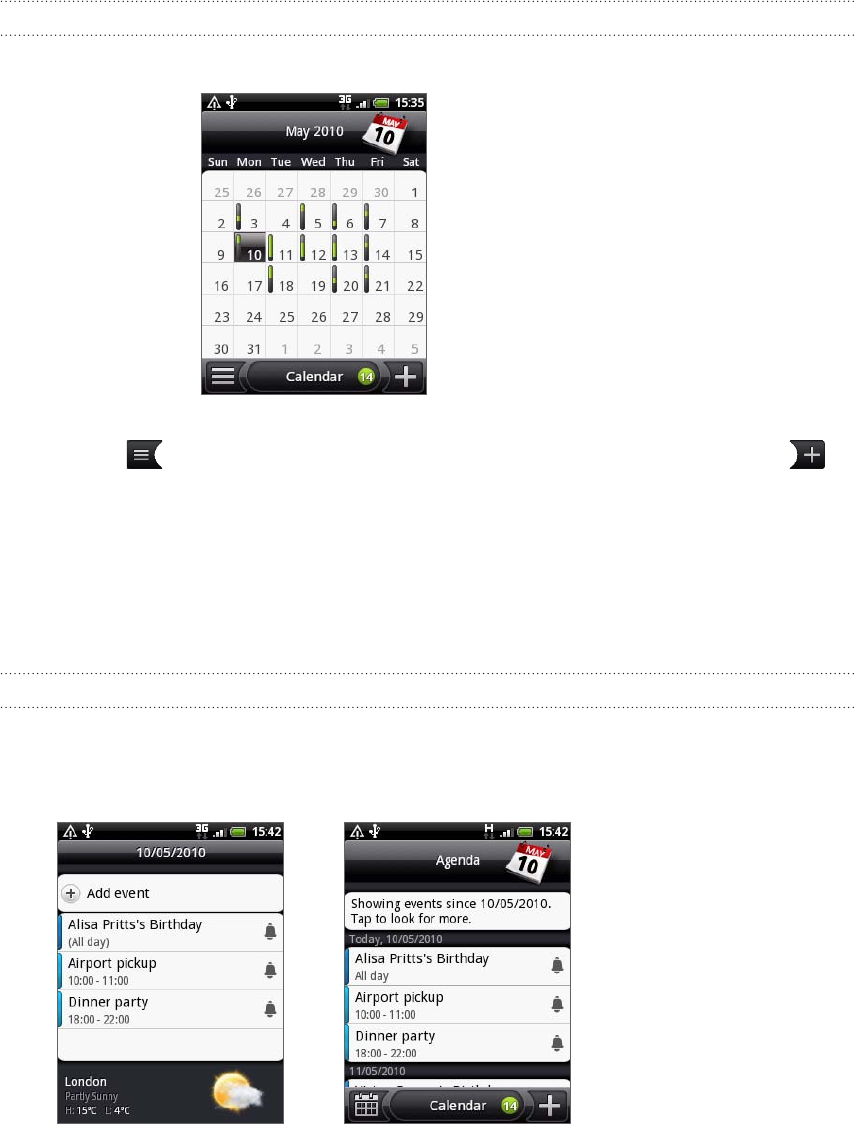
103 Calendar
Changing calendar views
When you open Calendar, it displays the Month view by default. You can also display
the Calendar in Agenda, Day, or Week view. To change between calendar views, press
MENU, and then choose the type of view that you want.
Month view
In Month view, you’ll see markers on days that have events.
When in Month view:
Tap on the bottom left of the screen to switch to Agenda view. Tap
on the bottom right to create a new event.
Tap a day to view the events of that day.
Press and hold a day to open an options menu from which you can also
choose to create an event or switch to either Day or Agenda view.
Slide your finger up or down the screen to view earlier or later months.
Day and Agenda views
Day view displays a list of the events of one day and also shows weather information
at the bottom of the screen when you’re viewing events of the current day. Agenda
view shows a list of all your events in chronological order.
The color bars on the left side of the events indicate the type of calendar in which
the event is part of. To find out what each color represents, press MENU and then tap
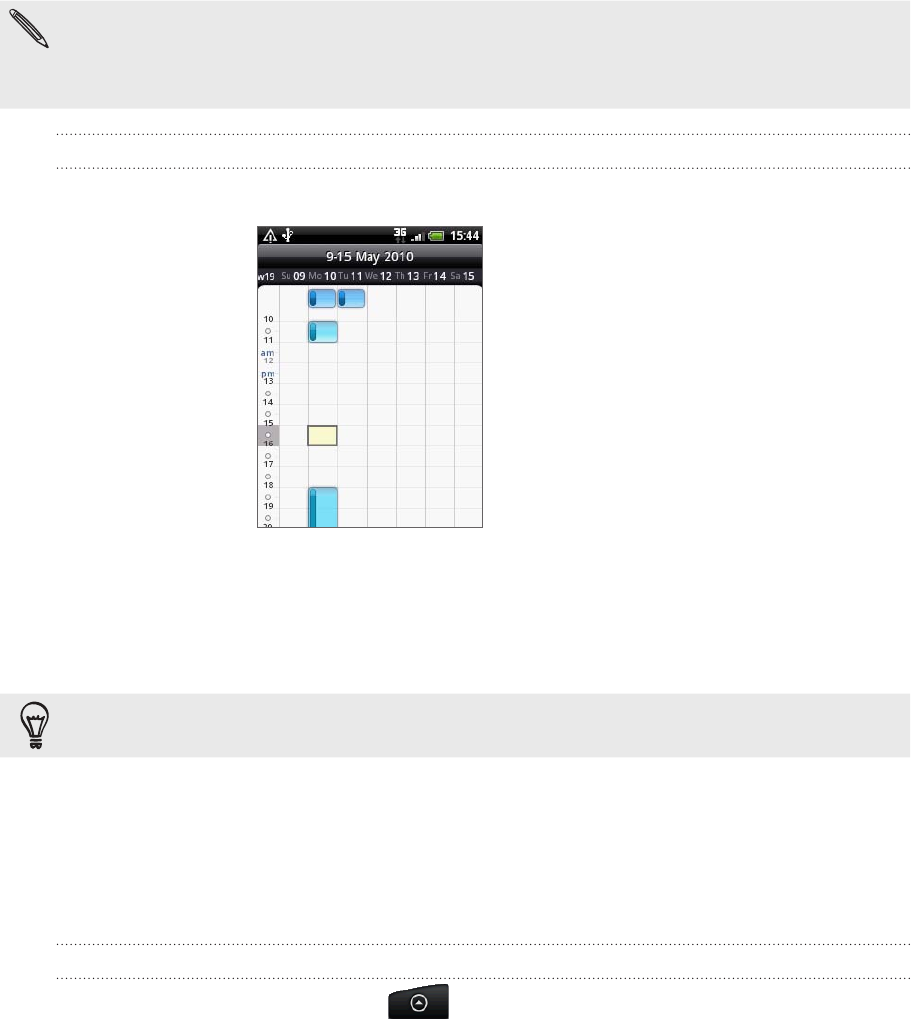
104 Calendar
More > Calendars.
When in Day view, slide left or right across the screen to view earlier or later days.
In Day view, the weather information appears only if the event is within the five-day forecast
of the Weather application.
Weather information does not appear in Day view when you change Day view to display as
a time list. See “Changing Calendar settings” for details.
Week view
Week view displays a chart of the events of one week.
When in Week view:
You can press and hold on a time slot to create a new event at that time.
Tap an event to view its details.
Slide left or right across the screen to view earlier or later weeks.
In a crowded Week view, it may be easier to select an event by using the optical trackball.
Then press the optical trackball to view details about the selected event.
Viewing, editing or deleting an event
You can view, edit, or delete events you created. You can also view event invitations
that other people sent to you.
Viewing and editing an event
1. From the Home screen, tap , and then tap Calendar.
2. In Month view, tap the day when the event takes place, and then tap the event to
open it.
The Event details screen then opens and shows the summary of the event.
3. When viewing the event summary, you can do the following:
Find the event’s location in Maps.
If it’s a Google Calendar or Exchange ActiveSync calendar event, check the
participants of the event.

105 Calendar
Tap the reminder time to change it.
If it’s a Google Calendar event, respond whether you’ll attend the event.
Press the BACK button on your phone to save changes you made on the
Event details screen.
4. To edit more details about the event, press and hold the event, and then tap Edit
event.
5. Make your changes to the event.
6. When you’re done editing, scroll down to the bottom of the screen and then tap
Save.
Deleting an event
There are a number of ways to delete an event.
While viewing the summary of an event on the Event details screen, press
MENU and then tap Delete event.
In Day, Agenda or Week view, press and hold an event and then tap Delete
event.
When editing an event, scroll down to the bottom of screen and then tap
Delete.
If the event repeats, you’ll be asked whether you want to delete just that
occurrence, this and all future occurrences, or all past and future occurrences in
your Calendar.
Calendar event reminders
If you have set at least one reminder for an event, the upcoming event icon will
appear in the notifications area of the status bar to remind you of the upcoming event.
Viewing, dismissing, or snoozing event reminders
1. Tap the status bar, then slide your finger down the screen to open the
Notifications panel.
2. Do one of the following:
Tap Clear to dismiss event reminders and all other notifications. Other types
of notifications such as new messages and missed calls will also be deleted.
After sliding open the Notifications panel, tap the calendar event reminder.
You’ll then see a list of all pending event reminders. Tap Snooze all to
snooze all event reminders for five minutes, or tap Dismiss all to dismiss all
event reminders.
Press BACK to keep the reminders pending in the notifications area of the
status bar.

106 Calendar
Displaying and synchronizing calendars
You can select which calendars to show or hide on your phone’s Calendar, and which
ones to keep synchronized.
Showing or hiding calendars
In any Calendar view, press MENU , tap More > Calendars, and then select or clear a
calendar to show or hide it. Tap All calendars to display all calendars.
The calendars are kept synchronized on your phone, whether or not you hide them.
Choosing which Google Calendars are synchronized on your phone
You can choose which Google Calendars to keep synchronized on your phone or
which ones to stop synchronizing.
Stop synchronizing a Google Calendar
In any Calendar view, press MENU and then tap More > Calendars.
Press MENU again and then tap Remove calendars.
Select a Google Calendar to remove from your calendars list, and then tap OK.
Press BACK to update Calendar with the new changes and return to the
Calendar view you were viewing.
The calendars that you remove from your calendars list will no longer be synchronized
on your phone, but you remain subscribed to them and can work with them in Google
Calendar on the Web.
Adding a Google Calendar to sync with
Only the calendars that you’ve created or subscribed to on the Web, but previously
removed from your calendars list, are shown in the list of calendars that you can add.
In any Calendar view, press MENU and then tap More > Calendars.
Press MENU again and then tap Add calendars.
Select a Google Calendar to add to your calendars list, and then tap OK.
Press BACK to update Calendar with the new changes and return to the
Calendar view you were viewing.
1.
2.
3.
4.
1.
2.
3.
4.

107 Calendar
Changing Calendar settings
You can change Calendar’s settings to specify how it displays events and how it
notifies you of upcoming events. In any Calendar view, press MENU and then tap More
> Settings to access Calendar’s settings.
Reminder settings
Choose how you want Calendar to issue event reminders when there are upcoming
events.
All calendars Select this check box to use the same event reminder settings
for all types of calendars. If you clear this check box, you can
set different reminder settings for each calendar.
Set alerts & notifications Configure event reminders to open an alert, send you a
notification, or turn off event notifications on your phone.
Default reminder time Choose how soon before an event you want to be notified.
Select ringtone Choose a ringtone to sound when you receive an event
reminder.
Vibrate Choose whether you want your phone to vibrate when you
receive an event notification.
Hide declined events Choose whether to show or hide events to which you’ve
declined invitations.
Calendar view settings
Choose what appears in Calendar when opened and what’s shown in Day, Week, and
Month views.
Start in Choose the default Calendar view that is displayed when you
open Calendar.
Day views Choose whether to display Day view in the form of an event
list or time list.
First day of week Set the Month and Week views to start on a Sunday or
Monday.
Include weather Make sure this check box is selected so that weather
information is shown in Day view’s event list.
City By default, Day view displays your current location’s weather.
You can change it to display the weather of another city.
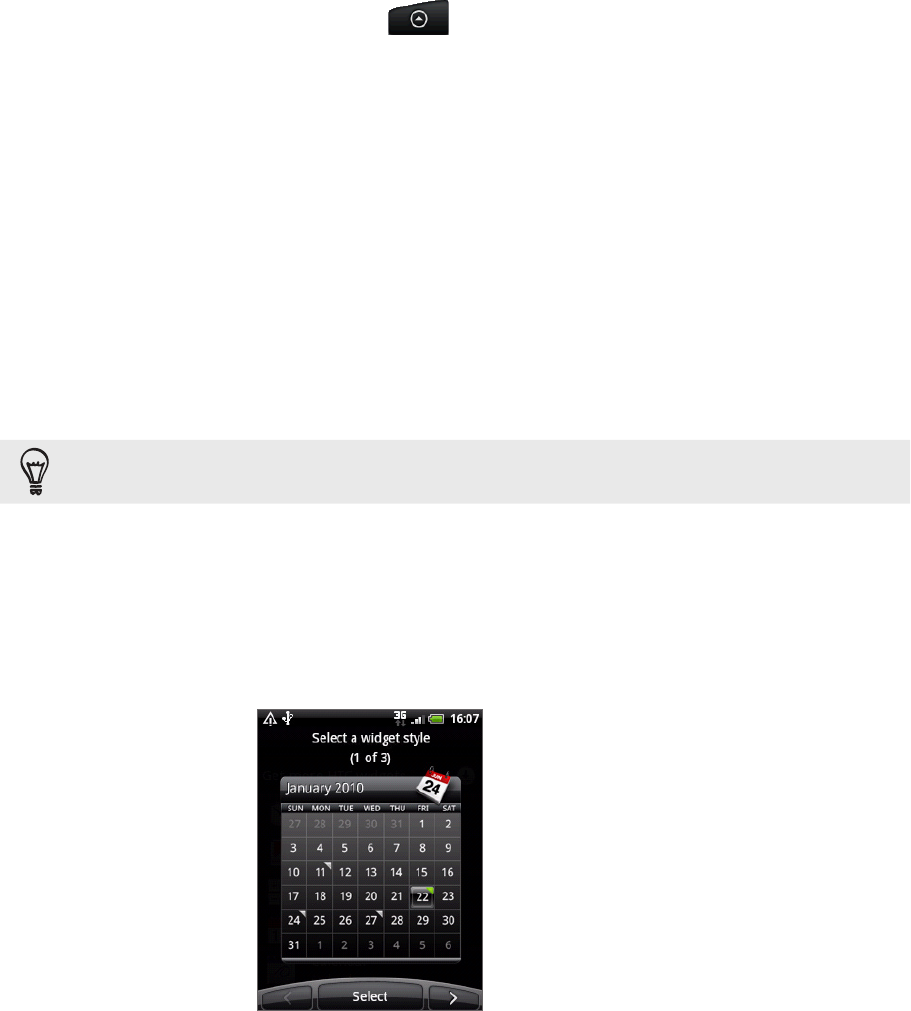
108 Calendar
Sending a vCalendar
You can send a calendar event as a vCalendar to someone’s phone or your computer
using Bluetooth. You can also send it as a file attachment with your message.
From the Home screen, tap , and then tap Calendar.
In Month view, tap the day when the event takes place.
Press and hold the calendar event you want to send, and then tap Share
vCalendar.
Choose whether to send the event using Bluetooth or send it by email.
If you chose to send using Bluetooth, in the next few steps, you’ll be asked to
turn on Bluetooth on your phone and connect to the receiving Bluetooth device
so the vCalendar can be sent. Follow the steps in “Sending information using
Bluetooth” in the Bluetooth chapter.
If you chose to send by email, a new message window opens and automatically
includes the vCalendar as an attachment. Your default email account that’s
selected in the Mail application will be used to send. For more information about
using the Mail application, see the Email chapter.
You can also choose to send the vCalendar in a multimedia message. For more information
about sending a multimedia message, see the Messages chapter.
About the Calendar widget
There’s a Calendar widget available that you can add to your Home screen, and it
comes in different calendar views. Tapping a day or event on the widget brings you to
the Calendar application.
To find out how you can add a widget, see “Personalizing your Home screen with
widgets” in the Personalizing chapter.
1.
2.
3.
4.
5.
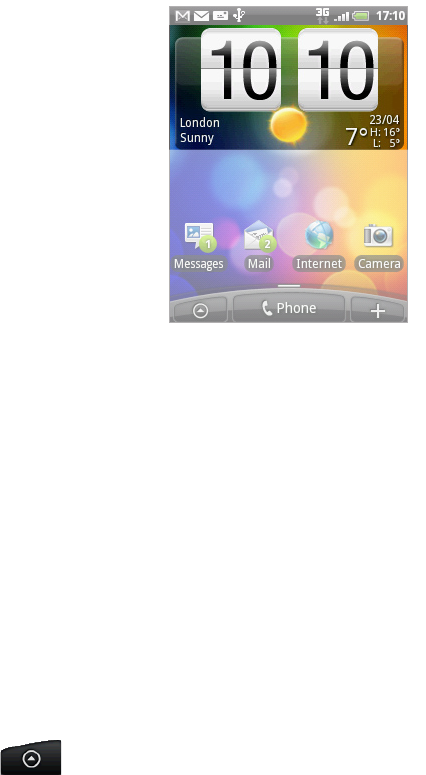
109 Clock and Weather
Clock and Weather
About the HTC Clock widget
The HTC Clock widget that’s by default
added on the Home screen shows your
current date, time, and location. You can tap
the weather image on this widget to open
the Weather application and check for more
weather forecasts. See “Checking weather”
for details.
The HTC Clock widget comes in a variety
of looks and designs. You can add another
clock widget to the extended Home screen,
if you want to have another clock that shows
the time of another city. To find out how
you can add a widget, see “Personalizing
your Home screen with widgets” in the
Personalizing chapter.
About the Clock application
The Clock application is more than just a regular date and time clock. It functions as
a desk clock that shows the date, time, and weather information, and it can turn into
a night clock or screensaver. It has a world clock that shows you the current time
in several locations across the globe. There’s also an alarm clock, stopwatch, and
countdown timer.
To open the Clock application, you can:
Tap the HTC Clock widget on the Home screen.
From the Home screen, tap , and then tap Clock.
Tap the tabs at the bottom row or slide your finger across the tabs to switch between
the different functions of the Clock application.
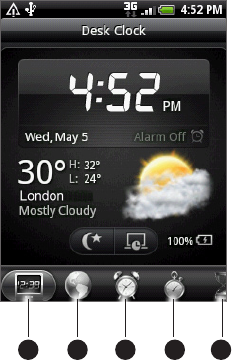
110 Clock and Weather
2 3 451
1 Desk Clock tab
2 World Clock tab
3 Alarm Clock tab
4 Stopwatch tab
5 Timer tab
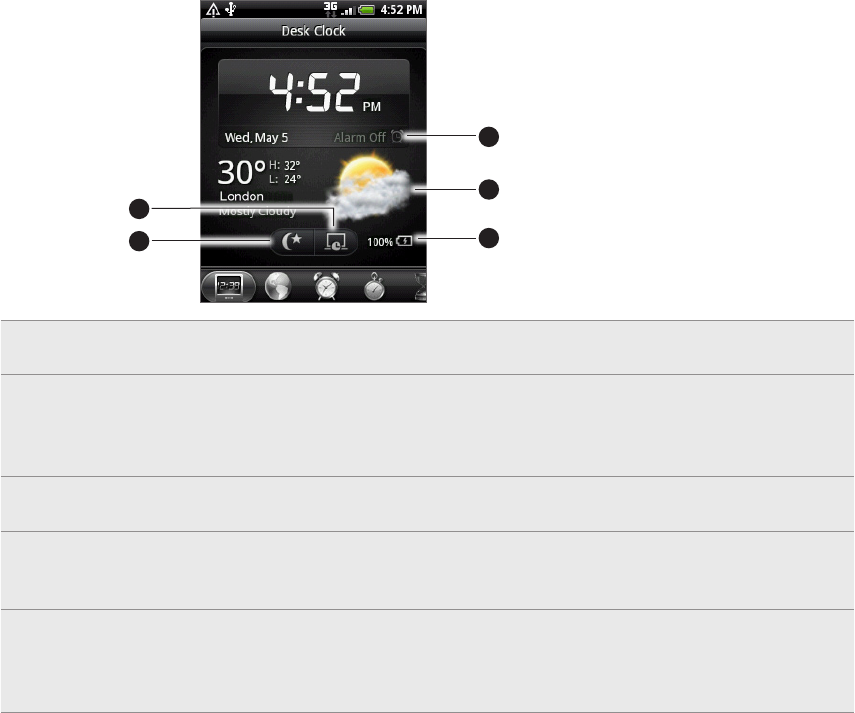
111 Clock and Weather
Using Desk Clock
Opening the Clock application brings you directly to the Desk Clock screen.
The Desk Clock displays the current date, time, and weather, an alarm clock indicator,
and a battery charging indicator. You can dim the screen to show only the time and
date on the Desk Clock.
2
3
4
5
1
1 The alarm clock indicator shows whether the alarm clock is on or off. To find out how to
turn on and set the alarm clock, see “Setting the alarm clock.”
2 Below the date and time, you’ll see the weather information of your current location.
Tapping the weather information brings you to the Weather application where you can
see weather forecasts of the next few days. See “Checking weather” for more information
about the Weather application.
3 The battery charging indicator shows the battery charge level. You’ll see it only when your
phone is plugged with the power adapter or connected to your computer.
4 Tap this button to dim the screen and display only the time and date on the Desk Clock. To
light up the screen again, tap anywhere on the screen or press the BACK button on your
phone.
5 Tap this button to dim the screen and go into screensaver mode. When in screensaver
mode, the time and date will change position on the screen after every few minutes. To
light up the screen again, tap anywhere on the screen or press the BACK button on your
phone.
You can change the Desk Clock screen to display the date and time of another time
zone. To find out how to select a different time zone, see “Setting the time zone, date,
and time.”

112 Clock and Weather
Using World Clock
Use the Clock application’s World Clock screen to check
the current time in several places around the globe
simultaneously. You can also set your home city, add more
cities to the world clock list, and manually set your time
zone, date, and time.
Setting your home city
Tap the HTC Clock widget on the Home screen.
Tap the World Clock tab.
Press MENU and then tap Home settings.
Enter your home city’s name. As you enter letters, the list is filtered to show
matching cities and countries.
Scroll through the list and tap your home city.
Setting the time zone, date, and time
To set the time zone, date, and time on your phone manually, you need to turn off auto
time synchronization first.
Tap the HTC Clock widget on the Home screen.
Tap the World Clock tab.
Press MENU and then tap Local time settings to open the Date & time settings
screen.
Clear the Automatic check box.
Tap Select time zone. Scroll through the list and then tap the time zone that you
want.
To change the date, tap Set date. Adjust the date by rolling the day, month, and
year scroll wheels onscreen and then tap OK.
To change the time, tap Set time. Adjust the time by rolling the hour and minute
scroll wheels onscreen and then tap OK.
Tap the Use 24-hour format check box to toggle between using a 12-hour or a
24-hour time format.
Tap Select date format then select how you want dates to be displayed. (The
selected date format also applies to the date displayed in the alarm clock.)
1.
2.
3.
4.
5.
1.
2.
3.
4.
5.
6.
7.
8.
9.
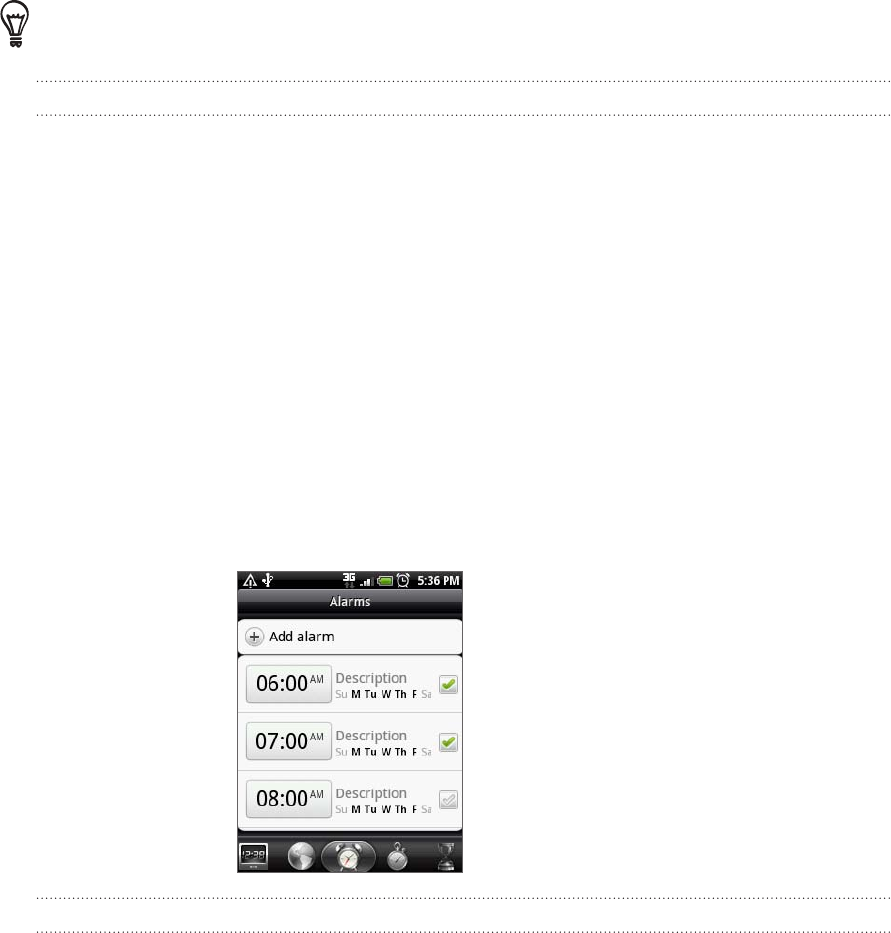
113 Clock and Weather
From the Home screen, you can also press MENU and then tap Settings > Date & time to open
the Date & time settings screen.
Adding a city to the World Clock screen
Add more cities to the World Clock screen so you can instantly check the date and
time in these cities. In addition to the current and home cities, the World Clock screen
can display up to 15 cities.
Tap the HTC Clock widget on the Home screen.
Tap the World Clock tab.
Tap Add city. Enter the city name you want to add. As you enter letters, the list
is filtered to show matching cities and countries.
Scroll through the matching list and tap the city that you want to add.
Setting the alarm clock
You can use the Clock application’s Alarms screen to set up one or more wake-up
alarms.
Setting an alarm
1. Tap the HTC Clock widget on the Home screen.
2. Tap the Alarms tab.
3. Select the check box of an alarm. and then tap that alarm.
4. On the Set alarm screen, drag your finger up or down to roll the time scroll
wheels and set the alarm time.
5. Scroll through the Set alarms screen to see all the available alarm options. You
can:
Enter the alarm Description and choose the Alarm sound to use.
Tap Repeat. Select what days of the week to sound the alarm and then tap
OK.
Select the Vibrate check box if you want your phone to also vibrate when
the alarm goes off.
1.
2.
3.
4.

114 Clock and Weather
6. When you’ve finished setting the alarm, tap Done.
To turn off an alarm, clear the check box (by tapping it) of that alarm.
If you need to set more than three alarms, press MENU while you’re on the Alarms screen
and then tap Add alarm.
Deleting an alarm
Tap the HTC Clock widget on the Home screen.
Tap the Alarms tab.
On the Alarms screen, press MENU and then tap Delete.
Select the alarms you want to delete and then tap Delete.
Changing alarm sound settings
If you’ve set one or more alarms, you can change their settings such as the alarm
volume, how long to snooze the alarm, and more.
Tap the HTC Clock widget on the Home screen.
Tap the Alarms tab.
On the Alarms screen, press MENU and then tap Settings. You can change the
following settings:
Alarm in silent mode This option is selected by default, which allows the alarm
to sound even when your phone’s volume is set to silent
mode. Clear this check box if you want to silence the alarm
when the volume is in silent mode.
Alarm volume Set the volume level that you want for the alarm.
Snooze duration Set how long to snooze between alarms.
Side button behavior Choose what happens to the alarm when pressing the side
button (VOLUME UP/DOWN) of your phone. You can set
the button to snooze, dismiss the alarm, or disable the
button.
The side button works only when the phone’s screen is not
locked. While on the lock screen, tap the onscreen Snooze
button to snooze, or slide down the screen to dismiss the
alarm.
1.
2.
3.
4.
1.
2.
3.
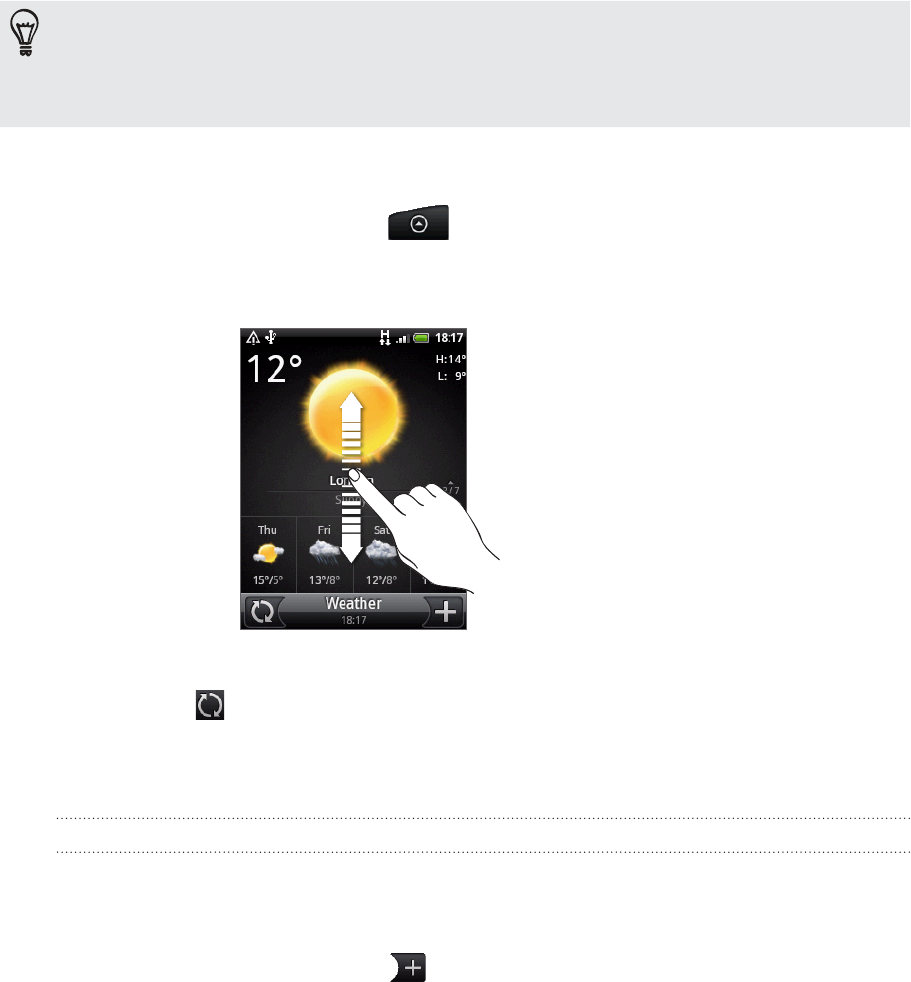
115 Clock and Weather
Checking weather
If you consented to turn location service on when you were setting up your phone for
the first time, you’ll see the weather of your current location right on the HTC Clock
widget of your Home screen.
You can also use the Weather application to check the current weather and weather
forecasts for the next four days of the week. In addition to your current location’s
weather, this application also displays the weather forecasts of other cities around the
globe.
If you declined to turn location service on during first-time setup of your phone, turn location
service on in your phone’s settings so that you’ll be able to check your current location’s
weather on the HTC Clock widget, Weather application, and the Weather widget. From the
Home screen, press MENU, tap Settings > Location, and then select the Use wireless networks
check box.
1. Connect to the Internet using your phone’s Wi-Fi or data connection. To find out
how, see the Internet connections chapter.
2. From the Home screen, tap , and then tap Weather.
3. On the Weather screen, you’ll first see your current location’s weather. To check
the weather in other cities, swipe your finger up or down the screen.
4. The Weather application automatically downloads and displays the latest
weather updates. You can also download the most recent weather anytime by
tapping .
5. To see more weather details on the Web, tap Weather at the bottom center of
the Weather screen.
Adding a city to the Weather screen
Add more cities to the Weather screen so you can instantly check the weather
forecasts in these cities. In addition to your current location, the Weather screen can
display up to 15 cities.
On the Weather screen, tap .
Enter the location you want to add on the text field. As you enter text, the list is
filtered to show the possible locations based on the letters you entered.
Tap the desired city to select it.
1.
2.
3.
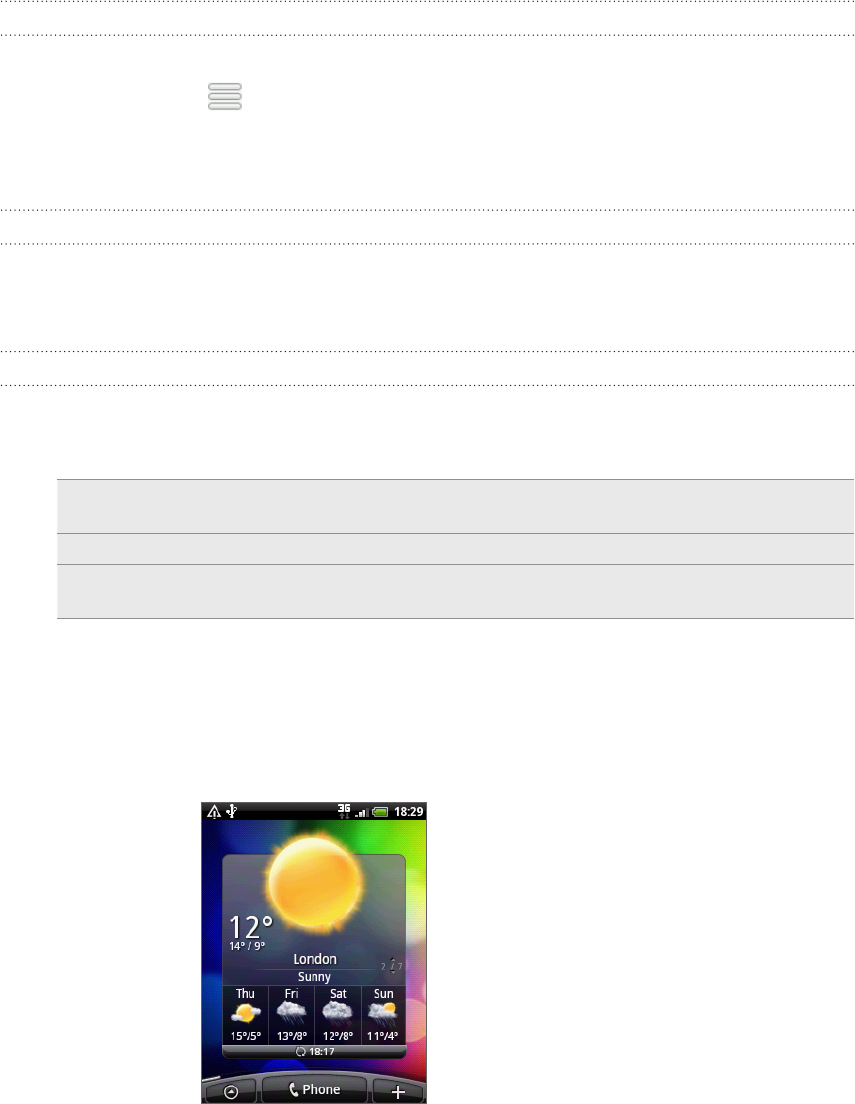
116 Clock and Weather
Changing the order of cities on the Weather screen
On the Weather screen, press MENU and then tap Rearrange.
Press and hold at the end of the item you want to move. When the row is
highlighted in green, drag it to its new position, then release.
Tap Done.
Deleting cities from the Weather screen
On the Weather screen, press MENU and then tap Delete.
Select the cities you want to remove and then tap Delete.
Changing weather options
On the Weather screen, press MENU and then tap Settings.
You can change the following weather settings:
Update automatically Select this check box to automatically download weather
updates.
Update schedule Set an auto update schedule.
Temperature scale Choose whether to display weather in Celsius or
Fahrenheit.
About the Weather widget
Use the Weather widget to instantly check weather forecasts of your current location
and other cities without having to open the Weather application.
The Weather widget comes in different looks and styles. You can add this widget
to the Home screen, if it’s not yet added. To find out how you can add a widget, see
“Personalizing your Home screen with widgets” in the Personalizing chapter.
1.
2.
3.
1.
2.
1.
2.

117 Internet connections
Internet connections
Data connection
Your phone will be automatically configured to use your mobile operator’s data
connection when you turn on your phone for the first time.
Checking the data connection you are using
From the Home screen, press MENU, and then tap Settings > Wireless &
networks.
Tap Mobile networks > Network operators or Access Point Names.
Turning the data connection on or off
Turning your data connection off can help optimize your battery life. It can also save
money on data charges. However, when your data connection is turned off, you may
not always receive automatic updates to your email, social network accounts, and
other synchronized information.
Press and hold the POWER button..
Scroll down the Phone options menu.
Tap Mobile network.
Creating a new access point
When you need to add another data connection on your phone, obtain the access
point name and settings (including username and password if required) from your
mobile operator.
From the Home screen, press MENU, and then tappress MENU, and then tap Settings > Wireless &
networks.
Tap Mobile networks > Access Point Names.
On the APNs screen, press MENU and then tap New APN.
On the Edit access point screen, enter the APN settings. Tap the APN setting
item to edit it.
Press MENU and then tap Save.
Enabling data roaming
Data roaming lets you connect to your mobile operator’s partner networks and access
data services when you are out of your mobile operator’s coverage area.
1.
2.
1.
2.
3.
1.
2.
3.
4.
5.

118 Internet connections
Accessing data services while roaming may incur significant charges. Inquire about the data
roaming tariffs with your mobile operator before enabling data roaming.
From the Home screen, press MENU, and then tappress MENU, and then tap Settings > Wireless &
networks.
Tap Mobile networks, and then select the Data roaming check box.
You can also select the Data roaming sound check box, if you’d like your phone
to play a sound so you’ll know when it is connecting to a roaming network.
1.
2.

119 Internet connections
Wi-Fi
Wi-Fi provides wireless Internet access over distances of up to 100 meters (300 feet).
To use Wi-Fi on your phone, you need access to a wireless access point or “hotspot”.
The availability and range of the Wi-Fi signal depends on the number, infrastructure,
and other objects through which the signal passes.
Turning Wi-Fi on and connecting to a wireless network
From the Home screen, press MENU, and then tap Settings > Wireless &
networks.
Select the Wi-Fi check box to turn Wi-Fi on. The phone then scans for available
wireless networks.
Tap Wi-Fi settings. The network names and security settings of detected Wi-Fi
networks are displayed in the Wi-Fi networks section.
If the wireless network you want to connect to is not in the list of detected
networks, scroll down the screen, and then tap Add Wi-Fi network. Enter the
wireless network settings, and then tap Save.
Tap the Wi-Fi network you want to connect to.
If you selected an open network, you will be automatically connected to the
network.
If you selected a network that is secured with WEP, enter the key and then
tap Connect.
Depending on the network type and its security settings, you may also need to enter more
information or choose a security certificate.
When your phone is connected to a wireless network, the Wi-Fi icon appears in the
status bar and tells you the approximate signal strength (number of bands that light
up).
The next time your phone connects to a previously accessed secured wireless network,
you will not be prompted to enter the key or other security information again, unless
you reset your phone to its factory default settings.
Connecting to a Wi-Fi network with EAP-TLS security
You may need to install a network certificate (*.p12) to your phone before you can
connect to a Wi-Fi network with EAP-TLS authentication protocol.
Save the certificate file to the root folder of the storage card.
From the Home screen, press MENU, and then tap Settings > Security.
Tap Install from SD card.
Select the network certificate needed to connect to the EAP-TLS network.
Follow the steps in the previous section to connect to the Wi-Fi network.
1.
2.
3.
4.
5.
1.
2.
3.
4.
5.
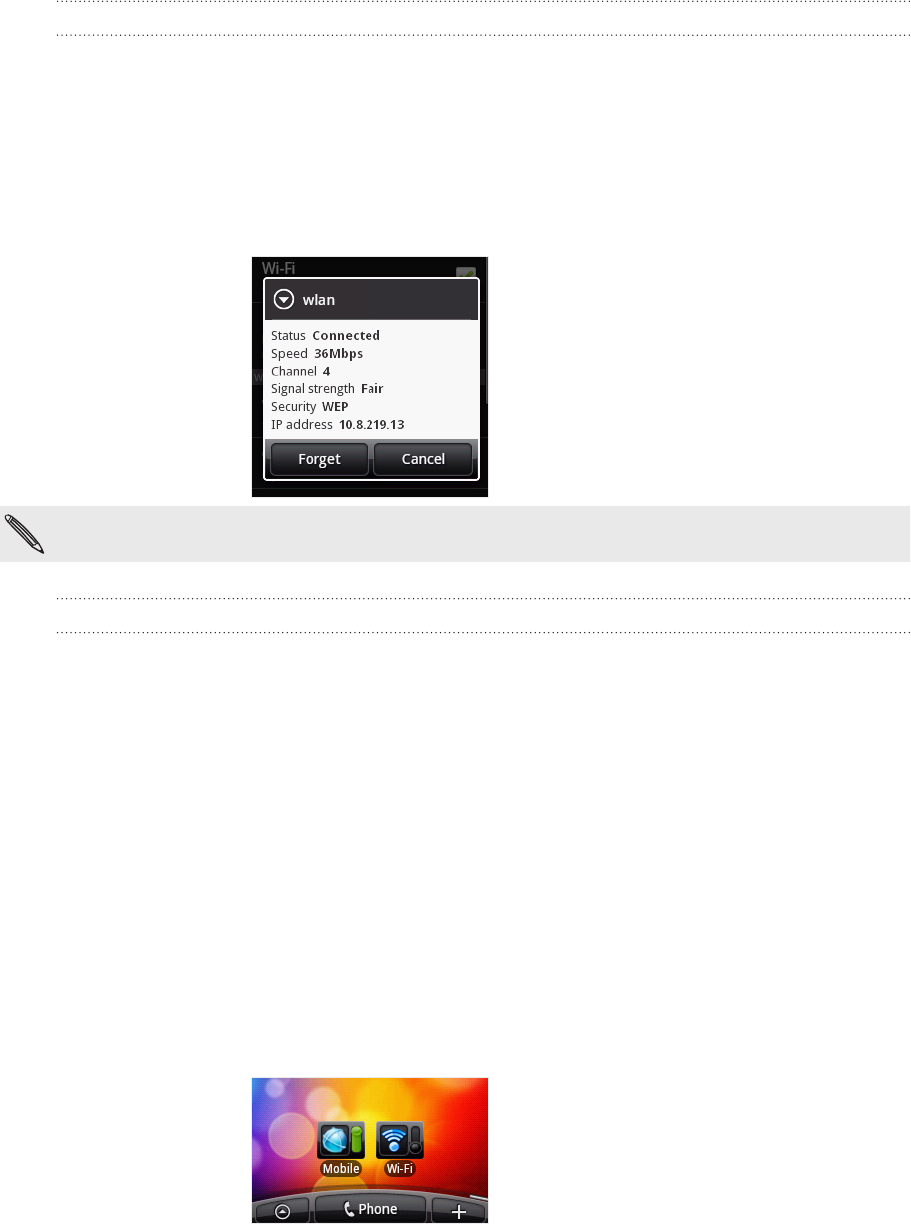
120 Internet connections
Checking the wireless network status
From the Home screen, press MENU, and then tap Settings > Wireless &
networks.
On the Wireless & networks screen, tap Wi-Fi settings, and then tap the wireless
network that the phone is currently connected to.
A message box is then displayed showing the Wi-Fi network name, status, speed,
signal strength, and more.
If you want to remove the wireless network settings on your phone, tap Forget on this box.
You will need to enter the settings again if you want to connect to this wireless network.
Connecting to another Wi-Fi network
From the Home screen, press MENU, and then tap Settings > Wireless &
networks.
Tap Wi-Fi settings. Detected Wi-Fi networks are displayed in the Wi-Fi networks
section.
To manually scan for available Wi-Fi networks, on the Wi-Fi settings screen,
press MENU and then tap Scan.
4. Tap another Wi-Fi network to connect to it.
Using the Data connection and Wi-Fi widgets
Add the Mobile Network and/or Wi-Fi widget to the Home screen to make it faster
for you to turn on or off these connections. Tap the widget to turn on or off the
connection.
To find out how to add widgets, see “Personalizing your Home screen with widgets” in
the Personalizing chapter.
1.
2.
1.
2.
3.

121 Internet connections
Connecting to a virtual private network (VPN)
From your phone, you can add, set up, and manage virtual private networks (VPNs)
that allow you to connect and access resources inside a secured local network, such as
your corporate network.
Depending on the type of VPN you are using at work, you may be required to enter
your login credentials and/or install security certificates before you can connect
to your company’s local network. You can get this information from your network
administrator.
Also, your phone must first establish a Wi-Fi or data connection before you can initiate
a VPN connection. For information about setting up and using these connections on
your phone, see “Data connection” and “Wi-Fi” in this chapter.
Setting up secure credential storage
If your network administrator instructs you to download and install security
certificates, you must first set up the phone’s secure credential storage.
From the Home screen, press MENU, tap Settings > Security, and then tap Set
password.
Enter a new password for the credential storage (at least 8 characters without
any spaces).
Scroll down and confirm the password, and then tap OK.
Select the Use secure credentials check box.
You can then download and install the certificates needed to access your local
network. Your network administrator can tell you how to do this.
Adding a VPN connection
From the Home screen, press MENU, and then tappress MENU, and then tap Settings > Wireless &
networks >
VPN settings.
Tap Add VPN, and then tap the type of VPN you want to add.
Tap the VPN settings and set them up according to the security details you have
obtained from your network administrator.
Press MENU, and then tap Save.
The VPN is then added to the VPNs section of the VPN settings screen.
Connecting to a VPN
From the Home screen, press MENU, and then tapress MENU, and then tap Settings > Wireless &
networks >
VPN settings.
In the VPNs section, tap the VPN that you want to connect to.
When prompted, enter your log in credentials, and then tap Connect.
1.
2.
3.
4.
1.
2.
3.
4.
1.
2.
3.

122 Internet connections
When you are connected, the VPN connected icon appears in the notification
area of the title bar.
You can then open the web browser to access resources such as intranet sites on your
corporate network.
Disconnecting from a VPN
Press and hold the title bar, and then slide down your finger to open the
Notifications panel.
Tap the VPN connection to return to the VPN settings screen, and then tap the
VPN connection to disconnect from it.
When your phone has disconnected from the VPN, the VPN disconnected icon is
displayed in the notification area of the title bar.
Using your phone as a modem (tethering)
Get online with your notebook or desktop computer at any time, using your phone’s
data connection.
To find out how to set up and use the data connection, see “Data connection” earlier in
this chapter.
Before you can use your phone as a modem, be sure to copy first HTCDriver.exe from
your phone’s microSD card to your computer. To find out how to copy, see “Copying
files to or from the storage card” in the Getting started chapter. Double-click this file
and follow the onscreen instructions to install the modem driver on your computer.
Make sure your phone’s data connection is turned on. See “Turning the data
connection on or off” earlier in this chapter to learn how to turn on the phone’s
data connection.
Connect the phone to the computer using the provided USB cable.
On the Connect to PC screen, select Mobile network sharing, and then tap Done.
1.
2.
1.
2.
3.
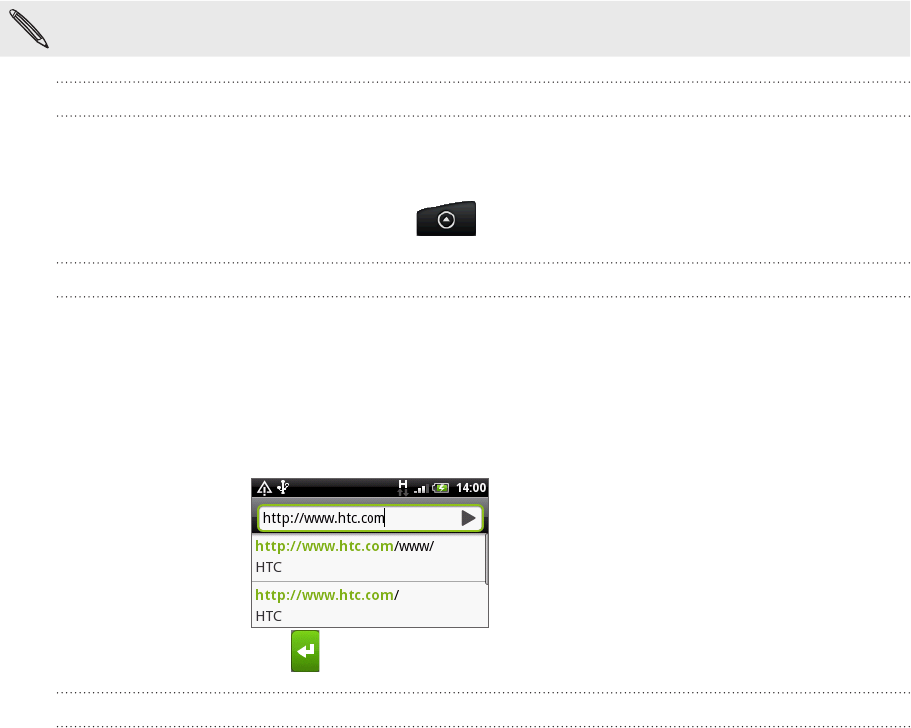
123 Web browser
Web browser
Using your phone’s web browser
Open the web browser to start surfing the web. The browser is fully optimized and
comes with advanced features that let you enjoy Internet browsing on your phone.
You must have an active data connection or Wi-Fi connection to access the Internet.
Opening the browser
Do one of the following:
On the Home screen, tap Internet.
From the Home screen, tap > Internet.
Going to a web page
On the browser screen, press MENU and then tap the URL field on top of the
screen.
2. Enter the web page address using the keyboard. As you enter the address,
matching web page addresses will appear on the screen. Tap an address to go
directly to that web page or continue entering the web page address.
3. Tap the Enter key on the onscreen keyboard.
Setting your home page
From the browser screen, press MENU, and then tap More > Settings > Set home
page.
On the Set home page screen, select the home page you want to use.
1.
1.
2.
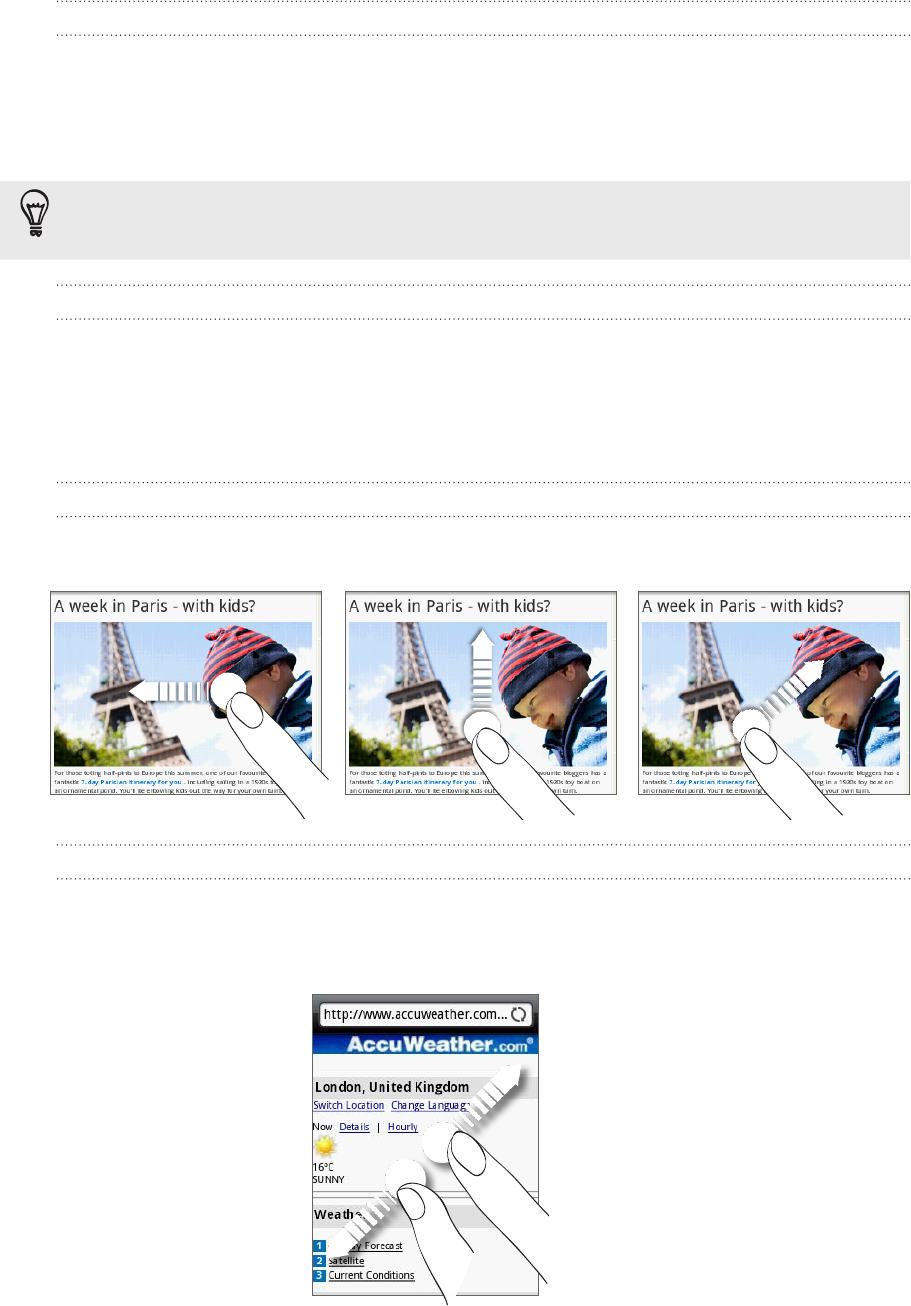
124 Web browser
Changing the screen orientation
The phone automatically changes the screen orientation depending on how you are
holding your phone.
Turn your phone sideways to the left to display the web browser in landscape
orientation.
If the screen orientation doesn’t change automatically, please switch automatic screen
orientation on. From the Home screen, press MENU, tap Settings > Sound & display, and then
select the Orientation check box.
Browsing full versions of all web sites
Some web sites display a mobile version of their pages to phone web browsers. You
can choose to view the full version of all pages, even for these sites.
From the browser screen, press MENU, tap More > Settings, and then clear the Mobile
view check box.
Navigating on a web page
You can swipe your finger on the screen or the optical trackball to navigate and view
other areas of the web page.
Zooming in or out on a web page
Tap the screen twice quickly to zoom in, then tap the screen twice quickly again to
zoom out. You can also use your fingers to pinch or spread the screen to zoom in and
out.
Spread your thumb and index finger across a
webpage to zoom in.
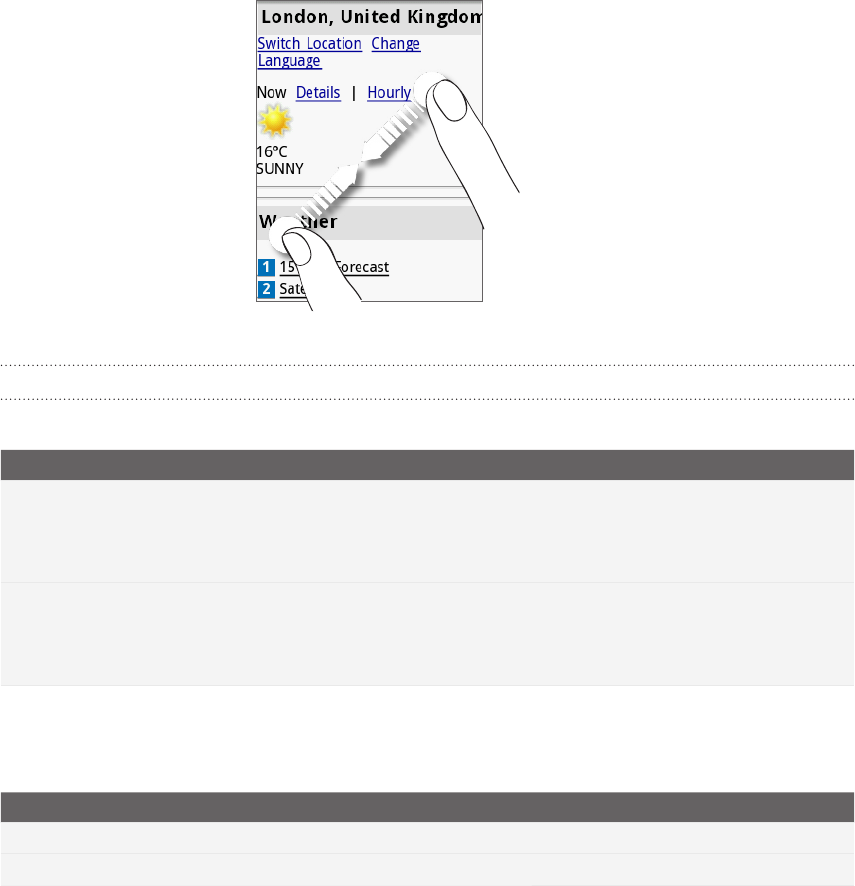
125 Web browser
Pinch your thumb and index finger on a webpage
to zoom out.
Selecting a link in a web page
You can tap a link with your finger to open it, or press and hold a link for more options.
Link What to do
Web page address
(URLs)
Tap the link to open the web page.
Press and hold the link to open a menu that allows you to open,
bookmark, copy to the clipboard, or share the link via email or your
social networks.
Email address Tap to send an email message to the email address.
Press and hold, then tap Copy on the menu to copy the email
address to the clipboard. You can paste the email address later
when creating a new contact or sending a new email message.
The browser also recognizes some phone numbers and addresses that allow you to
call the phone number or locate the address in Google Maps™. When you navigate to a
recognized phone number or address, it is highlighted.
Link What to do
Location address Tap the address to open Google Maps and locate the address.
Phone number Tap to open the phone dialer to call the phone number.
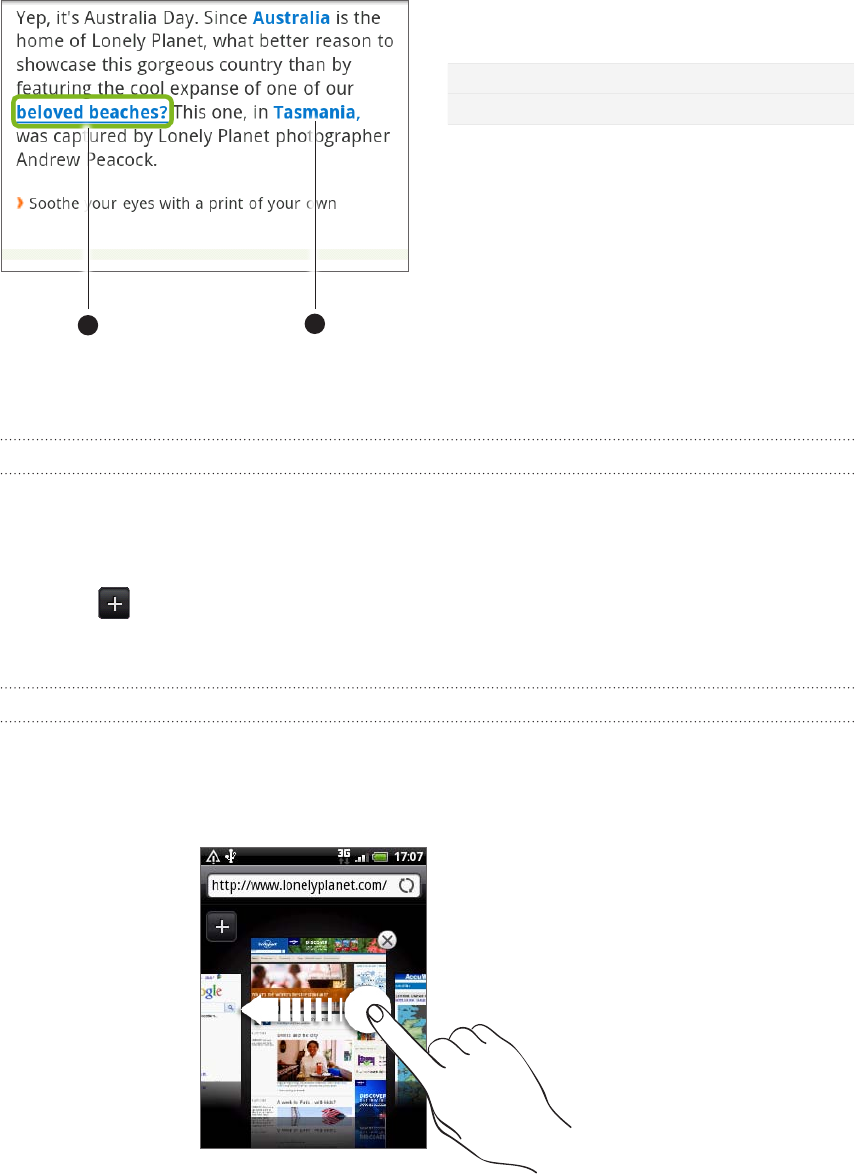
126 Web browser
You can also navigate to a link on a web page and select it using the optical trackball.
This is particularly useful when viewing text and links at a small size. Links are enclosed
in a colored box when selected.
12
1 Link is selected.
2 Link is not selected.
After selecting a link with the optical trackball, you can press the optical trackball to
open the link, or press and hold the optical trackball for more options.
Opening a new browser window
Open multiple browser windows to make it easier for you to switch from one web site
to another. You can open up to 4 browser windows.
While viewing a web page, press MENU and then tap Windows.
Tap .
A new browser window opens and goes to the home page that is set.
Switching between browser windows
While viewing a web page, press MENU and then tap Windows.
Select the browser window you want to view by sliding your finger on the screen
from right to left.
You can also do the following:
1.
2.
1.
2.
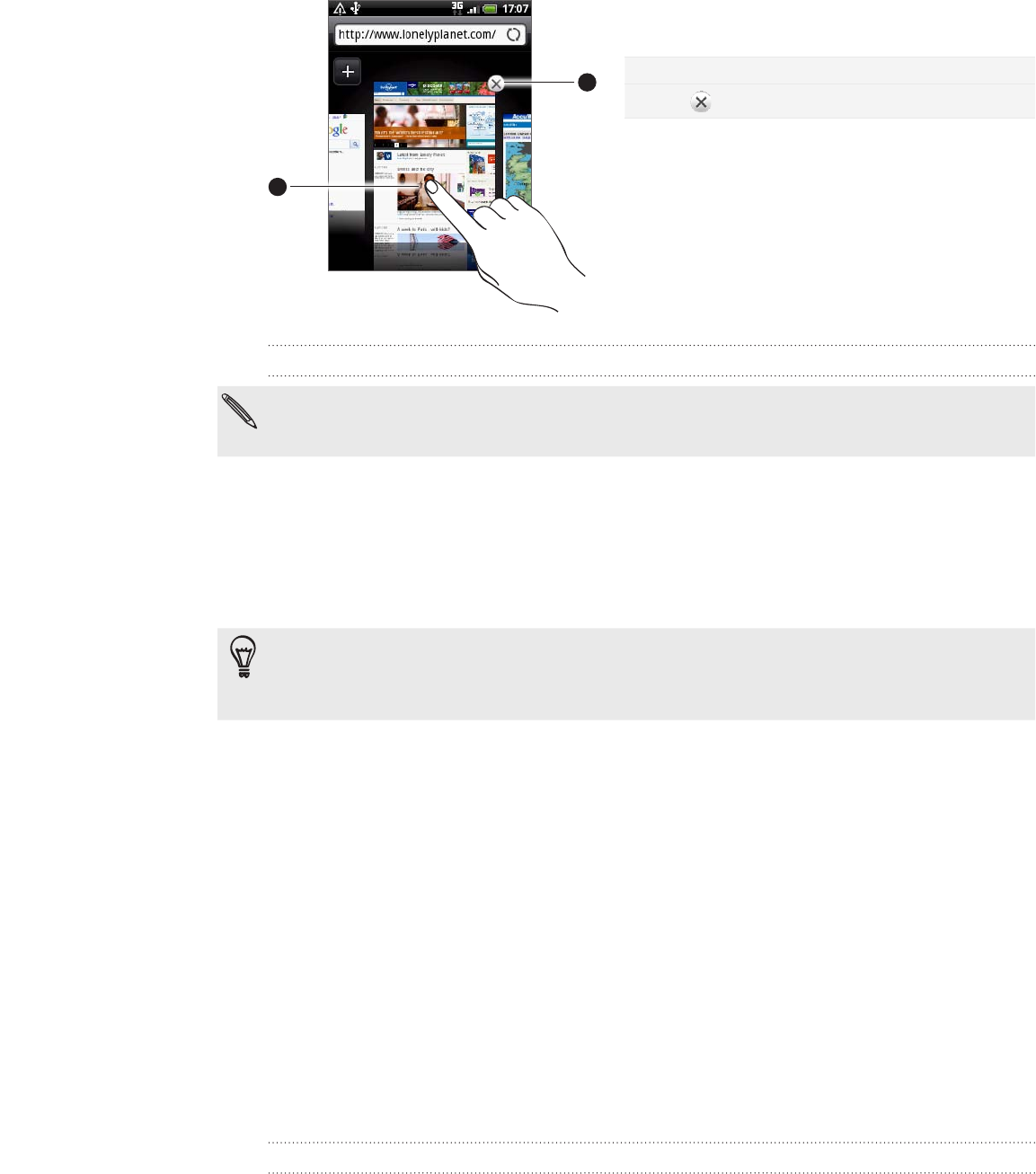
127 Web browser
1
21 Tap a web page to display it in full screen.
2 Tap to close a web page.
Downloading applications from the web
All downloaded applications are saved to the storage card. Before you download an
application from the web, make sure that you have installed a storage card on your phone. For
information on how to install a storage card, refer to the Basics chapter.
Before you can download applications from the web, you must first enable
downloading from the phone settings.
From the Home screen, press MENU, and then tap Settings > Applications.
Select the Unknown sources check box.
When the Attention dialog box opens, tap OK.
Applications downloaded from the web can be from unknown sources. To protect your phone
and personal data, download applications only from trusted sources such as Android Market.
Refer to “Finding and installing apps from Android Market” in the More apps chapter for
details.
Viewing your downloads
While viewing a web page, press MENU and then tap More > Downloads.
Copying text, looking up information, and
sharing
You can select text and then:
Copy it.
Look it up on Wikipedia or Google Dictionary.
Get a translation of the text from Google Translate.
Share the text in a new email, text, or multimedia message or in your status
update on a social network.
Finding text within a web page
While viewing a web page, press MENU and then tap More > Find on page.
1.
2.
3.
1.
You can also navigate to a link on a web page and select it using the optical trackball.
This is particularly useful when viewing text and links at a small size. Links are enclosed
in a colored box when selected.
12
1 Link is selected.
2 Link is not selected.
After selecting a link with the optical trackball, you can press the optical trackball to
open the link, or press and hold the optical trackball for more options.
Opening a new browser window
Open multiple browser windows to make it easier for you to switch from one web site
to another. You can open up to 4 browser windows.
While viewing a web page, press MENU and then tap Windows.
Tap .
A new browser window opens and goes to the home page that is set.
Switching between browser windows
While viewing a web page, press MENU and then tap Windows.
Select the browser window you want to view by sliding your finger on the screen
from right to left.
You can also do the following:
1.
2.
1.
2.
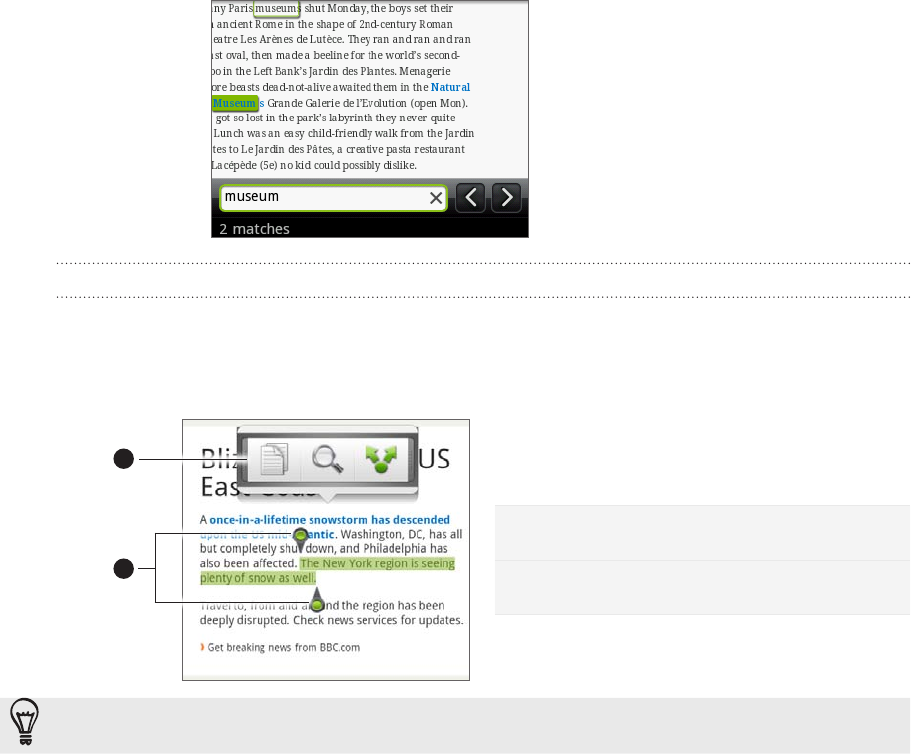
128 Web browser
Enter the search item. As you enter characters, matching characters will be
highlighted. Tap the left or right arrow to go to the previous or next matching
item.
Selecting text
1. Press and hold on a word.
2. Drag the start and end markers to highlight the surrounding text you want to
select.
1
2
1 Tap to copy, search/translate, or share the
text.
2 Start and end markers. Drag to increase
or decrease the text selection area.
To select text in a link, press and hold the link, and then tap Copy link URL.
2.
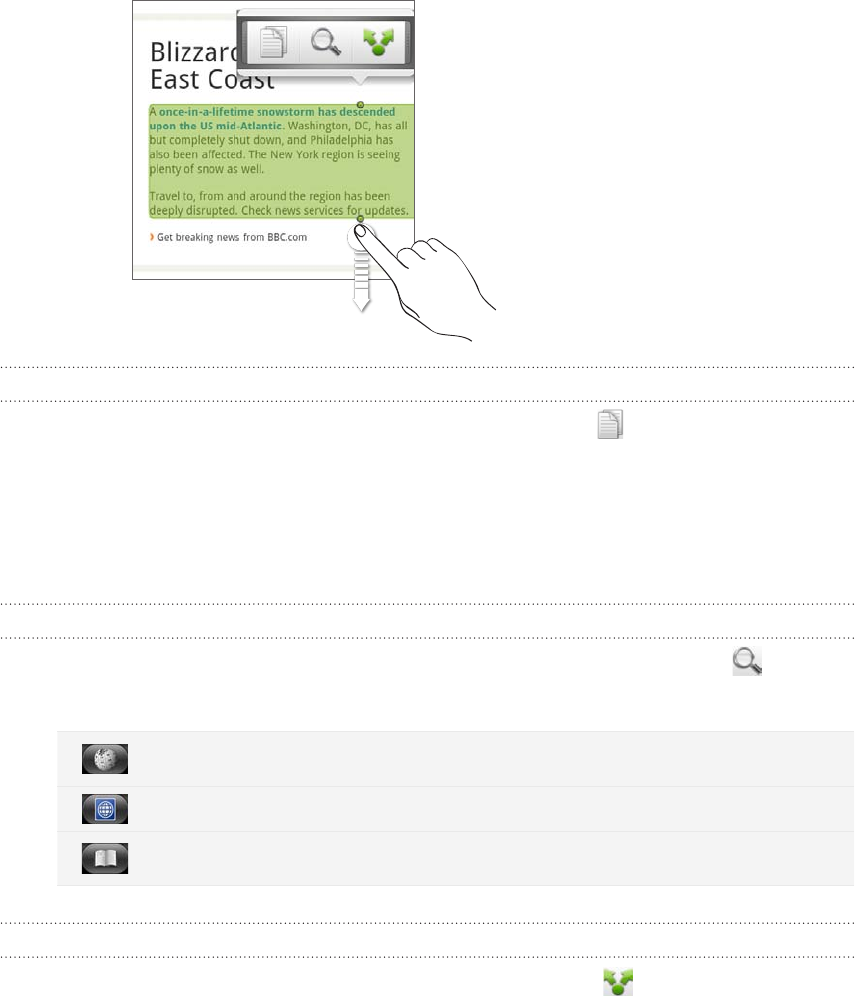
129 Web browser
When you select a larger block of text, the appearance of the markers changes.
You can drag these markers up or down to select multiple paragraphs of text.
Copying and pasting text
After you have selected the text you want to copy, tap . The selected text is
then copied to the clipboard.
In a text entry field (for example while composing a message), press and hold at
the point where you want to paste the text.
Tap Paste.
Searching or translating text
1. After you have selected the text you want to search or translate, tap .
2. Tap one of the following tabs:
Wikipedia. Look for related information on Wikipedia, based on the text that
you selected.
Google Translate. Translate the text to another language.
Google Dictionary. Look up the selected text in the dictionary.
Pasting text in a new message or social network status update
1. After you have selected the text you want to share, tap .
2. Select an option to paste the selected text in a new email, text or multimedia
message or in your status update on a social network such as Twitter. See
the Email, Messages, and Social chapters for more information on using these
features.
1.
2.
3.

130 Web browser
Viewing bookmarks and previously visited
pages
You can store as many bookmarks as you want on your phone. You can also access a
convenient History list of the sites you have visited, or quickly view the pages that you
access most often.
Bookmarking a web page
While viewing a web page, press MENU, and then tap Add bookmark. The New
bookmark screen opens.
Edit the bookmark name if needed, and then tap Done.
Opening a bookmark
Press MENU, and then tap Bookmarks.
On the Bookmarks tab , navigate to the bookmark you want to open, and
then tap it.
Editing a bookmark
Press MENU, and then tap Bookmarks.
On the Bookmarks tab , press MENU and then tap Edit.
Tap the bookmark you want to edit.
Enter your changes, and then tap Done.
Viewing a previously visited page
Press MENU, and then tap Bookmarks.
On the History tab , navigate to the page you want to view and then tap the
page.
Clearing the list of previously visited pages
Press MENU, and then tap Bookmarks.
On the History tab , press MENU, and then tap Clear history.
Viewing a page that you often visit
Press MENU, and then tap Bookmarks.
On the Most visited tab , navigate to the page you want to view, and then
tap the page.
Clearing the list of most visited pages
Press MENU, and then tap Bookmarks.
On the Most visited tab , press MENU, and then tap Clear all.
1.
2.
1.
2.
1.
2.
3.
4.
1.
2.
1.
2.
1.
2.
1.
2.

131 Web browser
Changing the view of bookmarks or most visited pages
Press MENU, and then tap Bookmarks.
On the Bookmarks tab or the Most visited tab , press MENU, and
then tap Thumbnails, List, or Grid to change the view. For example, if you are in
Thumbnails view and you want to view bookmarks in a grid, press MENU > List,
and then press MENU > Grid.
Setting browser options
Customize the web browser to suit your browsing lifestyle. Set display, privacy, and
security options when using the web browser.
From the browser screen, press MENU, and then tap More > Settings.
1.
2.

132 Bluetooth
Bluetooth
Bluetooth basics
Bluetooth is a short-range wireless communications technology that allows devices
to exchange information over a distance of about eight meters without requiring a
physical connection.
Turning Bluetooth on or off
From the Home screen, press MENU, and then tap Settings > Wireless &
networks.
Select or clear the Bluetooth check box.
An even easier way to turn Bluetooth on or off is with the Bluetooth widget or
Bluetooth setting shortcut on the Home screen. To find out how to add widgets and
shortcuts to the Home screen, see the Personalizing chapter.
Turn off Bluetooth when not in use to conserve battery power, or in places where using a
wireless device is prohibited, such as on board an aircraft and in hospitals.
Changing the phone name
The phone name identifies your phone to other devices.
From the Home screen, press MENU, and then tap Settings > Wireless &
networks > Bluetooth settings.
If the Bluetooth check box is not selected, select it to turn Bluetooth on.
Tap Device name.
Enter the name for your phone in the dialog box, and then tap OK.
Connecting a Bluetooth headset or car kit
You can listen to music over a Bluetooth stereo headset, or have hands-free
conversations using a compatible Bluetooth headset or car kit. It’s the same procedure
to set up stereo audio and hands-free.
For you to listen to music with your headset or car kit, the headset or car kit
must support the A2DP Bluetooth profile.
Before you connect your headset, you need to make it discoverable so
your phone can find it. You can find out how to do this by referring to your
headset manual.
1. From the Home screen, press MENU, and then tap Settings > Wireless &
networks > Bluetooth settings.
1.
2.
1.
2.
3.
4.

133 Bluetooth
2. If the Bluetooth check box is not selected, select it to turn Bluetooth on.
3. Make sure that the headset is discoverable.
4. Tap Scan for devices. Your phone will start to scan for Bluetooth devices within
range.
5. When you see the name of your headset displayed in the Bluetooth devices
section, tap the name. Your phone then automatically tries to pair with the
headset.
6. If automatic pairing fails, enter the passcode supplied with your headset.
The pairing and connection status is displayed below the hands-free headset or car
kit name in the Bluetooth devices section. When the Bluetooth headset or car kit is
connected to your phone, the Bluetooth connected icon is displayed in the status
bar. Depending on the type of headset or car kit you have connected, you can then
start using the headset or car kit to listen to music and/or make and receive phone
calls.
Reconnecting a headset or car kit
Normally, you can easily reconnect your headset by switching on Bluetooth on your
phone, and then turning on the headset. However, you might have to connect manually
if your headset has been used with another Bluetooth device.
From the Home screen, press MENU, and then tap Settings > Wireless &
networks > Bluetooth settings.
If the Bluetooth check box is not selected, select it to turn Bluetooth on..
Make sure that the headset is discoverable.
Tap the headset’s name in the Bluetooth devices section.
If prompted to enter a passcode, try 0000 or 1234, or consult the headset/car kit
documentation to find the passcode.
If you still cannot reconnect to the headset or car kit, follow the instructions in
“Unpairing from a Bluetooth device”, and then follow the steps under “Connecting a
Bluetooth headset or car kit.”
Disconnecting or unpairing from a Bluetooth
device
Disconnecting a Bluetooth device
From the Home screen, press MENU, and then tap Settings > Wireless &
networks > Bluetooth settings.
In the Bluetooth devices section, press and hold the device to disconnect.
Tap Disconnect.
1.
2.
3.
4.
5.
1.
2.
3.

134 Bluetooth
Unpairing from a Bluetooth device
You can make your phone forget its pairing connection with another Bluetooth device.
To connect to the other device again, you may need to enter or confirm a passcode
again.
From the Home screen, press MENU, and then tap Settings > Wireless &
networks > Bluetooth settings.
In the Bluetooth devices section, press and hold the device to unpair.
Tap Disconnect & unpair.
Or, tap Unpair if the Bluetooth device is currently not connected to your phone.
1.
2.
3.
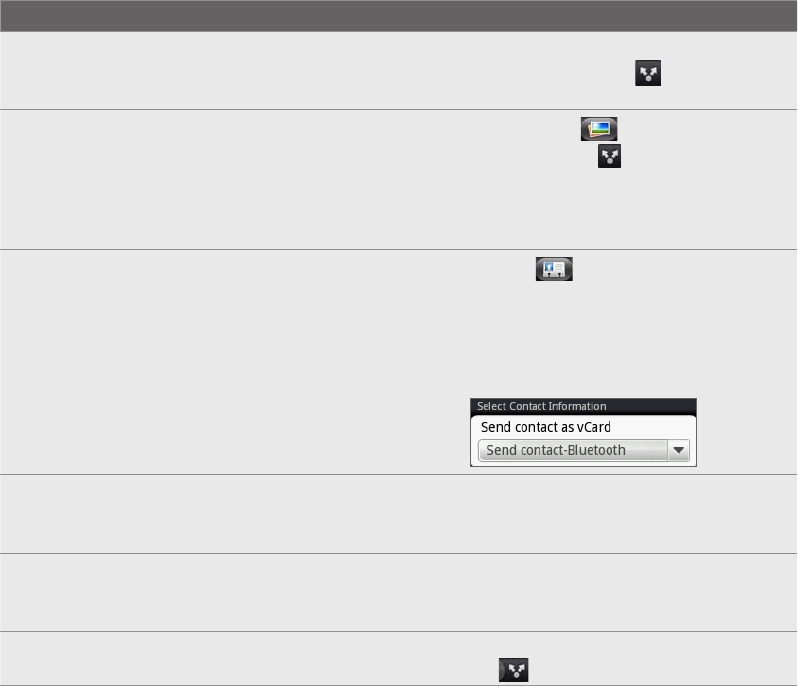
135 Bluetooth
Sending information using Bluetooth
You can use Bluetooth to send information from your phone to another Bluetooth
enabled device such as a phone or notebook computer. You can send the following
types of information, depending on the device you are sending to:
Images and videos
Calendar events
Contacts
Audio files
Before you begin, set the receiving device to discoverable mode. You may also need
to set it to “Receive Beams” or “Receive Files”. Refer to the device’s documentation for
instructions on receiving information over Bluetooth.
The first time you transfer information between your phone and another device, you
need to enter or confirm a security passcode. After that, your phone and the other
device are paired, and you will not need to exchange passcodes to transfer information
in the future.
1. On your phone, open the application that contains the information or file you
want to send.
2. Follow the steps for the type of item you want to send:
What to send Application How to send
Photo or video Camera After capturing a photo, on the preview
screen, tap the Share button , and then tap
Bluetooth.
Photos or videos Gallery 1. On the Albums tab , choose an album.
2. Tap the Share button , and then tap
Bluetooth.
3. Choose the items you want to share, and
then tap Next.
Contact People 1. On the All tab , press and hold a
contact, and then tap Send contact as
vCard.
2. Tap the down arrow icon, and then select
Bluetooth from the displayed list.
Appointment or
event
Calendar In Day view, Agenda view, or Week view,
press and hold the event, and then tap Share
vCalendar > Bluetooth.
Music track Music With the track displayed on the Now playing
screen, press MENU, and then tap Share >
Bluetooth.
Voice recording Voice Recorder On the main Voice Recorder screen, tap the
Share button , and then tap Bluetooth.
3. If you’re asked to turn on Bluetooth, tap Turn on.
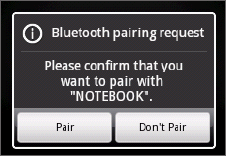
136 Bluetooth
4. Tap the name of the receiving device.
If you haven’t paired with the receiving device before, tap Scan for devices first.
5. On your phone, tap Pair to confirm that you want to pair with the receiving
device.
6. If prompted, accept the connection on the receiving device, and enter the
same passcode on both your phone and the other device, or confirm the auto-
generated passcode.
7. On the receiving device, accept the file.
The location where the information is saved depends on the type of information and
the receiving device:
If you send a calendar event or contact, it is normally added directly to the
corresponding application on the receiving device. For example, if you send
a calendar event to a compatible phone, the event is shown in that phone’s
calendar application.
If you send another file type to a Windows computer, it is normally saved in
the Bluetooth Exchange folder within your personal document folders.
On Windows XP, the path may be:
C:\Documents and Settings\[your username]\My Documents\Bluetooth
Exchange
On Windows Vista, the path may be:
C:\Users\[your username]\Documents
On Windows 7, the path may be:
C:\Users\[your username]\My Documents\Bluetooth Exchange Folder
If you send a file to another device, the saved location may depend on the file
type. For example, if you send an image file to another mobile phone, it may
be saved in a folder named “Images”.
Receiving information using Bluetooth
Your phone is capable of receiving a wide variety of file types with Bluetooth,
including photos, music tracks, and documents such as PDFs.
To receive files using Bluetooth, you need to have a microSD card on your phone.
The first time you transfer information between your phone and another device, you
need to enter or confirm a security passcode. After that, your phone and the other
device are paired, and you will not need to exchange passcodes to transfer information
in the future.
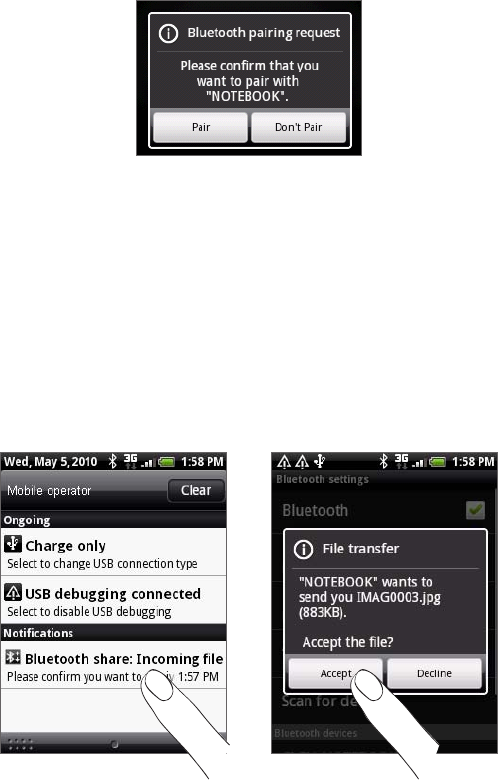
137 Bluetooth
From the Home screen, press MENU, and then tap Settings > Wireless &
networks > Bluetooth settings.
If the Bluetooth check box is not selected, select it to turn Bluetooth on.
Select the Discoverable check box.
On the sending device, send one or more files to your phone. Refer to the
device’s documentation for instructions on sending information over Bluetooth.
5. On your phone, tap Pair to confirm that you want to pair with the sending
device.
6. If prompted, enter the same passcode on both your phone and the other device,
or confirm the auto-generated passcode.
A Bluetooth authorization request is then displayed on your phone.
7. If you want to automatically receive files from the sending device in the future,
select the Always check box.
8. Tap Accept.
9. When your phone receives a file transfer request notification, slide down the
Notifications panel, tap the incoming file notification, and then tap Accept.
10. When a file is transferred, a notification is displayed. To open the file immediately,
slide down the Notifications panel, and then tap the relevant notification. When
you open a received file, what happens next depends on the file type:
Media files and documents are usually opened directly in a compatible
application.
For example, if you open a music track, it starts playing in the Music
application.
For a vCalendar file, select the calendar where you want to save the event,
and then tap Import. The vCalendar is added to your Calendar events. For
information on using Calendar, see the Calendar chapter.
1.
2.
3.
4.

138 Bluetooth
For a vCard contact file, if there are multiple vCard files on your storage
card, you can choose to import one, several, or all of those contacts to your
contacts list.
Adding the Bluetooth Received folder to the Home screen
You can add a folder to the Home screen that shows all files you have received with
Bluetooth.
From the Home screen, tap .
On the Add to Home screen, tap Folder > Bluetooth Received.
Press and hold the Bluetooth received folder icon, and drag it to the Home
screen position you want.
To view the folder contents, tap the folder icon. To open a file, tap the file name.
1.
2.
3.
139 Bluetooth
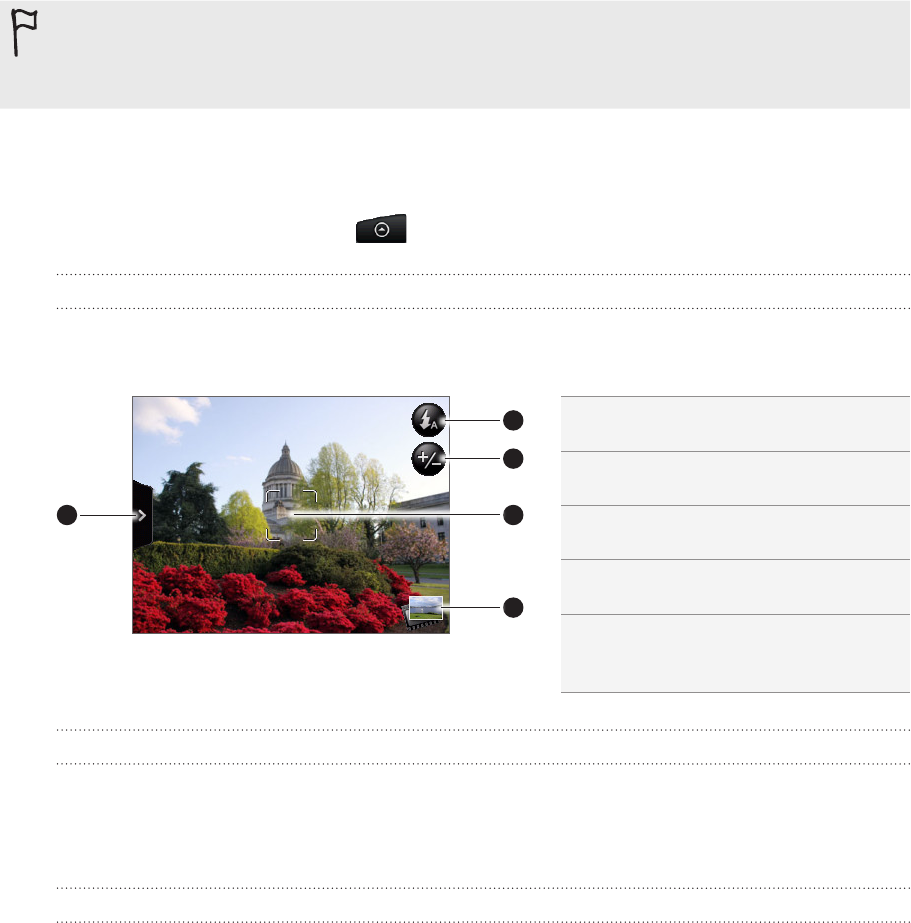
140 Camera
Camera
Camera basics
Whether traveling for business or fun, enjoy taking photos and videos of your trip and
encounters with your phone’s camera.
Be sure to plug in your microSD card before you use your phone’s camera. Photos and videosPhotos and videos
captured with the camera will be stored onto your microSD card.
If you have not yet inserted your microSD card to your phone, follow the steps in “Inserting the
storage card“ in the Basics chapter to insert it.
To open the camera in photo mode and take photos, tap Camera on the main
Home screen.
To open the camera directly in video mode so you can immediately start
capturing videos, tap from the Home screen, and then tap Camcorder.
Viewfinder screen
The camera displays in landscape view only. You’ll find the following controls on the
Viewfinder screen:
2
3
1
4
51 Menu tab See “Camera
settings.”
2 Gallery button See the Gallery
chapter.
3 Auto-focus
indicator
See “Auto
focusing.”
4 Zoom button See “Zooming.”
5 Flash button Available in
photo mode
only.
Using the optical trackball as the shutter release
The optical trackball works as the shutter release for the camera. Press the optical
trackball to take a photo or begin capturing video. Press it again to stop capturing
video.
Review screen
After capturing a photo or video, the Review screen will display the photo or the
starting image of the video that you have just captured. You can tap the onscreen
buttons to delete the photo or video, view it in the Gallery application, or share it.
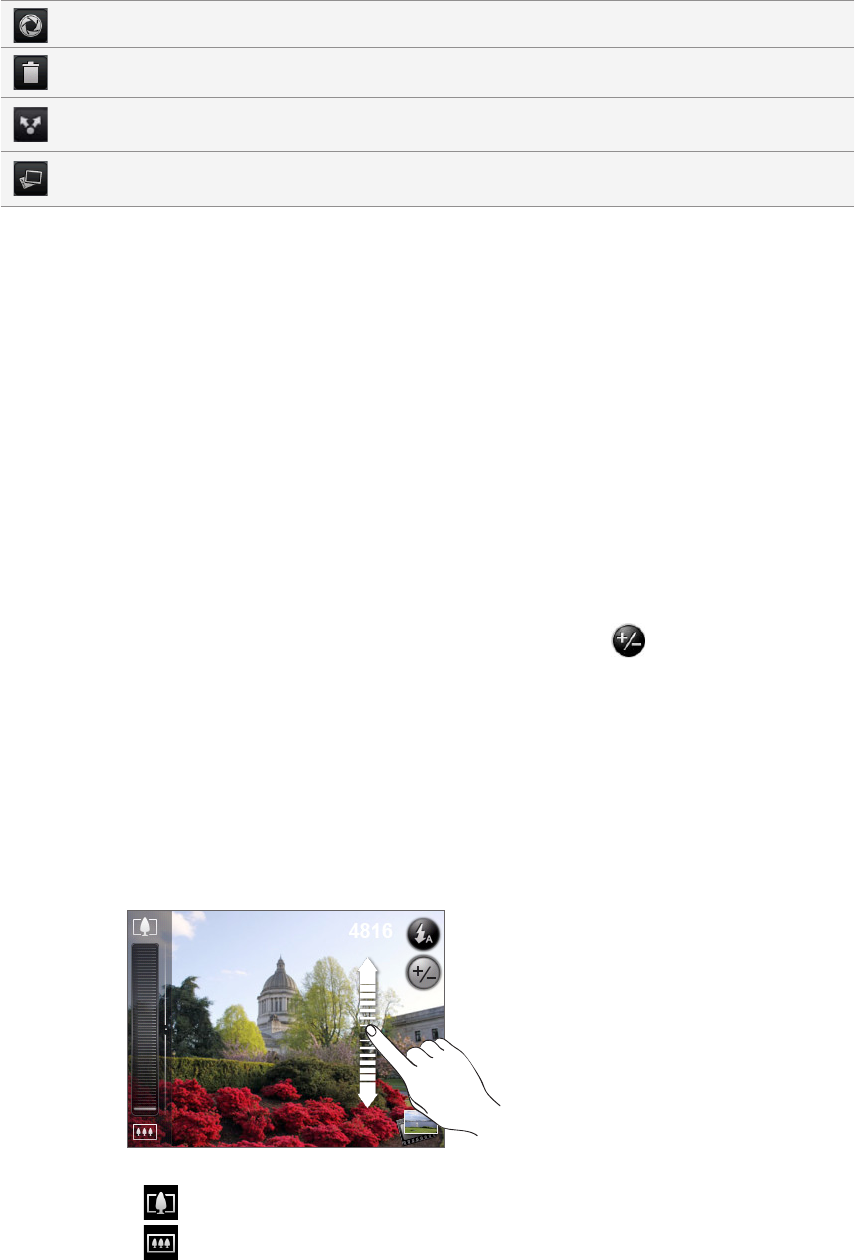
141 Camera
Back. Return to the Viewfinder screen.
Delete. Delete the captured photo or video.
Share. Send the captured photo or video to another phone or your computer using
Bluetooth, send it by email, or select a social network where you want to upload it to.
Gallery. Open and use the Gallery application to view the captured photo or video,
rotate your captured photo, and more. See the Gallery chapter for details.
Auto focusing
Whenever you point the camera at a different subject or location, the screen shows
the auto-focus indicator at the center as the camera automatically focuses on the
center of the screen.
When you tap another area on the screen, the indicator will move to where you
tapped and the camera will automatically focus on that area.
Zooming
Before taking a photo or video, you can first use the onscreen zoom bar to zoom in or
out of your subject.
1. To display the onscreen zoom bar, tap the Zoom button . You can also slide
your finger up or down the Viewfinder screen.
While the zoom bar is shown on the Viewfinder screen, you will also see the
remaining photo shots or remaining video recording duration on the upper-right
side of the screen.
2. You can do the following:
To slowly zoom in or out, slide your finger up or down the Viewfinder
screen.
Drag your finger across the zoom bar.
Tap to zoom in to the highest magnification.
Tap to zoom out to the actual size.
3. After you’re done, wait for a few seconds for the zoom bar to automatically
disappear from the screen. You can also tap the Zoom button again or tap the
Viewfinder screen to hide it.

142 Camera
Taking a photo
1. On the main Home screen, tap Camera.
2. Before taking the photo, you can zoom in first on your subject. See “Zooming” to
find out how to use the onscreen zoom bar.
3. On the Viewfinder screen, tap the Flash button repeatedly to select a camera
flash mode depending on your lighting conditions:
Auto flash
Flash on
Flash off
4. Frame your subject on the Viewfinder screen.
5. Let the camera auto focus on the center of the screen, or you can touch another
area on the screen that you want to focus on.
6. Press the optical trackball to take the photo.
7. Choose what you want to do with the photo you’ve just taken. See “Review
screen“ for details.
Camera flash doesn’t turn on?
Using the flash eats up much battery power. To save battery power, the camera
disables the flash (even when you have set the camera flash mode to Auto flash or
Flash on) when one of the following occurs:
You have an incoming call
The flash will be disabled temporarily when you have an incoming call. After the
call ends, you’ll be able to use the flash again.
If you have set the flash to Flash on, it turns back on after you answer and end the
call.
Your phone’s battery level reaches 15% or lower
Recharge the battery so that the camera can have enough battery power to use
the flash.
Cold weather may lower battery performance which affects the flash
To make sure the camera has enough battery life to power up the flash, keep
your phone warm. When not in use, put the phone inside your jacket to keep
it warm, and try to avoid sudden temperature changes that may affect battery
performance.
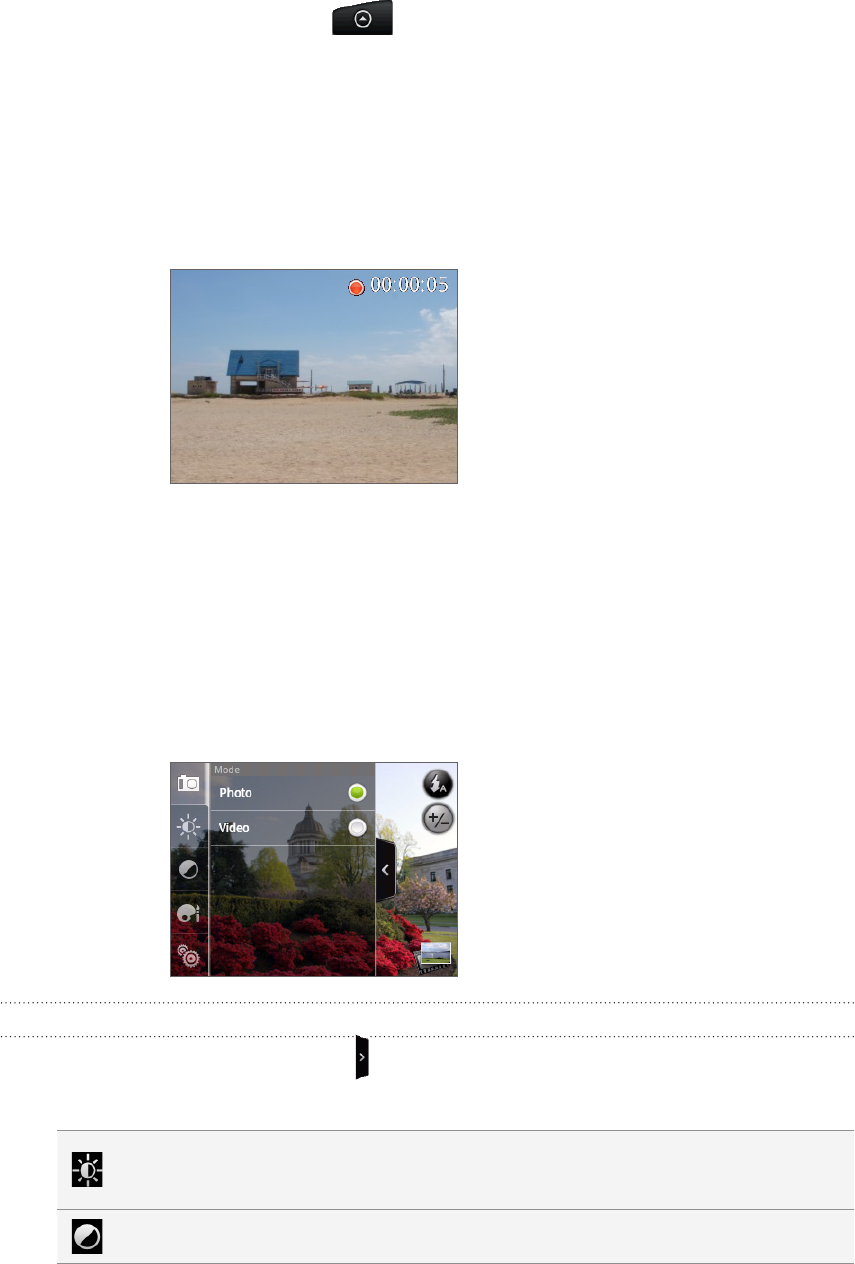
143 Camera
Capturing a video
1. From the Home screen, tap , and then tap Camcorder.
2. Before capturing video, you can zoom in first on your subject. See “Zooming” to
find out how to use the onscreen zoom bar.
3. Frame your subject on the screen.
4. Let the camera auto focus on the center of the screen, or you can touch another
area on the screen that you want to focus on.
5. Press the optical trackball to start capturing video.
6. To stop capturing, press the optical trackball again.
7. Choose what you want to do with the video you’ve just captured. See “Review
screen“ for details.
Camera settings
Open the menu panel to change basic camera settings and access more camera
settings. You can also switch between photo and video modes from the menu panel.
Changing basic settings
1. On the Viewfinder screen, tap to open the menu panel.
2. To change basic camera settings, tap one of these icons in the menu panel:
Exposure. There’s a Brightness bar that allows you to adjust the brightness
level. Slide your finger up or down the Brightness bar to increase or decrease
brightness.
Image properties. Slide your finger across each of the slider bars to adjust the
contrast, saturation, and sharpness.
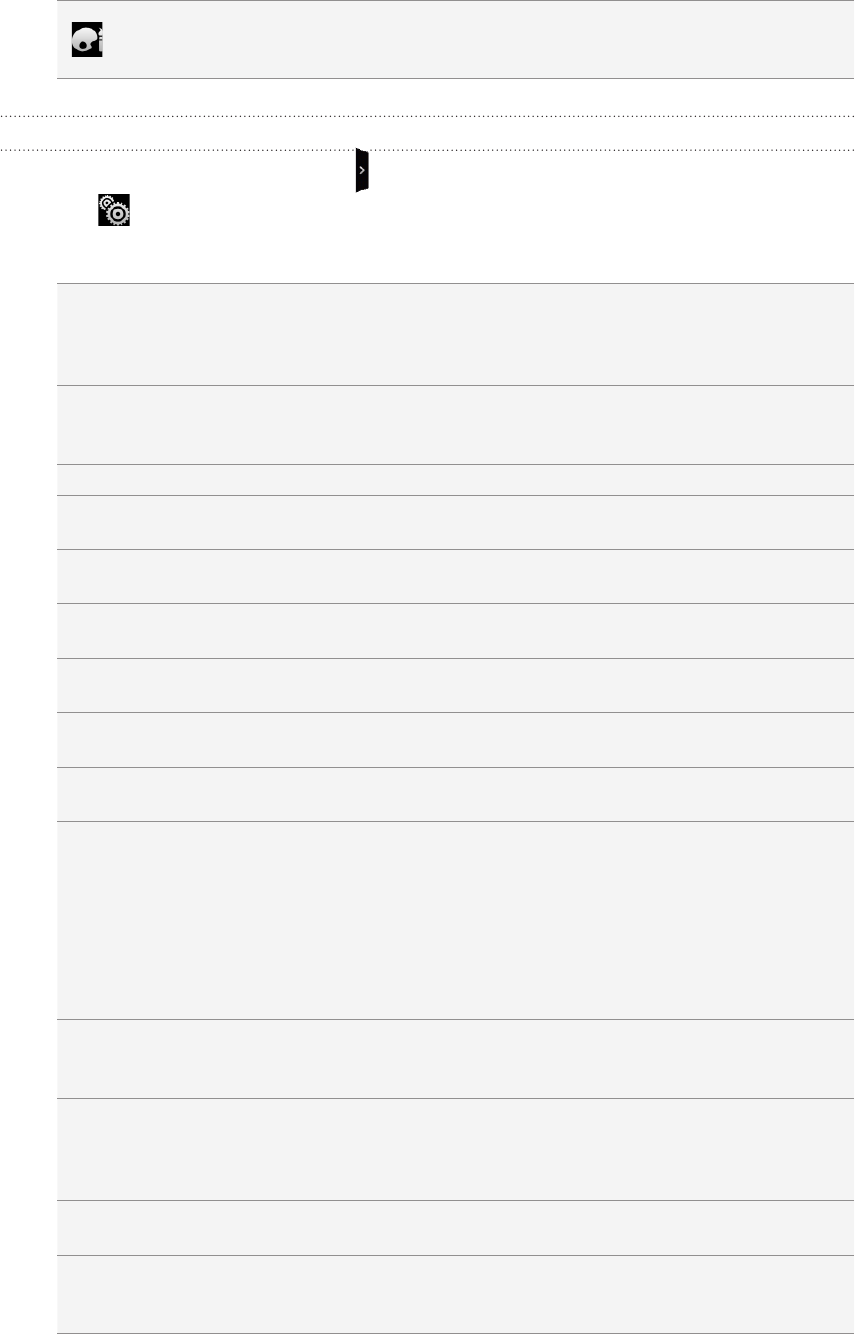
144 Camera
Effect. You can apply a special effect to photos and videos that you will capture.
Scroll through the Effect menu and choose from effects such as sepia, solarize,
posterize, and more.
Changing advanced settings
1. On the Viewfinder screen, tap to open the menu panel.
2. Tap in the menu panel to display the Settings menu and access more camera
settings. The following are settings that you can change from the Settings menu:
White balance White balance enables the camera to capture colors
more accurately by adjusting to your current lighting
environment. White balance settings include: Auto,
Incandescent, Fluorescent, Daylight, and Cloudy.
ISO (photo mode only) You can choose an ISO level or set it back to Auto. Higher
ISO numbers are better for taking pictures in low light
conditions.
Resolution Select a photo or video resolution to use for capturing.
Quality
(photo mode only)
Select the quality level to use for capturing photos.
Self-timer
(photo mode only)
If you need to take a self-portrait or group photo, you can
set the self-timer to either 2 or 10 seconds.
Geo-tag photos
(photo mode only)
Select this check box when you want to store GPS location
in your captured photos.
Encoding type
(video mode only)
Choose the type of video compression.
Recording length
(video mode only)
Set the maximum duration or file size for capturing video.
Record with audio
(video mode only)
Select or clear the check box, depending on whether you
want to record audio when capturing videos.
Metering mode Set how the camera measures the amount of light to
calculate the best exposure:
Spot metering mode allows the camera to measure light
around the focus point.
Center area mode allows the camera to measure light in
the center.
Average mode allows the camera to measure light in the
whole image.
Review duration Set the time for a captured photo or video to be displayed
on the Review screen before the camera changes back to
the Viewfinder screen.
Flicker adjustment When taking indoor shots under fluorescent lighting, keep
this setting on Auto or change it to the proper frequency
(50Hz or 60Hz) of the power in your country to reduce
flicker.
Auto Focus This option enables or disables centered auto focus. Auto
focus is enabled by default.
Shutter sound Select or clear this check box, depending on whether you
want the camera to play a shutter sound when you press
the shutter release.

145 Camera
Time stamp
(photo mode only)
Select this check box when you want the date and time to
be added on captured photos.
Grid (photo mode only) Select this check box when you want to display a grid on
the Viewfinder screen so you can easily frame and center
your subject before taking the photo.
Reset to default Tap to change the camera back to default settings.
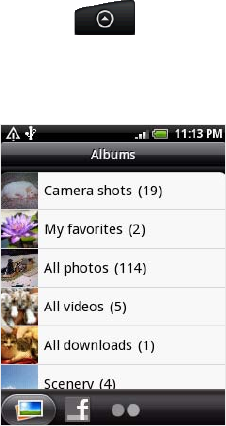
146 Gallery
Gallery
About the Gallery application
Using the Gallery application, you can view photos and watch videos that you’ve
taken with your phone’s camera, downloaded, or copied onto your storage card. You
can also take a look at your photos and your friends’ photos that are on your social
networks (Facebook and Flickr only).
For photos that are in your storage card, you can do basic editing such as rotate and
crop. You can also easily make a photo as your contact picture or wallpaper and share
photos to your friends.
Selecting an album
From the Home screen, tap , and then tap Gallery.
The Gallery application opens in the Albums screen where your photos and videos are
organized by albums for easy viewing.
The following are preset albums:
Camera shots lets you view photos and videos that are stored in the camera’s
folder.
Photos and videos that you set as your favorites will be grouped under My
favorites.
All photos lets you view all photos that are stored in all the folders on the
storage card.
All videos lets you view all videos that are stored in all the folders on the
storage card.
All downloads lets you view photos and videos that you downloaded.
Folders in your storage card that contain photos and videos will also be treated as

147 Gallery
albums and will be listed below the preset albums. The actual folder names will be
used as the album names.
Simply tap an album to view the photos and/or videos in that album.
If there are photos or videos under the root path of your storage card (that are not contained
in folders), they will be grouped under the Other album.
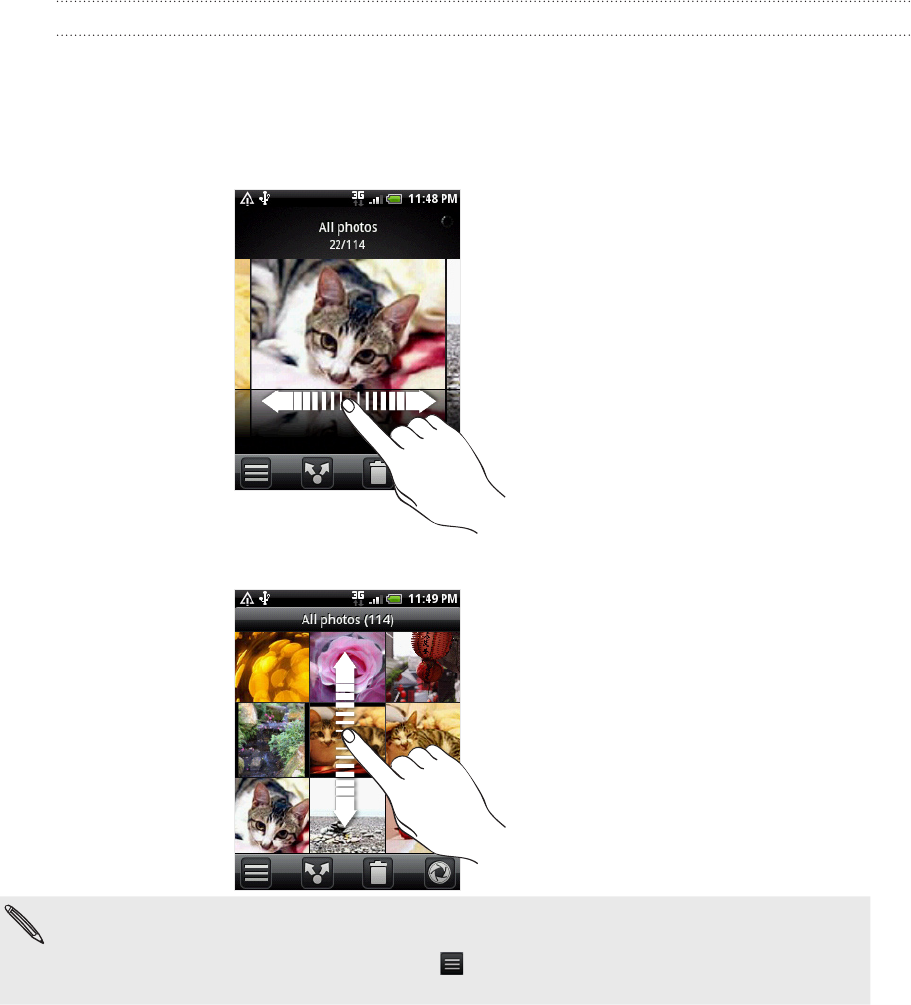
148 Gallery
Viewing photos and videos
After selecting an album from the Gallery application’s Albums screen, you can browse
through the photos and videos of that album either in filmstrip or grid view. Tap a
photo or video to view it in full screen.
Browsing in filmstrip or grid view
To switch between filmstrip and grid views, press MENU, and then tap Filmstrip
view or Grid view.
In filmstrip view, slide your finger left or right across the screen to go through
your photos and videos.
In grid view, slide your finger up or down to scroll through the thumbnails.
Whether you’re in filmstrip or grid view, you can press and hold on a photo or video to
open a selection menu and choose what to do with the photo or video.
If you want to select another album, tap to return to the Gallery application’s Albums
screen.

149 Gallery
Viewing photos and videos in landscape orientation
The photo orientation adjusts to how you hold your phone. Turn your phone
sideways to the left to view a photo in landscape mode.
Video is always displayed in landscape mode when you play it. Use the
onscreen controls to play, pause, or stop the video.
Video is displayed in full screen size. You can tap to make it best fit on the screen
based on the video size. Tap the button again to change back to full screen size.
Zooming in or out on a photo
There are two ways you can zoom in or out of a photo:
Tap the screen twice quickly to zoom in, then tap the screen twice quickly
again to zoom out.
You can also use pinch zooming. Press your thumb and index finger on the
screen and then spread your fingers apart to zoom in. Pinch your fingers
together to zoom out.
Zooming in Zooming out
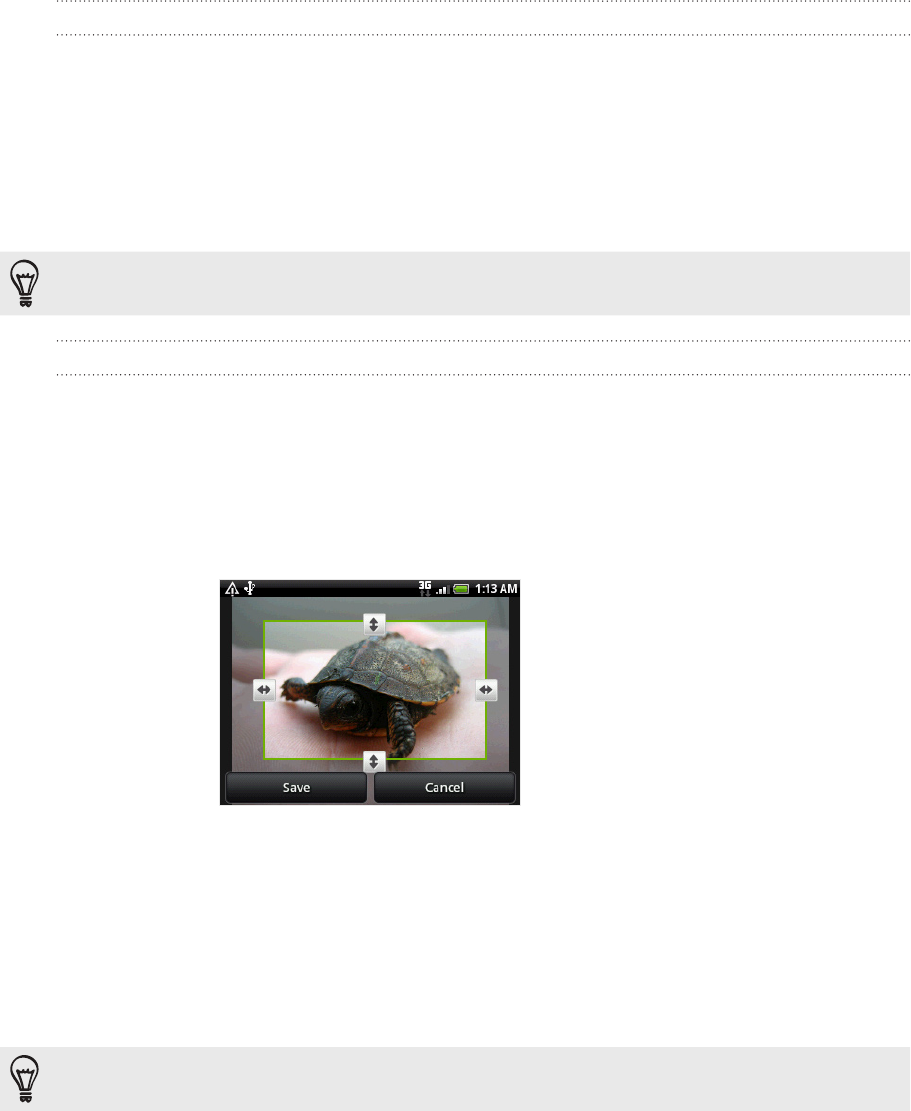
150 Gallery
Editing your photos
Rotating and saving a photo
On the Gallery application’s Albums screen, tap an album.
Choose whether to browse photos and videos in the album in filmstrip or grid
view. See “Browsing in filmstrip or grid view” for details.
Press and hold on the photo that you want to rotate.
In the menu that opens, tap Rotate, and then select either Rotate left or Rotate
right.
You can also rotate a photo while you’re viewing it in full screen. Press MENU, tap Rotate, and
then select either Rotate left or Rotate right.
Cropping a photo
On the Gallery application’s Albums screen, tap an album.
Choose whether to browse photos and videos in the album in filmstrip or grid
view. See “Browsing in filmstrip or grid view” for details.
Press and hold on the photo that you want to crop.
In the menu that opens, tap Crop. A crop box then appears on the photo.
5. To adjust the crop box size, press and hold the edge of the box. When directional
arrows appear, drag your finger inward to or outward to resize the crop box.
6. To move the crop box to the part of the photo that you want to crop, drag the
crop box to the desired position.
7. Tap Save to apply the changes to the picture.
The cropped picture is saved in the storage card as a copy. The original picture
remains unedited.
You can also crop a photo while you’re viewing it in full screen. Press MENU, tap More > Crop,
and follow the same cropping steps as above.
1.
2.
3.
4.
1.
2.
3.
4.

151 Gallery
Sending your photos and videos
Using the Gallery application, you can send photos and videos via email or MMS. You
can also send them to another phone or your computer using Bluetooth.
Sending photos or videos by email
You can send several photos, videos, or both in an email message. They are added as
file attachments in your email.
On the Home screen, tap , and then tap Gallery.
Tap the album where the photos or videos you want to share are in.
Tap and then on the Share options menu, tap Gmail/Google Mail or Mail.
Select the photos or videos you want to share and then tap Next.
Compose your message and then tap Send.
If you selected Mail and you have multiple email accounts, the default email account will be
used.
Sending a photo or video by MMS
On the Home screen, tap , and then tap Gallery.
Tap the album where the photo or video you want to share is in.
Tap and then on the Share options menu, tap Messages.
Tap the photo or video you want to send.
The photo or video is automatically added into the MMS message.
Compose your message and then tap .
Sending photos or videos using Bluetooth
You can select several photos, videos, or both and send them to someone’s phone or
your computer using Bluetooth.
On the Home screen, tap , and then tap Gallery.
Tap the album where the photos or videos you want to share are in.
Tap and then on the Share options menu, tap Bluetooth.
Select the photos or videos you want to share and then tap Next.
In the next few steps, you’ll be asked to turn on Bluetooth on your phone and
connect to the receiving Bluetooth device so the files can be sent. Follow the
steps in “Sending information using Bluetooth” in the Bluetooth chapter.
1.
2.
3.
4.
5.
1.
2.
3.
4.
5.
6.
1.
2.
3.
4.
5.
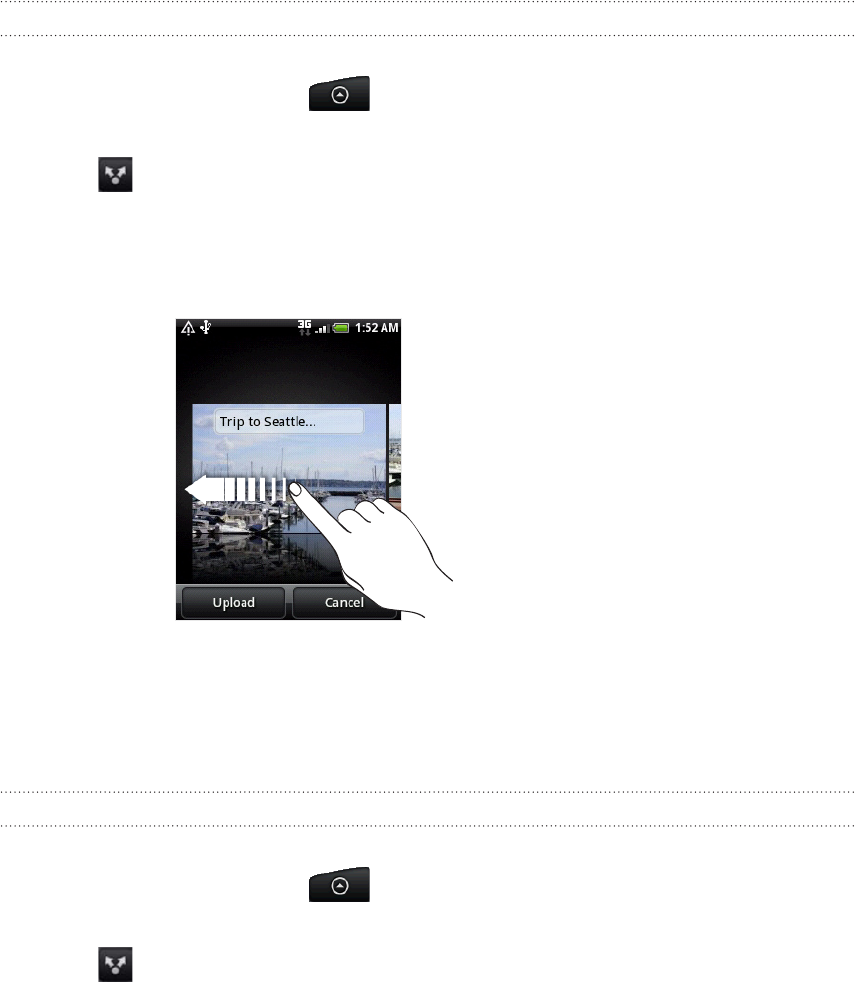
152 Gallery
Sharing your photos and videos on the Web
Using the Gallery application, you can share photos on your social networks (such as
Facebook, Flickr, Picasa, and Twitter) and share videos on YouTube.
You can also use the Camera or Camcorder application to share a photo or video right
after you’ve captured it. See the Camera chapter.
Sharing photos on Facebook
You need to be logged in to your Facebook account to be able to upload pictures.
On the Home screen, tap , and then tap Gallery.
Tap the album where the photos you want to share are in.
Tap and then on the Share options menu, tap Facebook for HTC Sense.
Select the pictures you want to share and then tap Next.
Enter a different caption on each photo. Scroll to the right to go to the next
photo.
6. Tap Upload.
7. Select which album to upload to and set privacy settings for the uploaded
pictures.
8. Tap Done.
Sharing photos on Flickr
You need to be logged in to your Flickr account to be able to upload pictures.
On the Home screen, tap , and then tap Gallery.
Tap the album where the photos you want to share are in.
Tap and then on the Share options menu, tap Flickr.
Select the pictures you want to share and then tap Next.
Enter a different title and description on each photo. Scroll to the right to go to
the next photo.
1.
2.
3.
4.
5.
1.
2.
3.
4.
5.
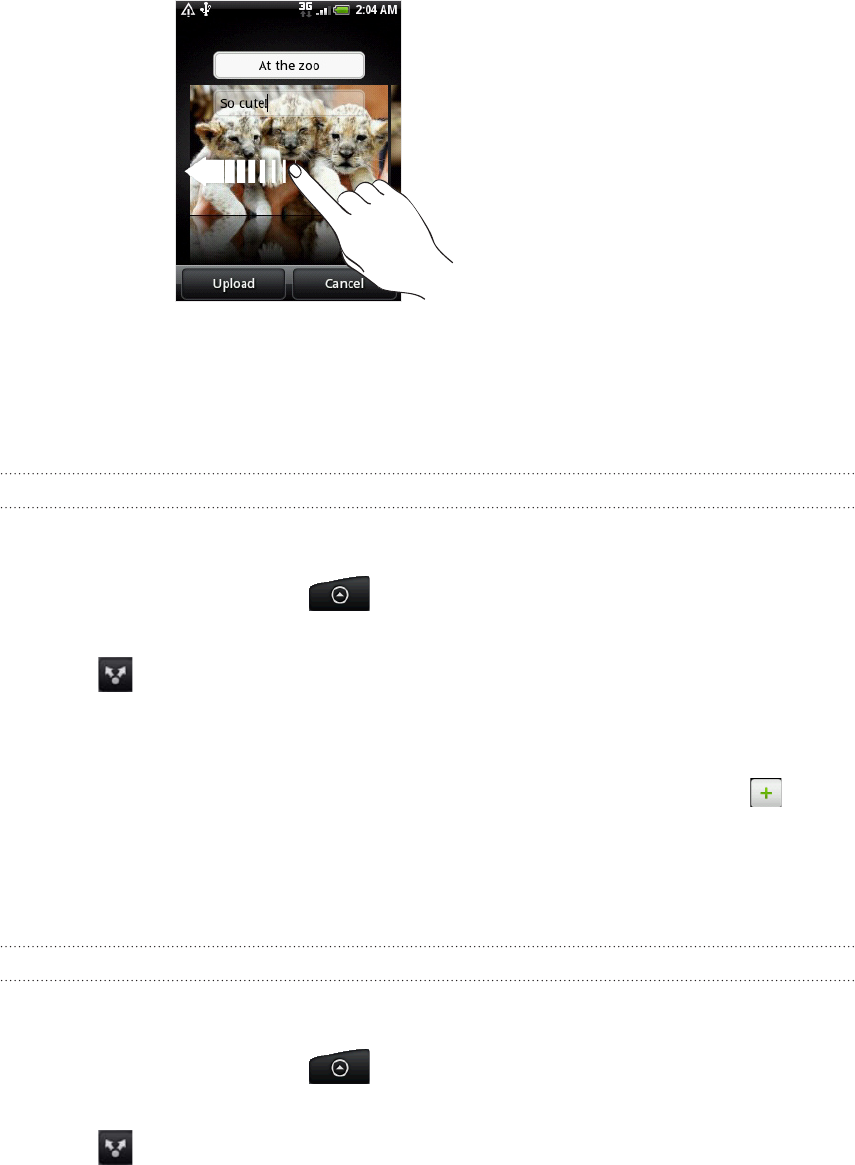
153 Gallery
6. Tap Upload.
7. Select which album to upload to and set privacy settings for the uploaded
pictures.
8. Tap Done.
Sharing photos on Picasa
You need to be signed in to a Google Account to be able to upload pictures to the
Picasa™ photo organizing service.
On the Home screen, tap , and then tap Gallery.
Tap the album where the photos you want to share are in.
Tap and then on the Share options menu, tap Picasa.
Select the pictures you want to share and then tap Next.
Enter a caption for the pictures you’re uploading.
Select the online album where you want to upload the pictures, or tap to
create a new album.
Tap Upload.
You can view the photos online at http://picasaweb.google.com.
Sharing videos on YouTube
You can share your videos by uploading them to YouTube™. Please sign in to your
YouTube or Google Account, if you’re asked to do so.
On the Home screen, tap , and then tap Gallery.
Tap the album where the videos you want to share are in.
Tap and then on the Share options menu, tap YouTube.
Select the videos you want to share and then tap Next.
Enter a title for the videos you’re uploading.
Tap More details and enter the prompted information, such as description and
tags, and select a privacy option.
Tap Upload.
1.
2.
3.
4.
5.
6.
7.
1.
2.
3.
4.
5.
6.
7.
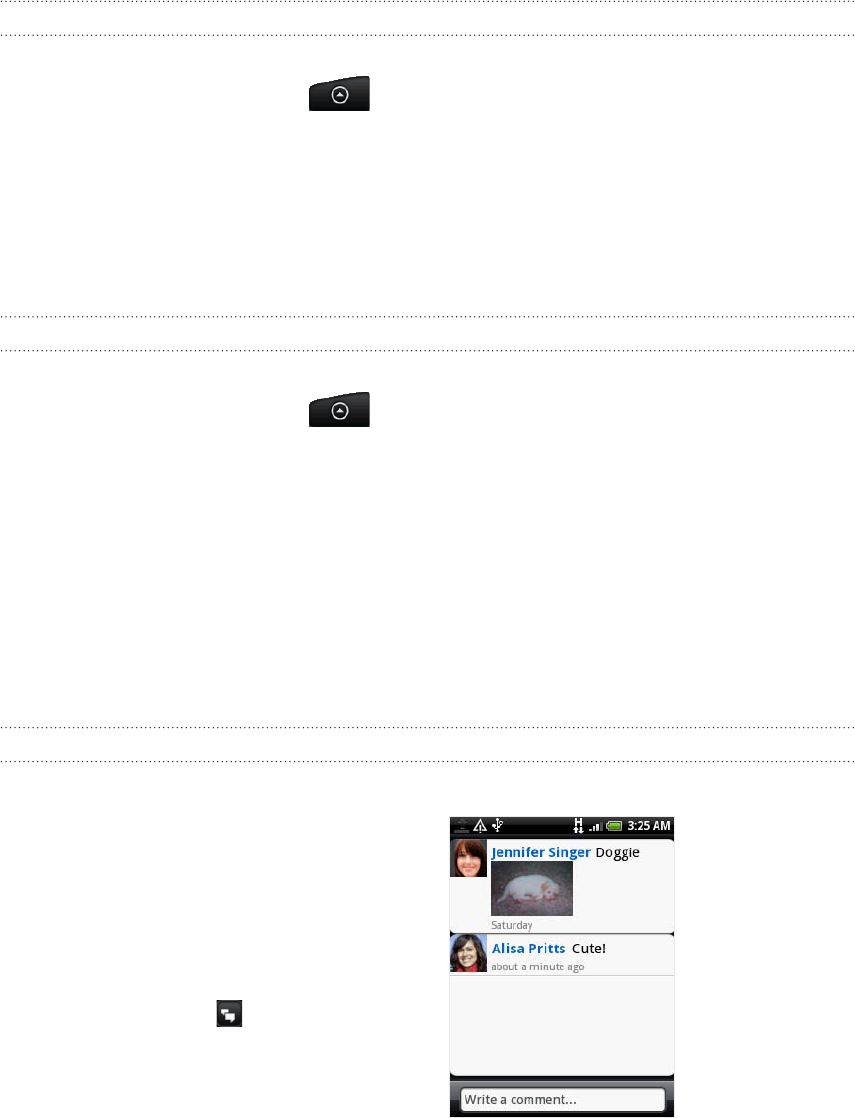
154 Gallery
Viewing photos in your social networks
Right on the Gallery application, you can check your uploaded photos and your
friends’ photos that are in your social networks (Facebook and Flickr only).
Viewing photos on Facebook
You need to be logged in to your Facebook account to view Facebook photos.
On the Home screen, tap , and then tap Gallery.
Tap the Facebook tab.
Tap your account name or your friend’s account on the list to view the pictures in
the account.
You can view photos in your online albums the same way as how you view photos in
your storage card.
Viewing photos on Flickr
You need to be logged in to your Flickr account to view Flickr photos.
1. On the Home screen, tap , and then tap Gallery.
2. Tap the Flickr tab.
You may be asked to give authorization for the application to connect to the
Flickr website. If this happens, you need to give authorization to access your
Flickr account.
3. Tap your account name or your friend’s account on the list to view the photos in
the account.
You can view photos in your online albums the same way as how you view photos in
your storage card.
Commenting photos in your social networks
Add comments to your uploaded photos as well as your friends’ photos.
1. Do one of the following:
While browsing online photos in
filmstrip or grid view, press and
hold a photo and then tap Add
comment.
While viewing a photo in full
screen, tap .
Or, press MENU, and then tap
Comment.
2. Tap the box that says “Write a
comment.”
3. Enter your text, and then tap
Comment.
1.
2.
3.
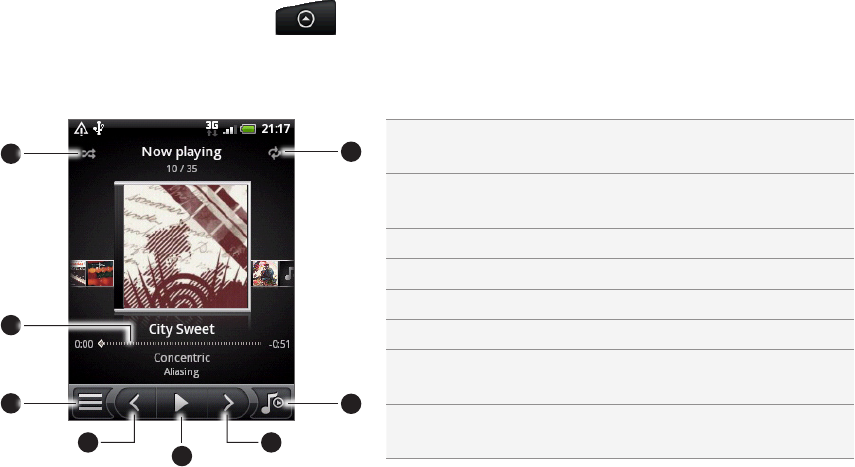
155 Music
Music
Playing music
Enjoy listening to songs and music on your phone using the Music application. You
need to copy music files to your storage card first to use the Music application to play
music. To find out how to copy files, see “Copying files to or from the storage card” in
the Getting started chapter.
From the Home screen, tap , and then tap Music.
The Music application opens in the Playback screen. Tap the onscreen icons to control
music playback, select a song to play, repeat songs, and more.
2
3
4
5
1
6
7
8
1 Turn shuffle on or off.
(Shuffle is off when button is gray.)
2 Press and drag your finger across the progress
bar to jump to any part of the song.
3 Go to the Library.
4 Go to the previous song in the Now playing list.
5 Play, pause, or resume playing the song.
6 Go to the next song in the Now playing list.
7 Switch between showing the Now playing list
and Playback screen.
8 Cycle through the repeat modes: Repeat all
songs, Repeat current song, and Don’t repeat.
You can also:
Swipe your finger from right to left or left to right to go to the next or
previous music album.
Press MENU and then tap Add to playlist to add the current song to a playlist.
To find out more about playlists, see “Creating a playlist.”
Press the VOLUME UP or VOLUME DOWN button to adjust the playback
volume.
If you are using the wired headset to listen to music, press the center button
to toggle between playing and pausing playback. Press the previous or next
button to go to the previous or next song.

156 Music
When you are playing music and the screen turns off, you
can control the music playback right from the Lock screen
when you “wake up” the phone by pressing POWER. If you
do not see the playback controls on the Lock screen, tap
anywhere on the screen to display the playback controls.
Browsing music in the Library
Tap at the bottom-left corner of the Music application’s Playback screen or Now
playing list to go to the Library.
In the Library, your music is organized into different categories such as Albums,
Artists, Genres, Composers, and more. Select a category by tapping one of the
category tabs at the bottom of the screen.
When you tap a song in a category to play it, the Now playing list is updated with the
song list from your selected category.
Creating a playlist
Personalize your music experience by creating music playlists. Make a playlist
containing just your favorite songs or create one to match your mood for the day. You
can make as many playlists as you like.
From the Home screen, tap , and then tap Music.
Tap at the bottom-left corner of the screen to go to the Library.
In the Library, tap or slide your finger on the bottom row to go to the Playlists
category.
Tap Add playlist.
Enter a playlist name, and then tap Add songs to playlist.
1.
2.
3.
4.
5.

157 Music
Tap or slide your finger on the bottom row to change among the different
categories. If you go to the Songs category, you can see a complete list of songs
on your storage card.
Select the check boxes of songs you want to add to the playlist and then tap
Add.
Tap Save.
Playing the songs in a playlist
In the Library, tap or slide your finger on the bottom row to go to the Playlists
category.
Tap a playlist to open it.
Tap the first song or any song in the playlist.
When you tap a song in the list to play it, the Now playing list is updated with
the song list from your playlist.
Managing playlists
After creating a playlist, you can add more songs to it, rearrange their order, and more.
In the Library, tap or slide your finger on the bottom row to go to the Playlists
category.
Tap a playlist to open it.
Press MENU, and then choose what you want to do:
Add more songs to a
playlist
Tap Add songs.
Go to the Songs category or any other category.
Select the songs you want to add to the playlist and then
tap Add.
1.
2.
3.
Rearrange songs Tap Change order.
Press and hold at the end of the song title you want
to move. When the row is highlighted, drag it to its new
position, then release.
Tap Done.
1.
2.
3.
Delete songs from a
playlist
Tap Remove songs.
Select the songs you want to delete and then tap
Remove.
1.
2.
Change playlist name Tap Rename playlist.
Deleting playlists
In the Library, tap or slide your finger on the bottom row to go to the Playlists
category.
Press MENU and then tap Delete playlists.
Select the playlists to delete and then tap Delete.
6.
7.
8.
1.
2.
3.
1.
2.
3.
1.
2.
3.

158 Music
Setting a song as ringtone
You can select a song from the Music application’s Library and set it as your phone’s
ringtone or a ringtone for a certain contact.
From the Home screen, tap , and then tap Music.
Tap at the bottom-left corner of the screen to go to the Library.
In the Library, select the song that you want to use as ringtone and then play it
back.
On the Playback screen, press MENU and then tap Set as ringtone.
If you chose an MP3 song, you can trim it first and set the part that you trimmed
as the ringtone. See “Trimming an MP3 ringtone.”
In the Set as ringtone options menu, tap Phone ringtone or Contact ringtone.
If you select Contact ringtone, you need to select the contacts you want to
associate the song with in the next screen.
1.
2.
3.
4.
5.
6.
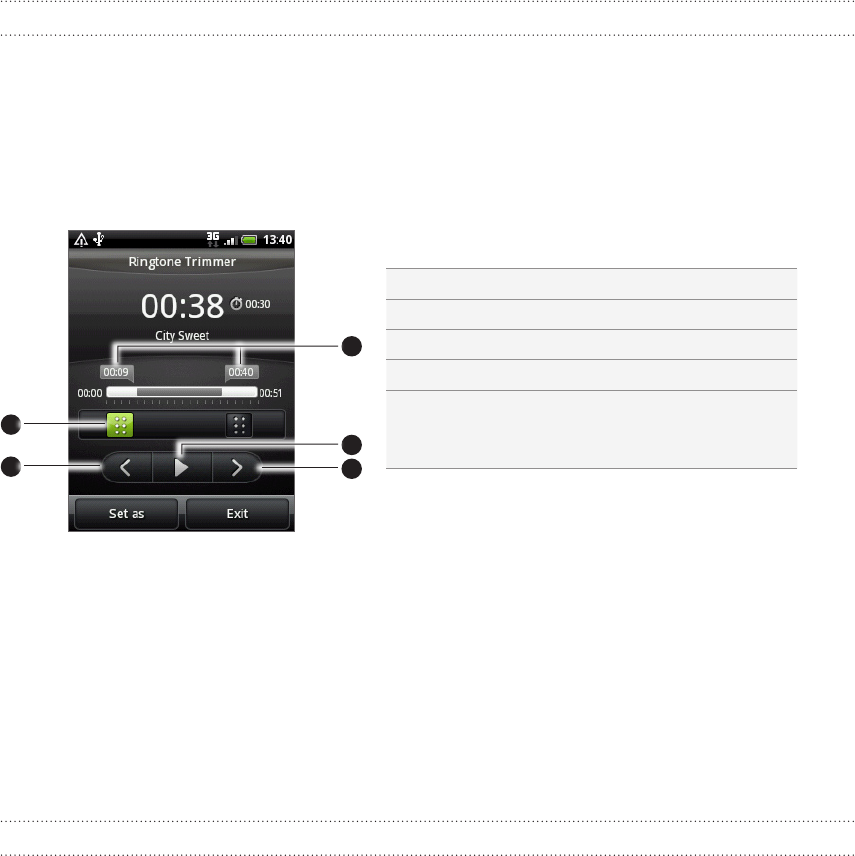
159 Music
Trimming an MP3 ringtone
The Music application has a built-in ringtone trimmer. You can trim an MP3 song and
set a part of it as your ringtone.
1. On the Playback screen, press MENU, and then tap Set as ringtone > Trim the
ringtone.
2. Use the onscreen controls to trim your ringtone.
23
4
5
1
1 Trim sliders
2 Right button
3 Left button
4 Play/Pause button
5 Markers
(These show where the ringtone starts
and ends.)
To trim, you can:
First drag the two trim sliders approximately to the part where you want the
ringtone to begin and end.
Then tap the right and left arrow buttons to more precisely set the start and
end points of the ringtone.
3. After you’ve finished trimming, tap Set as. Then choose whether to set the
trimmed song as your Phone ringtone or Contact ringtone.
Checking if the song was added as a ringtone
From the Home screen, press MENU and then tap Settings.
On the Settings screen, tap Sound & display > Phone ringtone. The song should
be in the ringtone list and selected.
1.
2.
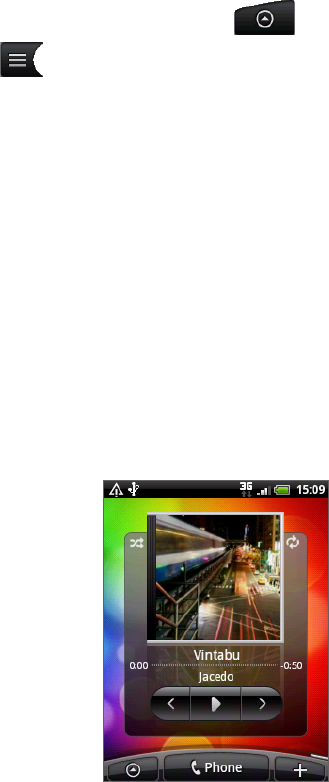
160 Music
Sending music using Bluetooth
You can select a song from the Music application’s Library and send it to someone’s
phone or your computer using Bluetooth.
From the Home screen, tap , and then tap Music.
Tap at the bottom-left corner of the screen to go to the Library.
In the Library, select the song that you want to use as ringtone and then play it
back.
On the Playback screen, press MENU and then tap Share > Bluetooth.
In the next few steps, you’ll be asked to turn on Bluetooth on your phone and
connect to the receiving Bluetooth device so the music can be sent. Follow the
steps in “Sending information using Bluetooth” in the Bluetooth chapter.
About the Music widget
You can use the Music widget to play music right from your Home screen. To find out
how you can add this widget to your Home screen, see “Personalizing your Home
screen with widgets” in the Personalizing chapter.
1.
2.
3.
4.
5.
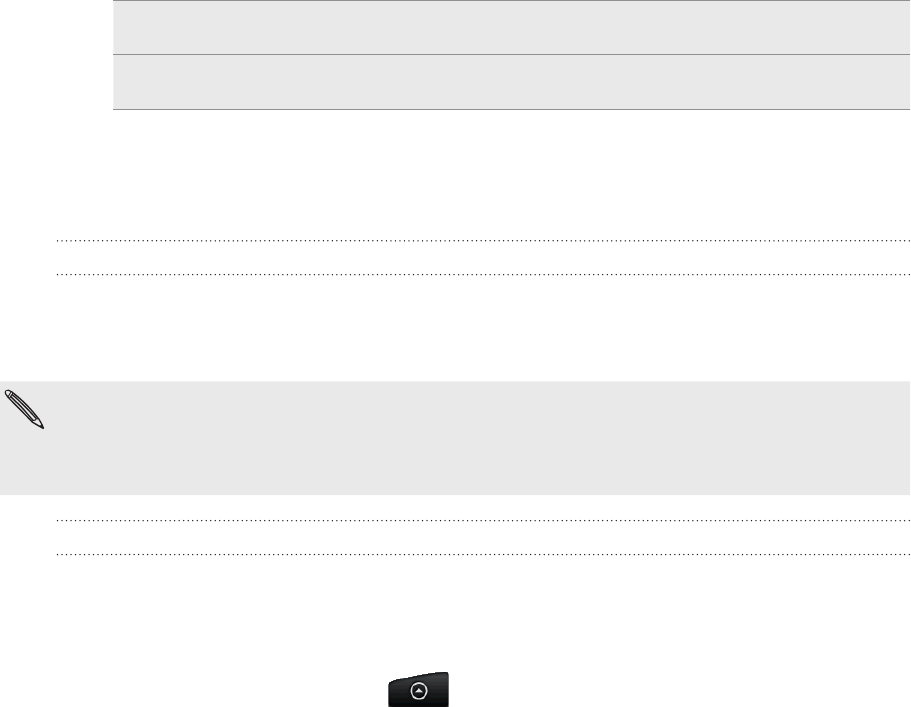
161 Maps and location
Maps and location
Turning on location services
In order to find your location on your phone, you need to enable location sources.
From the Home screen, press MENU, and then tap Settings > Location.
Select one or both of the following:
Use wireless networks Uses Wi-Fi or your mobile data connection to find your
approximate location.
Use GPS satellites Finds your exact GPS location. This requires a clear view
of the sky and more battery power.
Google Maps
About Google Maps
Google Maps lets you track your current location, view real-time traffic situations, and
receive detailed directions to your destination. It also provides a search tool where you
can locate places of interest or an address on a map, or view locations at street level.
You need an active mobile data or Wi-Fi connection to use Google Maps.
To find your location with Google Maps, you need to enable location sources. To learn how,
see “Turning on location services” in this chapter.
The Google Maps application does not cover every country or city.
Viewing locations in Google Maps
Finding your location
To find your location with Google Maps, you need to enable location sources. To learn
how, see “Turning on location services” in this chapter.
From the Home screen, tap > Maps.
On the Google Maps screen, press MENU and then tap My Location. The blue
marker shows your location on the map.
1.
2.
1.
2.
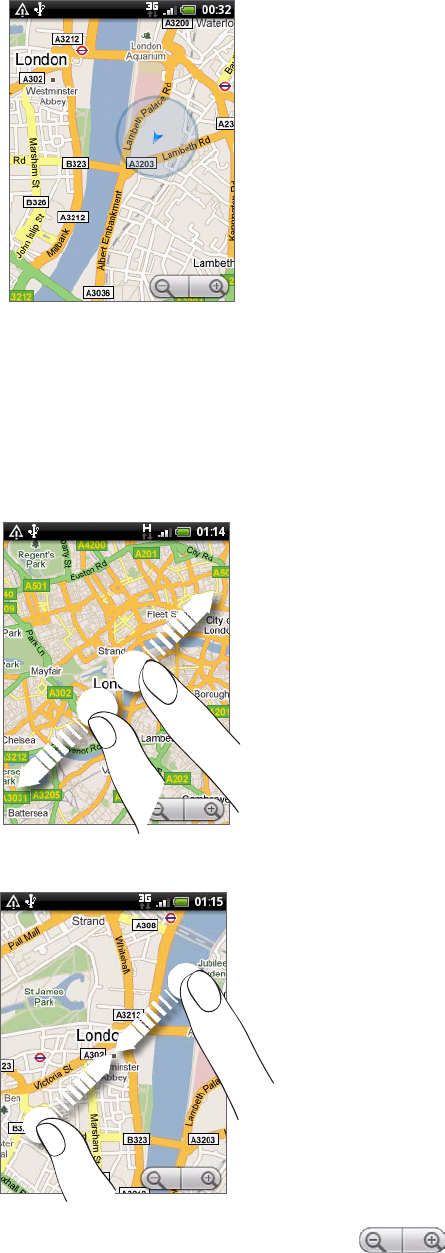
162 Maps and location
Moving on the map
Swipe your finger on the screen or the optical trackball to view other areas of the map.
Zooming in or out of a map
There are several easy ways to zoom in or out:
Spread your thumb and index finger across the map to zoom in.
Pinch your thumb and index finger on the map to zoom out.
Tap the plus or minus side of the Zoom control .
Double-tap a location on the map to zoom in to that location.
Getting an address and additional information for a location
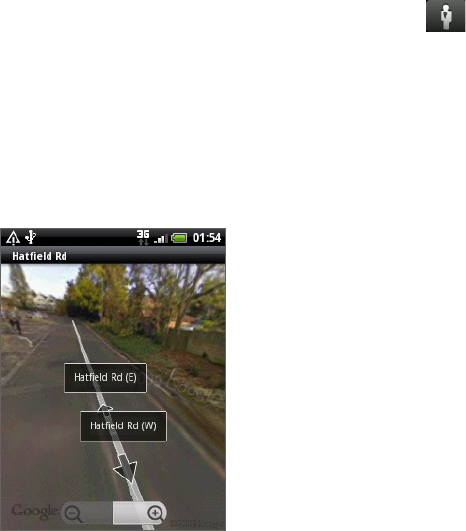
163 Maps and location
1. Press and hold a location on the map. A balloon opens over the location, with
the address and a thumbnail from street view (if available).
2. Tap the balloon to see more information.
You can get directions to the location, check for nearby places of interest, and
more.
Looking at a location in Street View
Street View mode (available only in selected areas) provides a street-level view of the
location.
1. Do one of the following:
Press and hold a location on the map, and then tap the balloon that
appears.
Search for the place you want to view in Street View. See “Searching for
locations and places” in this chapter for details. When you find the place,
tap its balloon.
2. On the location details screen, tap the Street view button .
3. To navigate in Street View, do any of the following:
Swipe your finger on the screen or the optical trackball to pan up or down
or to look in other directions.
Tap the arrows onscreen to move towards the direction pointed by the
arrows.
Press MENU to select from other navigation options.
While viewing a Street View of a location, press MENU and then tap
Compass mode to turn Compass mode on. Tilt, pan, or turn your phone to
view the area around the selected location.
Clearing the map
After you get directions or search on a map, you can clear away the various markers
that such activities have drawn on the map.
When viewing a map, press MENU, and then tap More > Clear Map.
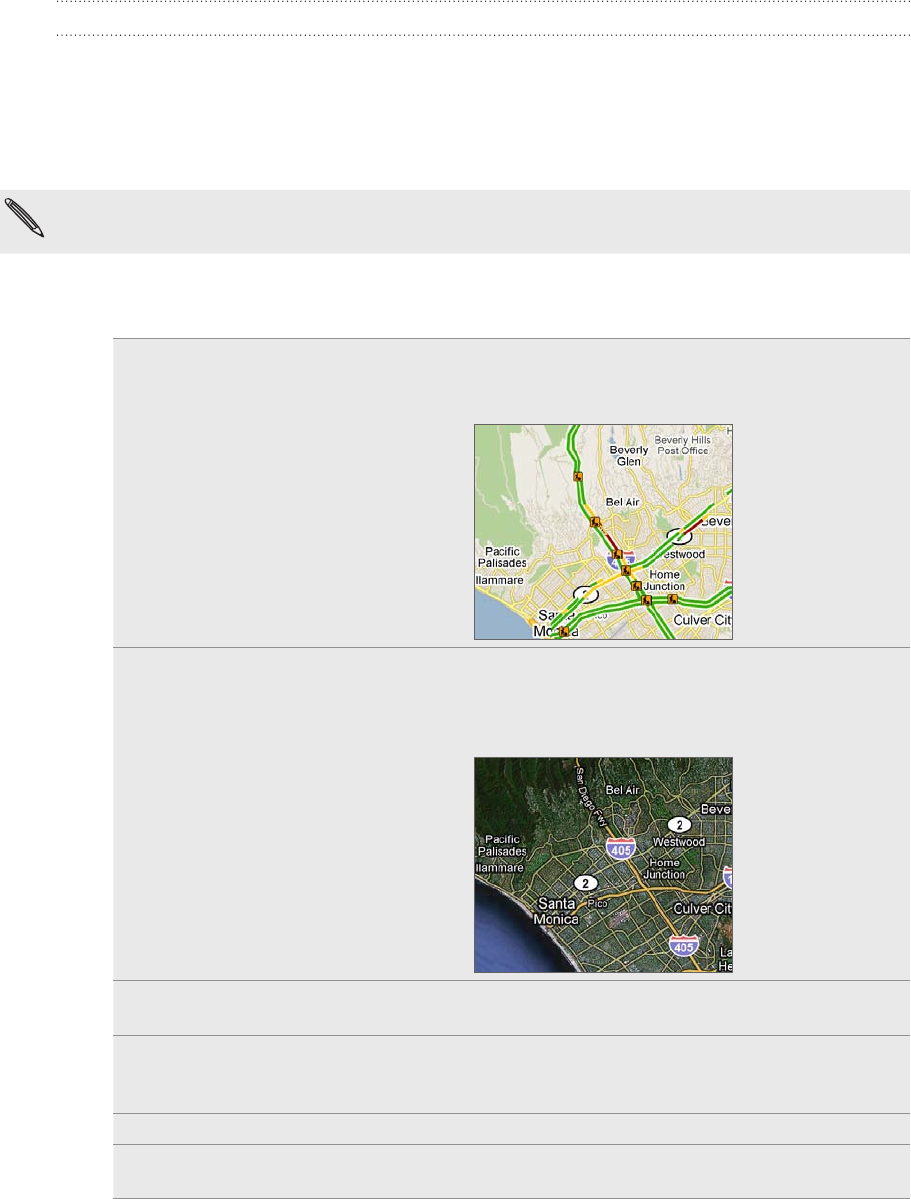
164 Maps and location
Viewing map layers
Initially, Google Maps opens with a street map. You can view additional map layers,
such as satellite images, traffic information, your Google Latitude friends’ locations,
and Wikipedia information on locations. You can also view maps that you and other
people have created in Google Maps on the web. You can view multiple layers at the
same time.
Not all locations have information to support all Map layers or all zoom levels. To learn more
about layers, visit Google Maps on the web: http://maps.google.com/
1. While viewing a map, press MENU, and then tap Layers.
2. Select any of the following:
Traffic (Available only in selected areas.) Real-time traffic conditions are
displayed over roads as color-coded lines. Each color represents
how fast the traffic is moving.
Satellite Google Maps uses the same satellite data as Google Earth™.
Satellite images are not real-time. Google Earth acquires the best
imagery available, most of which is approximately one to three
years old.
Buzz See photos and information about places shared by other people,
or post your own.
Latitude When you have joined Latitude, you can view your friends’
locations as a layer on the map. For information, see “Finding your
friends with Google Latitude (available by country)” in this chapter.
Clear Map Clear layers and view only the street map.
More Layers Select more layers such as transit lines or maps that you have
created in Google Maps on the web.
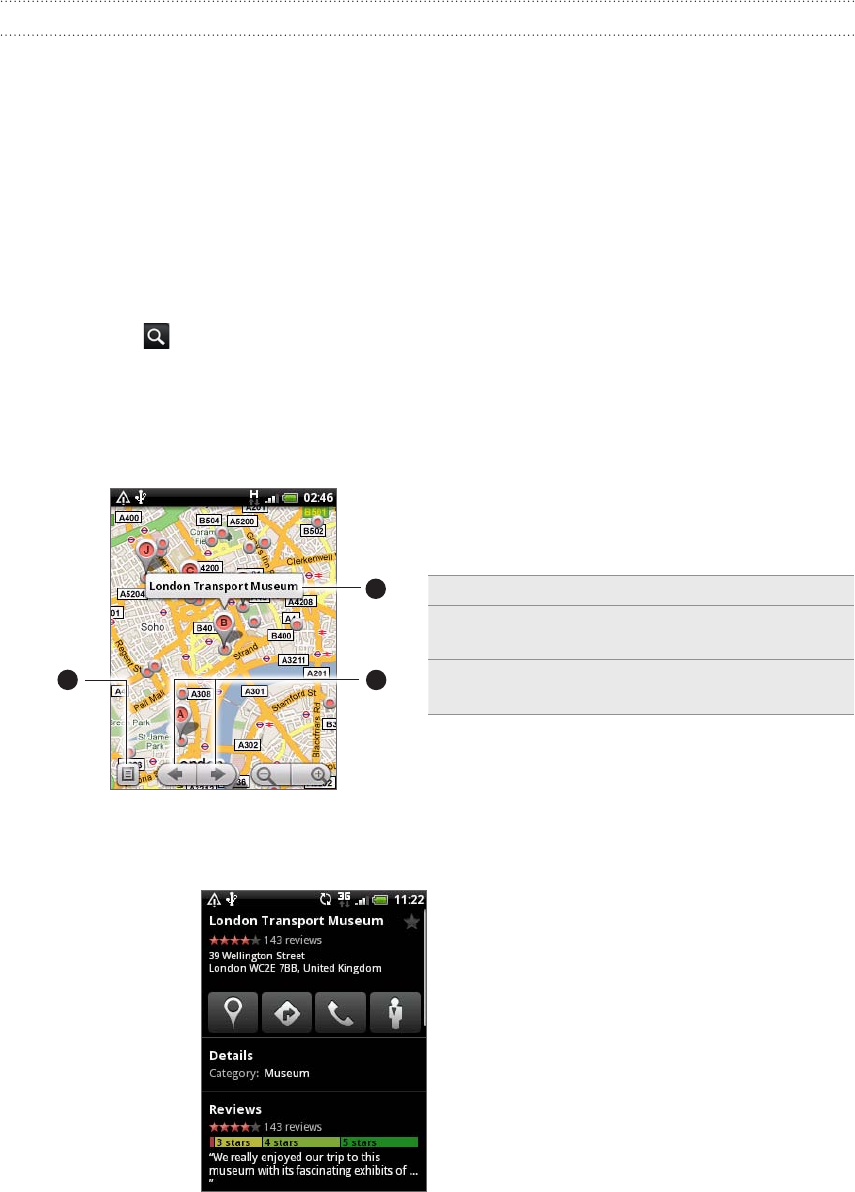
165 Maps and location
Searching for locations and places
In Google Maps, you can search for a location, such as an address, a city or a type of
business or establishment (for example, museums).
As you enter the place to look for, suggested matches from your contacts, the web,
and previously searched items are displayed. You can directly tap a match to search
for it.
While viewing a map, press SEARCH.
Enter the place you want to search in the search box.
Do one of the following:
Tap to search for the place you entered.
Tap a suggested search item.
Viewing search results
The search results will be displayed as markers on the map.
12
31 Show the search results as a list.
2 Select the previous or next marker on the
map.
3 T
ap the balloon to view more information
about the location.
After tapping the balloon that shows the location that you want, you’ll see its address,
rating, and reviews, if available.
Tap the onscreen buttons to get directions, view the location in Street View, if
available, and more. Scroll down the screen for more options.
Tap Details to view additional information.
Swipe left or right across the screen to view the next or previous search
result.
1.
2.
3.
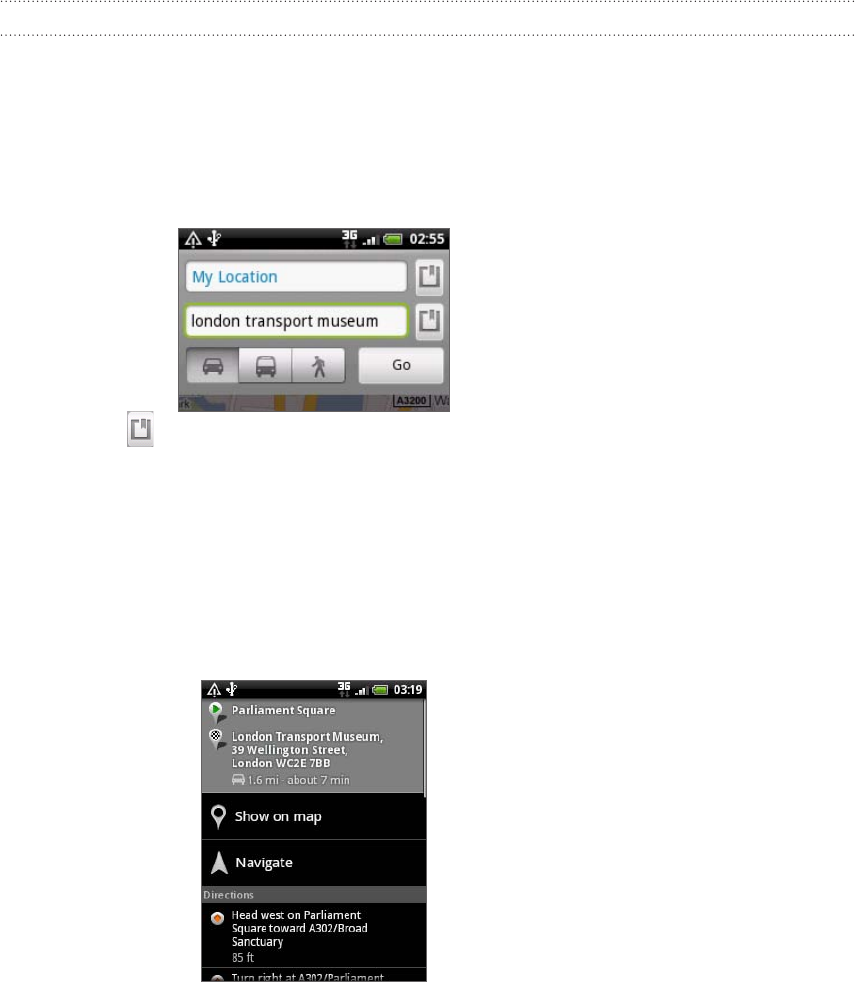
166 Maps and location
Getting directions
Get detailed directions to your destination. Google Maps can provide directions for
travel by foot, public transportation, or car.
While viewing a map, press MENU, and then tap Directions.
Use your current location as the starting point, or enter a location from where to
start in the first text box. Then enter your destination in the second text box.
Or tap to select an address from your contacts or a point that you tap on a
map.
3. Tap the icon for car, public transit, or walking directions.
4. Tap Go.
5. If the place you’ve set as your destination has several locations available, choose
which one to go to.
The next screen displays the directions to your destination in a list.
6. Tap Show on map to view the directions on the map.
7. Tap the arrow buttons on the map to follow the directions.
When you are finished viewing or following the directions, press MENU and then tap
More > Clear Map to reset the map. Your destination is automatically saved in the
Google Maps history.
1.
2.

167 Maps and location
Finding your friends with Google Latitude (available by country)
Google Latitude™ user location service lets you and your friends share locations and
status messages with each other. It also lets you send instant messages and emails,
make phone calls, and get directions to your friends’ locations.
Your location is not shared automatically. You must join Latitude, and then invite your
friends to view your location or accept their invitations.
Joining Latitude
While viewing a map, press MENU and then tap Join Latitude.
Read the privacy policy. If you agree with it, tap Agree & Share.
After you join Latitude, you can start sharing your locations with your friends. Only
friends that you have explicitly invited or accepted can see your location.
Opening Latitude
After you join Latitude, you can open it to find your friends and view their updates.
While viewing a map, press MENU, and then tap Latitude.
Inviting friends to share their locations
1. While viewing a map, press MENU, and then tap Latitude.
2. In Latitude, press MENU, and then tap Add friends.
3. Choose how to add friends:
Select from Contacts Select any number of friends from your Contacts.
Add via email address Enter an email address.
4. Tap Add friends.
5. If prompted, tap Yes.
If your friends already use Latitude, they receive an email request and a
notification on Latitude. If they have not yet joined Latitude, they receive an
email request that tells them to sign in to Latitude with their Google Account.
Responding to an invitation
When you get a sharing request from a friend, you can:
Accept and share back You and your friend can see each other’s locations.
Accept, but hide my location You can see your friend’s location, but they can’t see
yours.
Don’t accept No location information is shared between you and your
friend.
Viewing your friends’ locations
You can view your friends’ locations on a map or in a list.
When you open Maps, your friends’ locations are shown. Each friend is represented by
their picture (from Contacts) with an arrow pointing to their approximate location. If
a friend has chosen to share city-level locations, their picture does not have an arrow
and appears in the middle of the city.
1.
2.

168 Maps and location
To see a friend’s profile and connect, tap the photo. Your friend’s name appears in a
balloon. Tap the balloon to open a screen with details about your friend and many
connection options.
When you open Latitude you see a list of your Latitude friends, with a summary of
their last known locations, status, and so on. Tap a friend in the list to open a screen
with details about the friend and many connection options.
Connecting with and managing friends
Tap a friend’s contact details balloon in map view or tap a friend in list view to open
the friend’s profile. In the profile screen, you can communicate with your friend and set
privacy options.
Show on map Shows the friend’s location on the map.
Chat using Google Talk Opens a Google Talk chat window with that friend.
Send email Opens Gmail/Google Mail with a message addressed to the
friend.
Get directions Gets directions to the friend’s location.
Sharing options Select from the following:
Best available location. Share your precise location
information.
Share only city level location. Share only the city you are in,
not the street-level location. Your friend can see your photo
icon in the middle of the city you are in. To share more
precise location again, tap Best available location.
Hide from this friend. Stop sharing your location with this
friend, in a list or on a map.
Remove this friend Remove the friend from your list and stop sharing locations
with him or her altogether.
Changing privacy settings
You have control over how and when you can be found by your friends. Only the last
location sent to Latitude is stored with your Google Account. If you turn off Latitude
or are hiding, no location is stored.
In Google Maps, press MENU, and then tap Latitude.
Tap your own name, and then tap Edit privacy settings.
Set the following options to your preferences:
Detect your location Let Latitude detect and update your location as you move.
The update frequency is determined by several factors, such
as how recently your location has changed.
Set your location Choose from several options to manually select your
location.
Hide your location Hide your location from all your friends.
Turn off Latitude Disable Latitude and stop sharing your location or status.
You can always join Latitude again.
1.
2.
3.
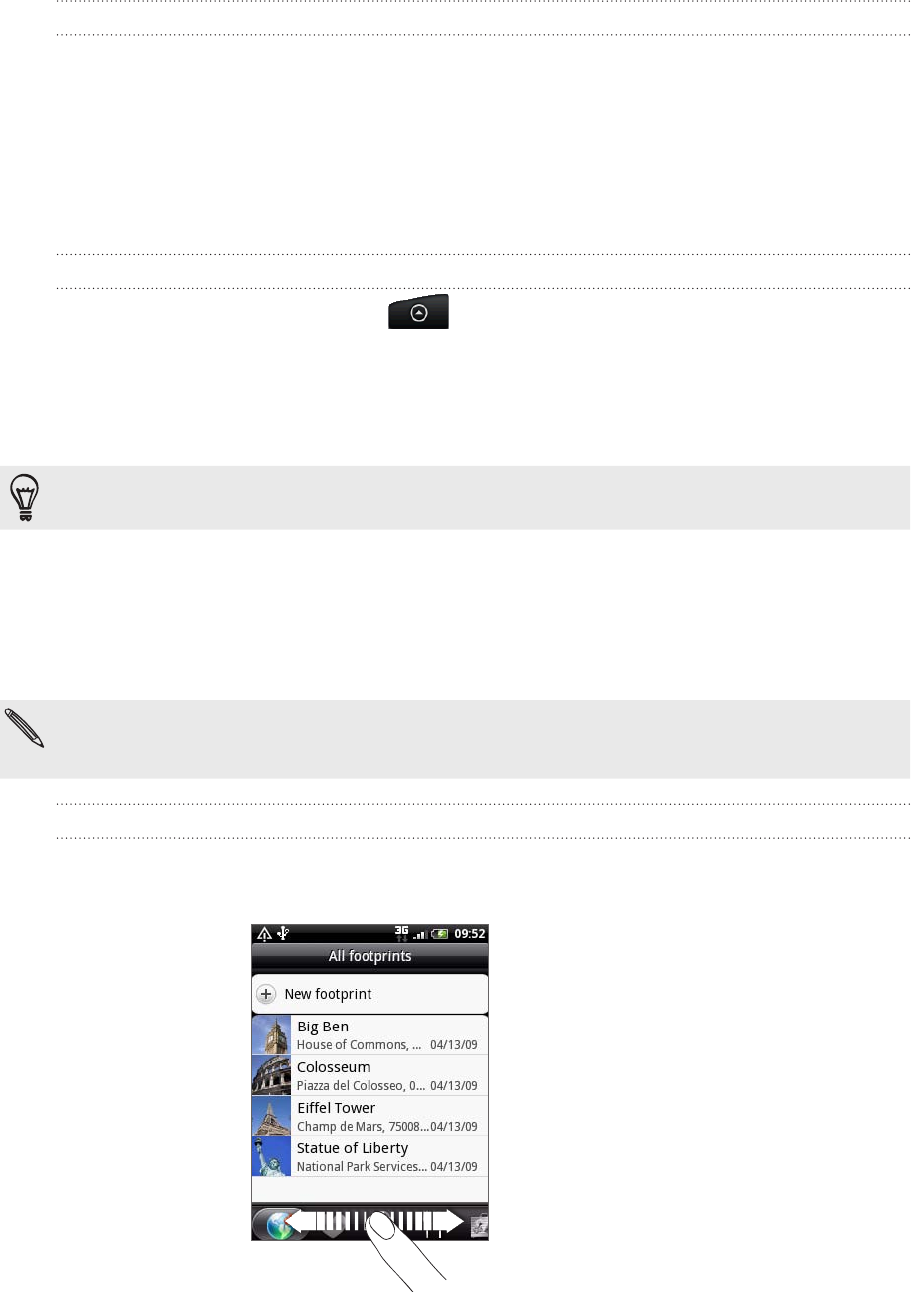
169 Maps and location
HTC Footprints
About HTC Footprints
HTC Footprints™ provides an easy way to record favorite places and revisit those
places. A footprint consists of a photo you take of a location such as a restaurant, a
sightseeing destination, etc., stored together with a precise GPS position and other
information about that location such as the street address and phone number.
The next time you want to visit the same place, simply access the footprint. You can
then dial the phone number or view the location in Google Maps.
Creating a footprint
From the Home screen, tap > Footprints.
Tap New footprint. If GPS is not on, you are prompted to turn it on so that your
phone can use GPS to find your location.
3. Point the camera at the scene you want to show the location. Footprints starts
to use GPS to search for your position.
To change brightness and white balance settings before you take a photo, press MENU, tap
Brightness or White balance, and then choose a setting.
4. Press the optical trackball to capture the photo. If your GPS position has not
been found yet, you are asked whether to find the position on Google Maps,
continue the GPS search, or stop the GPS search. You may also be asked if you
want HTC Footprints to automatically determine the address for the location.
6. Tap Done.
Before pressing Done, you can press MENU, and then tap Edit to change the name, category,
or address of the footprint, enter the phone and website, and add a voice memo to the
footprint.
Revisiting a footprint
1. In the Footprints application, slide your finger across the tabs on the bottom row
to choose a category.
1.
2.
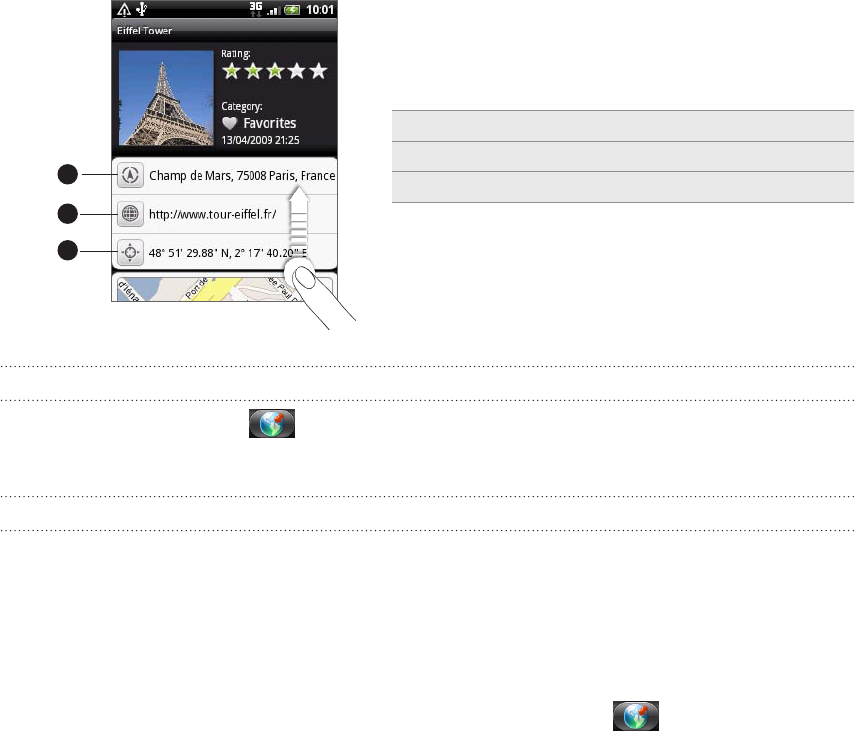
170 Maps and location
2. Tap the footprint you want to revisit.
3. Scroll down to see more information. You can tap the information fields to view
more information about the footprint, call a stored phone number, and more.
1
2
3
1 Search for the address in Google Maps.
2 Open the web page.
3 Show the GPS location in Google Maps.
Editing or deleting a footprint
On the All footprints tab , press and hold the footprint you want to edit or delete,
and then tap Edit or Delete on the options menu.
Exporting your footprints
You can back up footprints by exporting them to a storage card. You can also open
exported footprints files in other applications such as Google Earth on your PC. To
transfer files from your storage card to your computer, see “Copying files to or from
the storage card” in the Getting started chapter.
Do any of the following:
To export all your footprints, on the All footprints tab , press MENU and
then tap Export.
To export all the footprints from a particular category, while viewing that
category, press MENU and then tap Export.
To export a single footprint, open the footprint, press MENU and then tap
Export.
Exported footprints are saved as .kmz files in the Footprints_Data folder on your
storage card. If you exported multiple footprints at one time, they are saved together
in one .kmz file.

171 Maps and location
Importing footprints
You can restore footprints you previously backed up to the storage card. You can also
import .kmz files that you saved in other applications, or use a photo as a footprint.
1. Press MENU, and then tap Import.
2. Do one of the following:
To import saved footprints or another .kmz file from the storage card, tap
Footprints data, and then tap the file you want to import. If a footprint
on your phone is the same as the one you want to import, you are asked
whether you want to overwrite it.
To import a photo, tap Picture, navigate to the photo you want to import,
and then tap the photo. You can then add Footprints information such as
location and category.
About the Footprints widget
Use the Footprints widget to view and access your footprints right on the Home
screen. To find out how to add widgets, see “Personalizing your Home screen with
widgets” in the Personalizing chapter.

172 More apps
More apps
Watching videos on YouTube
The YouTube application groups and lists videos by categories: Most viewed, Most
discussed, Most recent, and Top rated.
You must have an active Wi-Fi or data connection to access YouTube.
The first time you use certain YouTube functions such as video sharing, sign in using your
YouTube or Google Account, if you’re asked to do so.
From the Home screen, tap > YouTube.
Scroll through the list of videos, and then tap a video to watch it. The screen
automatically switches to landscape view when you play a video.
While watching a video, you can:
Tap the screen to display the playback controls. When the playback controls
are displayed, you can pause, skip forward or backward, or drag the slider to
the point in the video you want to watch.
Press MENU to rank, comment on, share, flag as inappropriate, and interact
with the video in other ways.
4. Press BACK to stop playback, and return to the video list.
Searching for videos
On the YouTube main screen, press SEARCH.
Enter a search keyword, and then tap .
The number of search results appears below the status bar. Scroll through the
results and tap a video to watch it.
Clearing the search history
On the YouTube main screen, press MENU, and then tap Settings.
Tap Clear search history, and then tap OK when prompted.
1.
2.
3.
1.
2.
3.
1.
2.
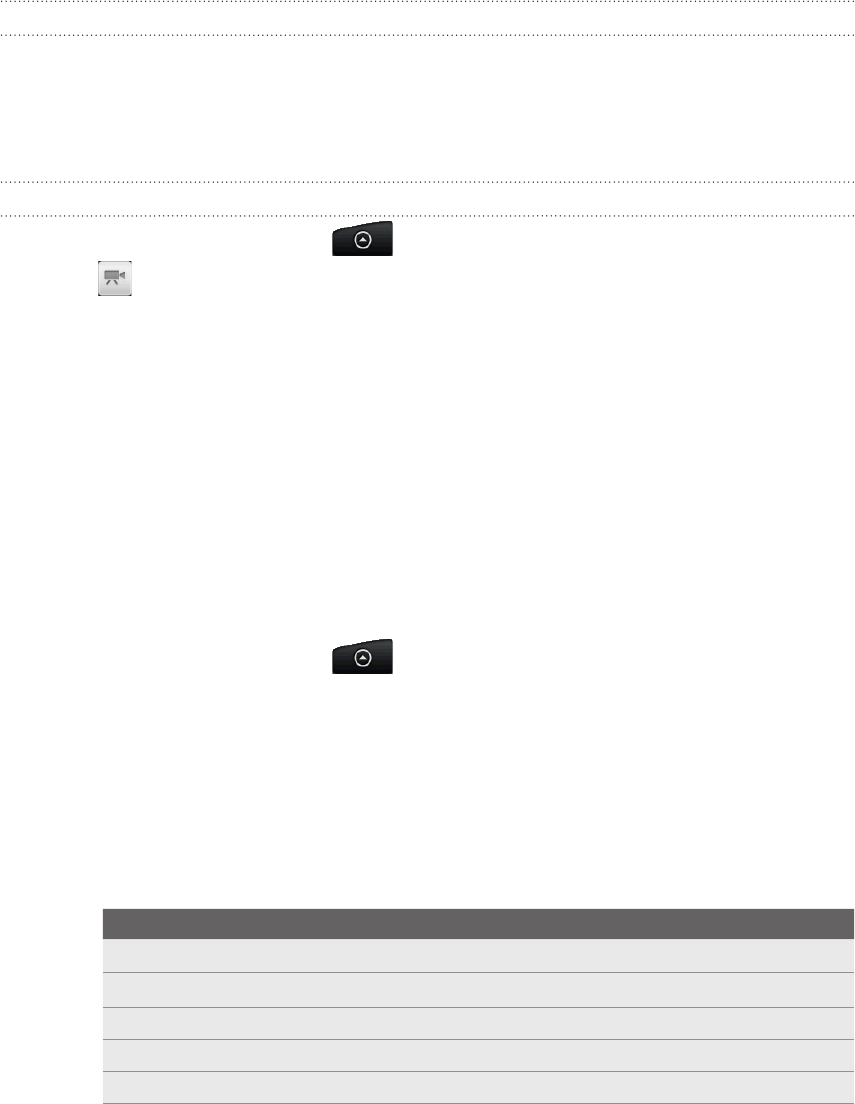
173 More apps
Sharing a video link
You can share a video by sending its link to your contacts.
While watching a video, press MENU, and then tap Share.
Choose how you want to share the video link.
Capturing a video and sharing it on YouTube
From the Home screen, tap > YouTube.
Tap .
Press the optical trackball to start capturing video. When you are done
capturing, press the optical trackball again. Tap Done.
Enter a title, description, and tags for your video.
Set the privacy level.
Tap Upload.
Viewing a PDF
Use PDF Viewer to view PDF files that you have downloaded or copied to the phone’s
storage card.
From the Home screen, tap > PDF Viewer.
On the Open file screen, tap the file you want to view.
While viewing a PDF, you can:
Slide your finger on the screen to pan or go through the pages of the PDF.
To zoom in, spread your thumb and index finger across the page you’re
reading. To zoom out, pinch your thumb and index finger on the page.
Press MENU, and then do the following:
Tap To
Open Open another PDF file.
Toolbar/Toolbar off Switch between showing and hiding the toolbar.
Zoom Display pages to either Fit to screen or Fit to width.
Go to Go to a specific page on the PDF.
Search Search the PDF.
Turn your phone sideways (turn to the left) to view the PDF file in landscape
mode. The screen orientation automatically adjusts depending on how you
hold the phone.
1.
2.
1.
2.
3.
4.
5.
6.
1.
2.
3.

174 More apps
Viewing documents, presentations, and
spreadsheets
Quickoffice lets you view Microsoft Office Word, Microsoft Office Excel, and Microsoft
PowerPoint files on your phone. Quickoffice supports viewing of Microsoft Office 2003
and 2007 Word (.doc), Excel (.xls), PowerPoint (.ppt) and text (.txt) files.
Make sure you have copied the files to the phone’s storage card before you open Quickoffice.
See “Copying files to or from the storage card” in the Getting started chapter to find out how
to copy files to the storage card.
From the Home screen, tap > Quickoffice.
If you have a long file list, you can do the following to easily locate the file that
you want:
Press MENU and then tap Sort to arrange files by Name or Date.
Press SEARCH to enter the partial filename. Matching results will then be
displayed.
3. Tap the file you want to open.
4. While viewing a file, you can:
Slide your finger on the screen to pan or go through the pages of the file.
Pinch the screen to zoom in or out or use the zoom controls on the screen
to zoom in or out.
After you zoomed in on a slide in a PowerPoint file, double-tap the screen to
fit the slide to the width of the screen.
Press MENU, and then tap Worksheet to view other worksheets in an Excel
file.
Tap a URL link in a Word or PowerPoint file to open the web page in the
web browser.
When you open Word documents, Quickoffice reformats the text to make it
fit the width of the screen. Double-tap the screen to switch to normal view
so you can view the page layout.
Quickoffice does not reflow text in tables.
1.
2.
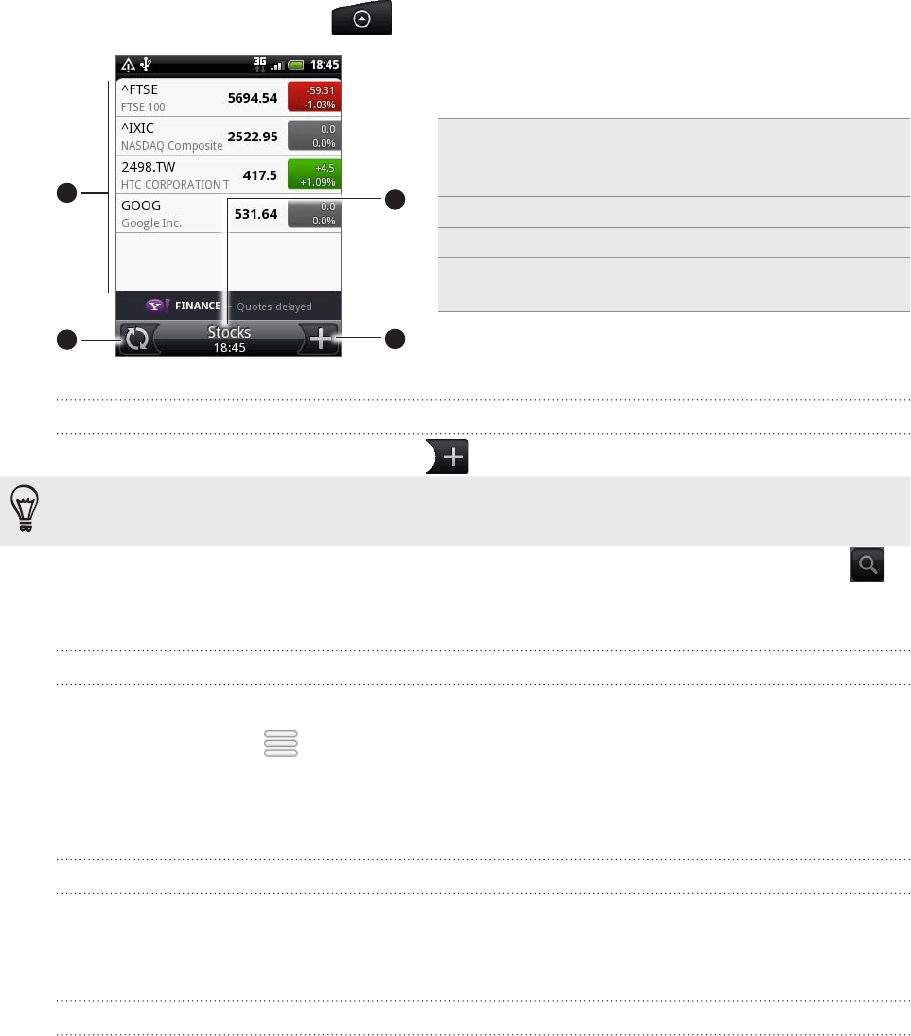
175 More apps
Keeping track of your stocks
Use the Stocks application to get the latest stock updates for stock quotes and market
indices you follow.
From the Home screen, tap > Stocks.
23
4
1
1 From the list of stock quotes and market
indices, tap an item to view its intraday chart
and other details.
2 Tap to update the stock information.
3 Tap to add a stock quote or stock market index.
4 Shows the time the information was last
updated.
Adding a stock quote or stock market index
On the Stocks main screen, tap at the bottom-right corner of the screen.
If there are no stock quotes or indices onscreen, tap Tap here to add a stock or index at the
top of the screen.
2. Enter the stock quote or stock market index on the text field, and then tap .
3. On the results list, tap the stock quote or stock market index you want to add.
Changing the stock list order
On the Stocks main screen, press MENU, and then tap Rearrange.
Press and hold at the end of the item you want to move. When the row is
highlighted in green, drag it to its new position, and then release.
Tap Done.
Deleting stock quotes and indices
On the Stocks main screen, press MENU, and then tap Delete.
Select the items you want to delete and then tap Delete.
Manually updating stock information
On the Stocks main screen, press MENU, and then tap Update.
1.
1.
2.
3.
1.
2.
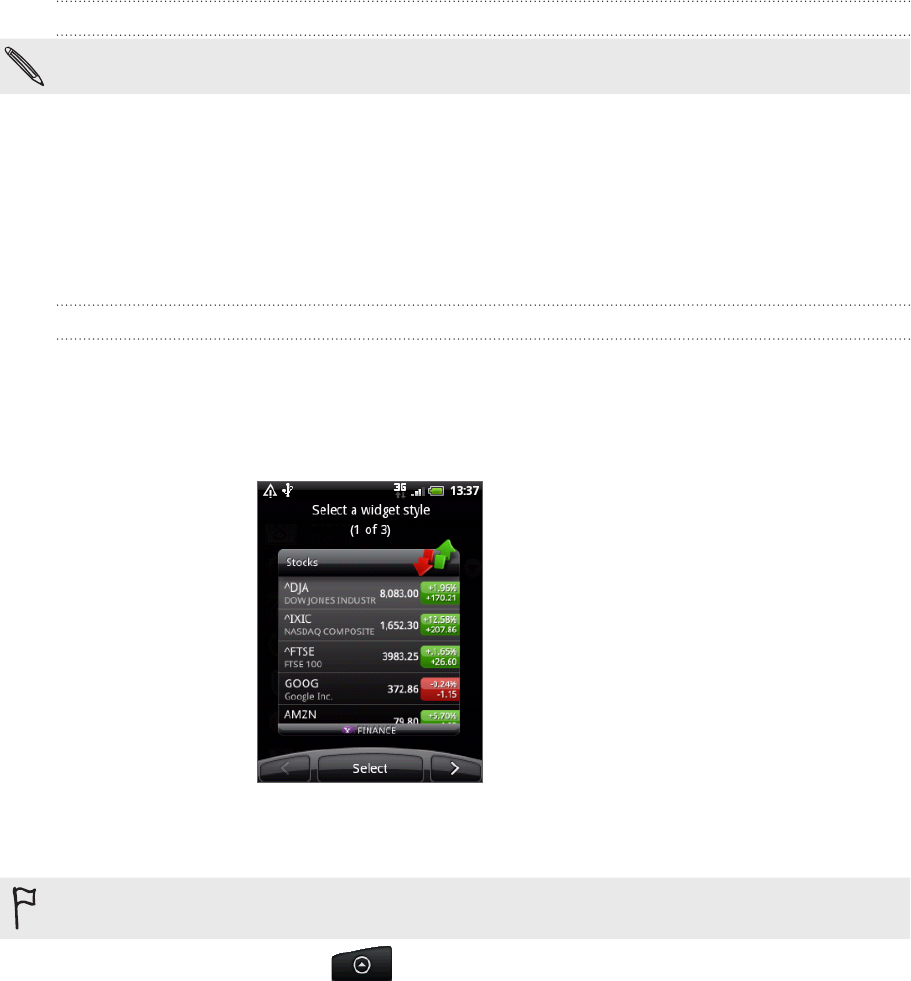
176 More apps
Changing update schedule and color settings
Downloading stock information automatically may incur additional fees from your mobile
operator.
On the Stocks main screen, press MENU, and then tap Settings.
Select the Auto-sync data check box.
Tap Update schedule, and then choose a time interval for checking updates.
Tap Set color for price raise. Then change the color for displaying stock price
increases to either red or green, depending on what’s being used in your country.
About the Stocks widget
Use the Stocks widget to instantly check stock updates right on your Home screen.
It comes in different looks and styles. To find out how to add this widget to your
Home screen, see “Personalizing your Home screen with widgets” in the Personalizing
chapter.
Using FM Radio
You need to connect a headset first to the audio jack of your phone to use FM Radio. FM
Radio uses the stereo headset as the FM radio antenna.
From the Home screen, tap > FM Radio.
The first time you open FM Radio, it automatically scans for available FM stations,
saves them as presets, and plays the first FM station found.
1.
2.
3.
4.
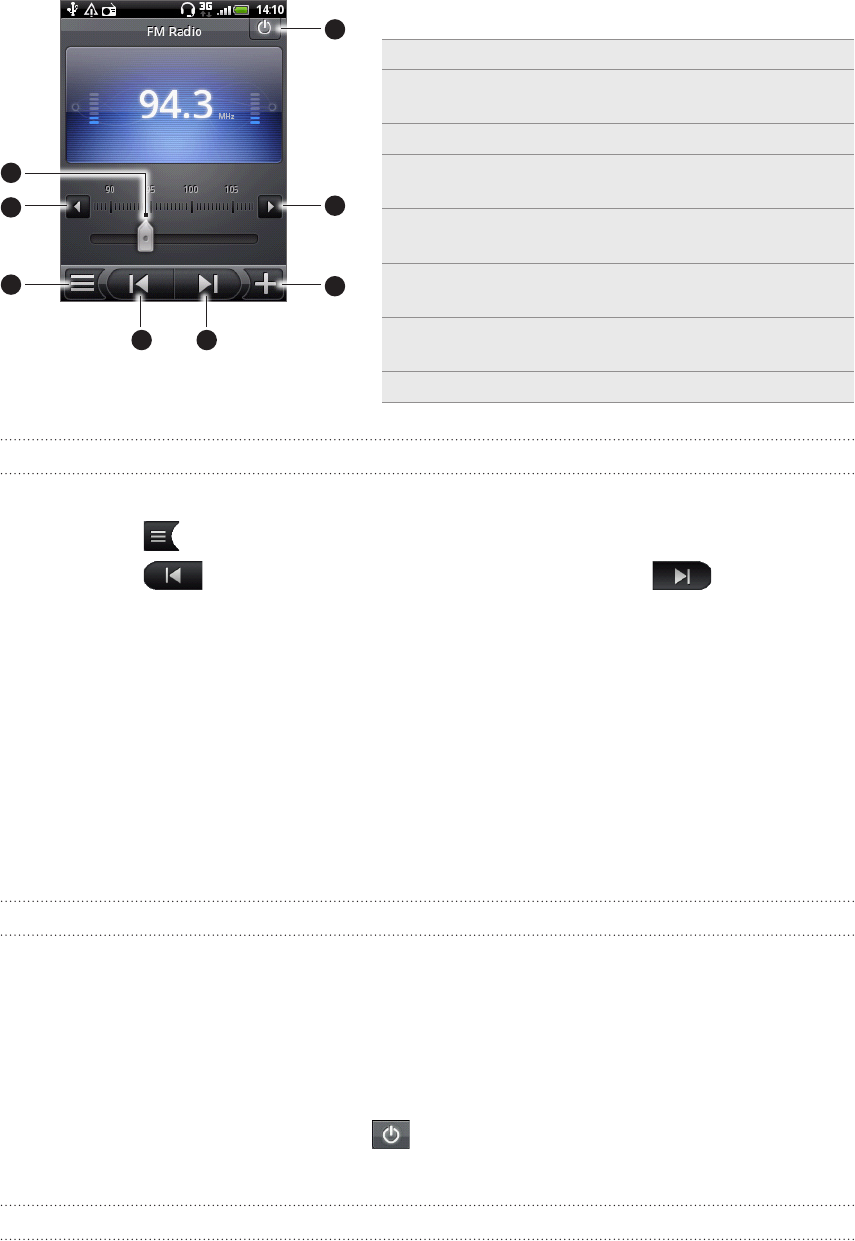
177 More apps
2
3
45
6
7
8
1
1 Drag to tune in to a frequency on the FM band.
2 Tap to fine tune the radio frequency by -0.1
MHz.
3 View the All presets list.
4 Tap to search the FM band for the previous FM
station.
5 Tap to search the FM band for the next FM
station.
6 Tap to change the name of the current station
you are tuned into.
7 Tap to fine tune the radio frequency by +0.1
MHz.
8 Switch off and close FM Radio.
Listening to an FM station
On the FM Radio screen, you can:
Tap and then select a station you want to listen to.
Tap to go to the previous available FM station, or to go to the
next available FM station.
Press the VOLUME UP and VOLUME DOWN buttons on the side of the
phone to adjust the volume.
To repeat scanning and saving of FM stations, press MENU, and then tap
Scan & Save.
Press BACK to stop the auto-scan.
Press MENU to change the sound to Mute or Mono.
You can also switch the sound output between the Speaker and Headset.
Closing or turning off FM Radio
Press BACK to close the FM Radio screen.
FM Radio continues to run in the background, and you can still listen to the radio while
using other applications on your phone.
To go back to the FM Radio screen, slide open the Notifications panel, and then tap
FM Radio.
On the FM Radio screen, tap on the upper-right corner of the FM Radio
screen to turn off and close FM Radio.
About the FM Radio widget
Use the FM Radio widget to listen to your favorite FM stations right on your Home
screen. To find out how to add this widget to your Home screen, see “Personalizing
your Home screen with widgets” in the Personalizing chapter.
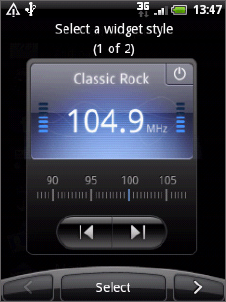
178 More apps
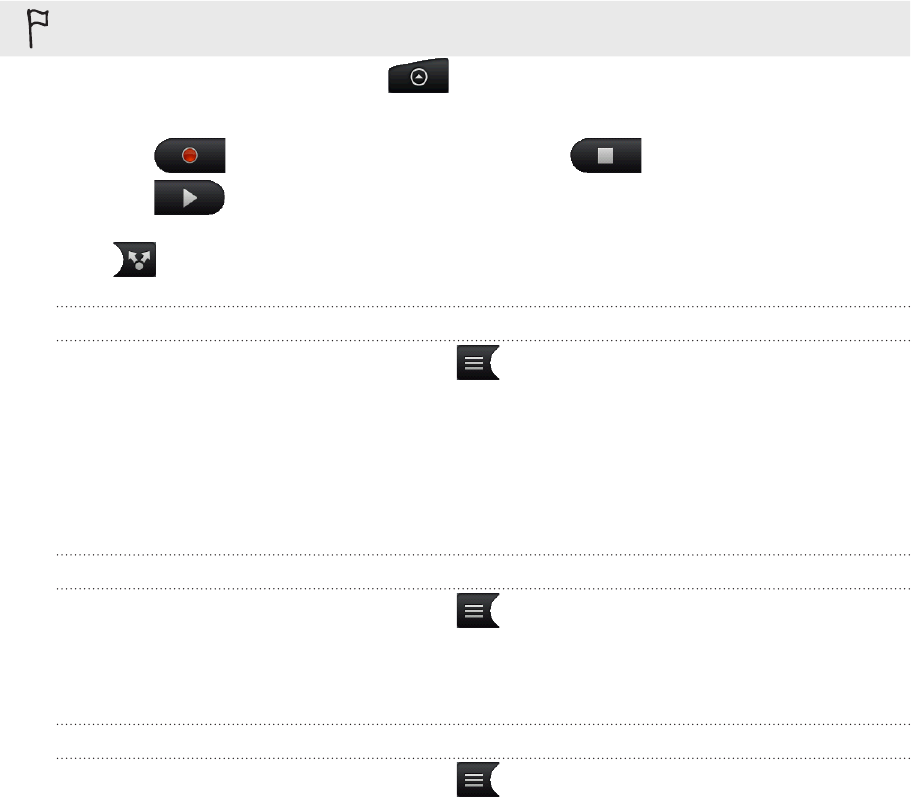
179 More apps
Recording your voice
Voice Recorder is useful for quickly recording your thoughts. You can also record your
voice and set it as a ringtone.
You need to have a microSD card on your phone to use Voice Recorder.
From the Home screen, tap > Voice Recorder.
Hold the phone’s microphone near your mouth.
Tap to start recording a voice clip. Tap to stop recording.
Tap to play back the voice recording.
To quickly share the voice recording through Bluetooth, email, or message, tap
.
Sharing a voice clip
On the Voice Recorder screen, tap .
Press and hold the voice recording you want to share, and then tap Share on the
options menu.
On the Share options menu, choose how you want to share the voice recording.
To find out how to send files through Bluetooth, see the Bluetooth chapter.
Setting a voice clip as a ringtone
On the Voice Recorder screen, tap .
Press and hold the voice recording you want to set as a ringtone, and then tap
Set as ringtone on the options menu.
Renaming a voice clip
On the Voice Recorder screen, tap .
Press and hold the voice recording you want to rename, and then tap Rename
on the options menu.
Enter the name, and then tap Save.
1.
2.
3.
4.
5.
1.
2.
3.
1.
2.
1.
2.
3.
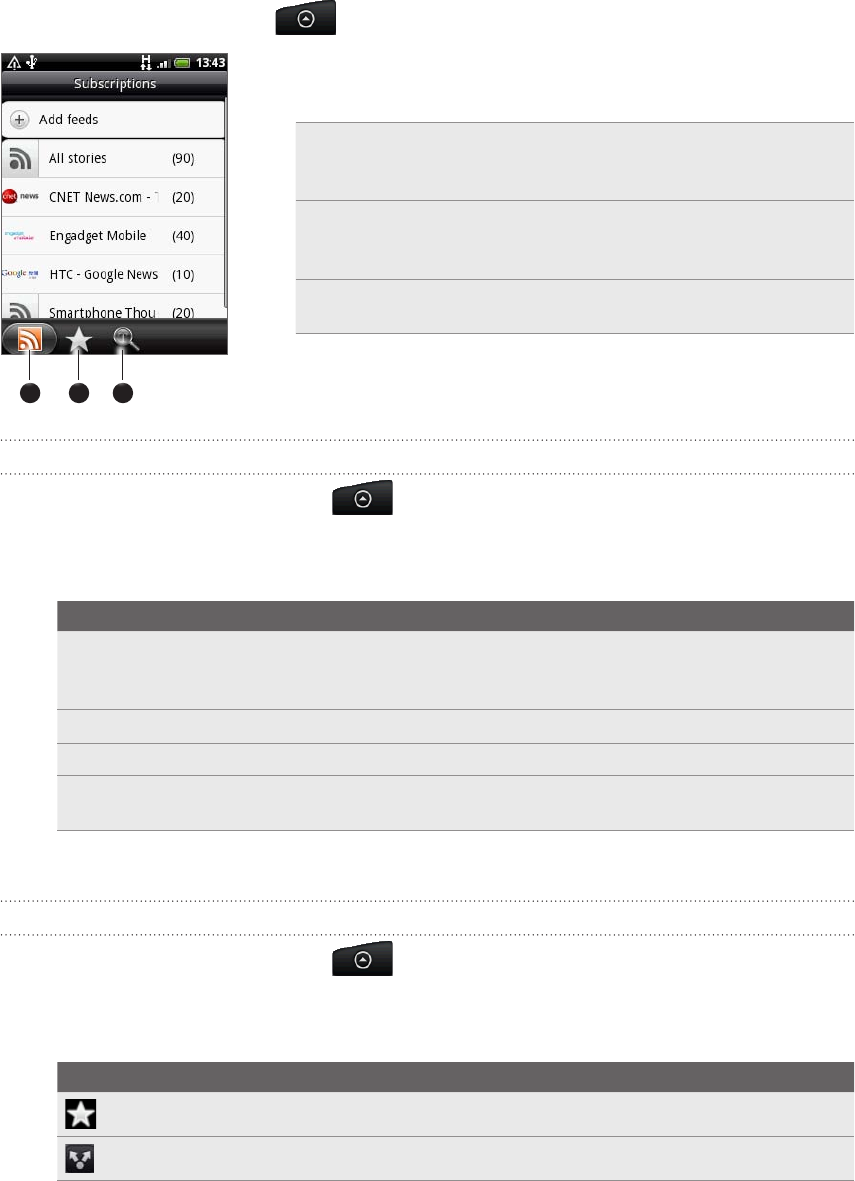
180 More apps
Reading news feeds
Use the News application to subscribe to news feeds and keep up with the latest buzz
on the Internet. Choose from a selection of channels that cover top blogs, news sites
or sports pages, or get news updates based on the keywords you select.
From the Home screen, tap > News.
23
1
1 Subscriptions tab Lists your subscribed channels.
To find out how to subscribe, see
“Subscribing to news channels.”
2 Starred tab Lists channels containing stories that
you have starred. See “Starring a
story.”
3 Keywords tab Lists the keywords you have searched
and added. See “Adding a keyword.”
Subscribing to news channels
From the Home screen, tap > News.
On the Subscriptions tab, tap Add feeds.
Do one of the following:
Tap To
Any category
(such as Blogs, Entertainment,
Sports, and more)
Choose from popular news feeds.
Search more Search the Web for other channels.
Add Google news feed Subscribe to Google News channel. channel.
Add from URL Enter the complete URL of a news feed to subscribe
to.
4. After selecting the channel or channels to subscribe to, tap Add.
Reading a story
From the Home screen, tap > News.
On the Subscriptions tab, tap a channel.
Tap a story to read it. While reading the story, you can:
Tap To
Star the story as a favorite.
Share the story via a message (link to the story only) or email.
1.
2.
3.
1.
2.
3.
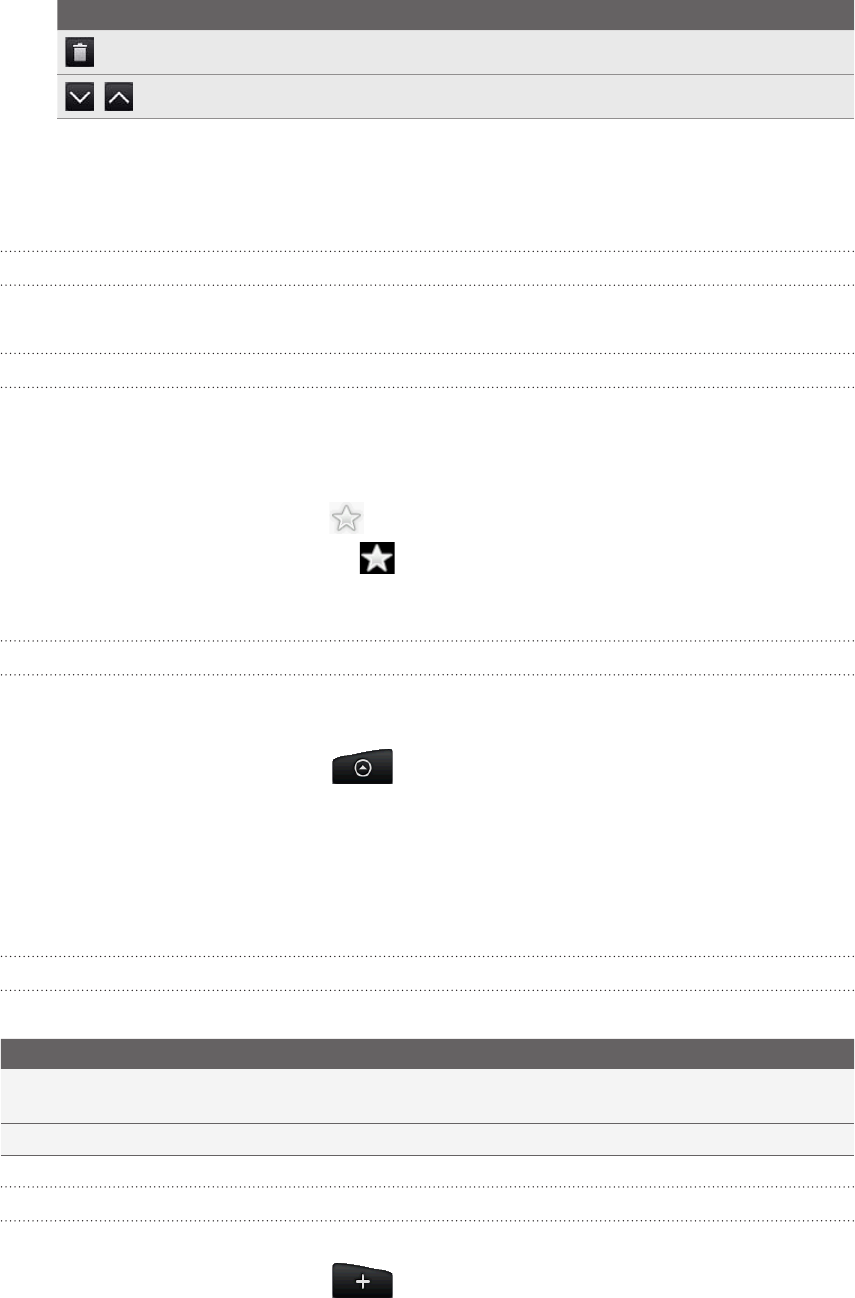
181 More apps
Tap To
Delete the story from the stories list.
Go to the next or previous story in the channel
4. If you want to read the whole story, tap Read full article. This opens the story
in the web browser. See “Using your phone’s web browser” in the Web browser
chapter to learn how to navigate the web page.
Manually checking for new stories
On the Subscriptions tab, press MENU, and then tap Refresh.
Starring a story
Star your favorite stories to make it easy to come back to them. Starred stories are
displayed on the Starred tab.
Do one of the following:
On a list of stories, tap next to a story.
While reading a story, tap near the top-right corner of the screen.
You can remove the star from a story by tapping the star icon again.
Adding a keyword
Easily find stories the interest you by entering a search keyword. Stories that contain
the keyword are grouped together on the Keywords tab.
From the Home screen, tap > News.
On the Keywords tab, tap Add keywords.
Enter the keyword, and then tap Add.
Your new keyword is displayed on the Keywords tab. Tap the keyword to show the
stories that contain that keyword.
Changing update schedule and font settings
In the News application, press MENU, tap Settings, and then do the following:
Tap To
Update schedule Choose a time interval to get automatic updates of the channels you
are subscribed to, or select Manual.
Font size Choose the font size to use for displaying stories.
Adding the News widget
Read snippets of stories that you have subscribed to right on the Home screen.
From the Home screen, tap > Widget > News.
Choose the widget style, and then tap Select.
1.
2.
3.
1.
2.
182 More apps
Select the channel whose stories you want to read on the widget.
Drag the widget to a blank space on the Home screen, and then release.
3.
4.
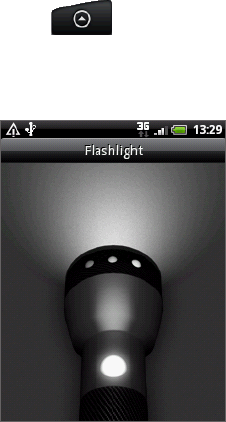
183 More apps
Using Flashlight
Never get caught in the dark again. The Flashlight application turns on your phone’s
LED flashlight to shine a light wherever you need it.
On the Home screen, tap > Flashlight.
The application then plays a short animation to show you how to adjust brightness
and turn the light on or off.
To adjust the brightness of the light, slide your finger left or right on the head
of the flashlight.
To turn the light on or off, tap the switch on the flashlight handle.
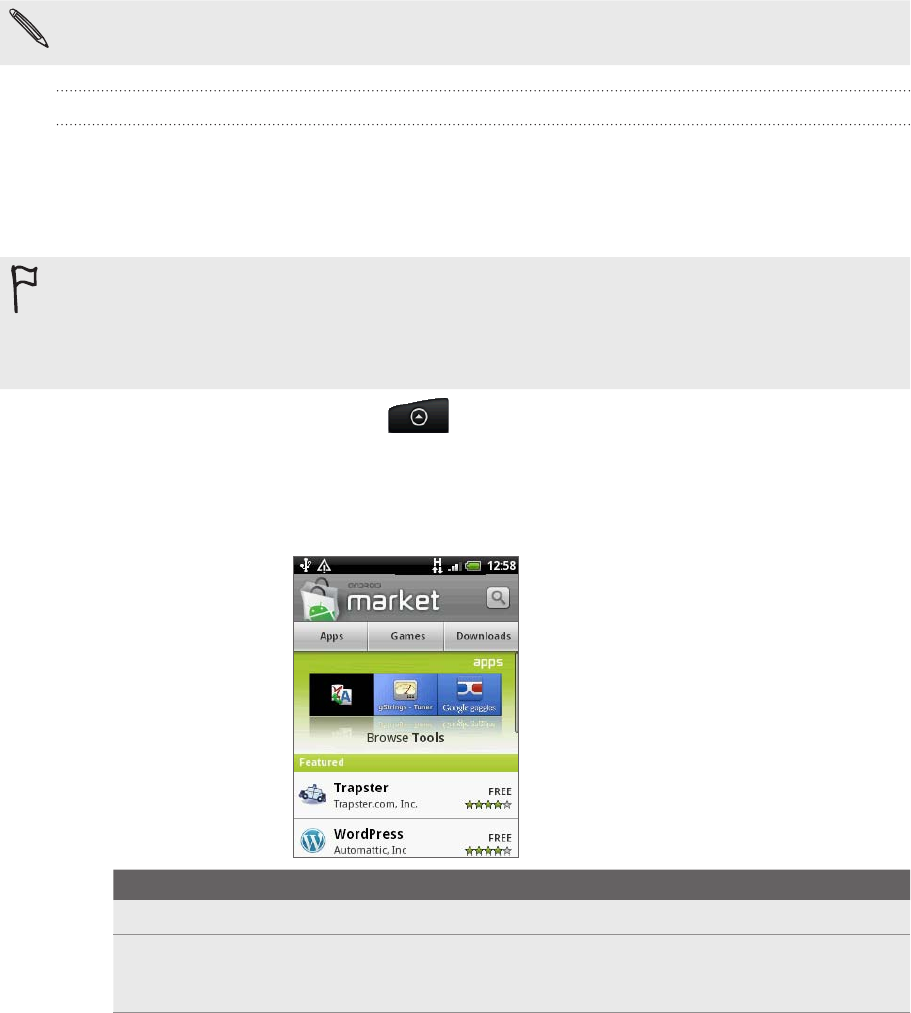
184 More apps
Finding and installing apps from Android
Market
Android Market™ is the place to go to find new apps for your phone. Choose from a
wide variety of free and paid apps ranging from productivity apps, entertainment, to
games. When you find an app you want, you can easily download and install it on your
phone with just a few taps of your finger.
To access Android Market, you must first connect to the Internet using your phone’s
Wi-Fi or data connection and sign in to your Google Account.
Paid apps are currently only available in certain countries.
Finding and installing an application
When you install apps from Android Market and use them on your phone, they may
require access to your personal information (such as your location, contact data, and
more) or access to certain functions or settings of your phone. Download and install
only apps that you trust.
You need a Google Checkout account to purchase items on Android Market. See “Creating a
Google Checkout account” to set up a Google Checkout account if you do not have one.
Be cautious when downloading apps that have access to your phone’s functions or a
significant amount of your data. You’re responsible for the results of using downloaded apps
on your phone.
1. From the Home screen, tap > Market.
When you open Android Market for the first time, the Terms of Service window
will appear. Tap Accept to continue.
2. To find an app in Android Market:
To Do this
Browse featured apps Scroll through the list of featured apps.
Browse apps by
categories
Tap Apps or Games, and then tap a category. Under a
category, you can filter the apps by Top paid, Top free or Just
in.
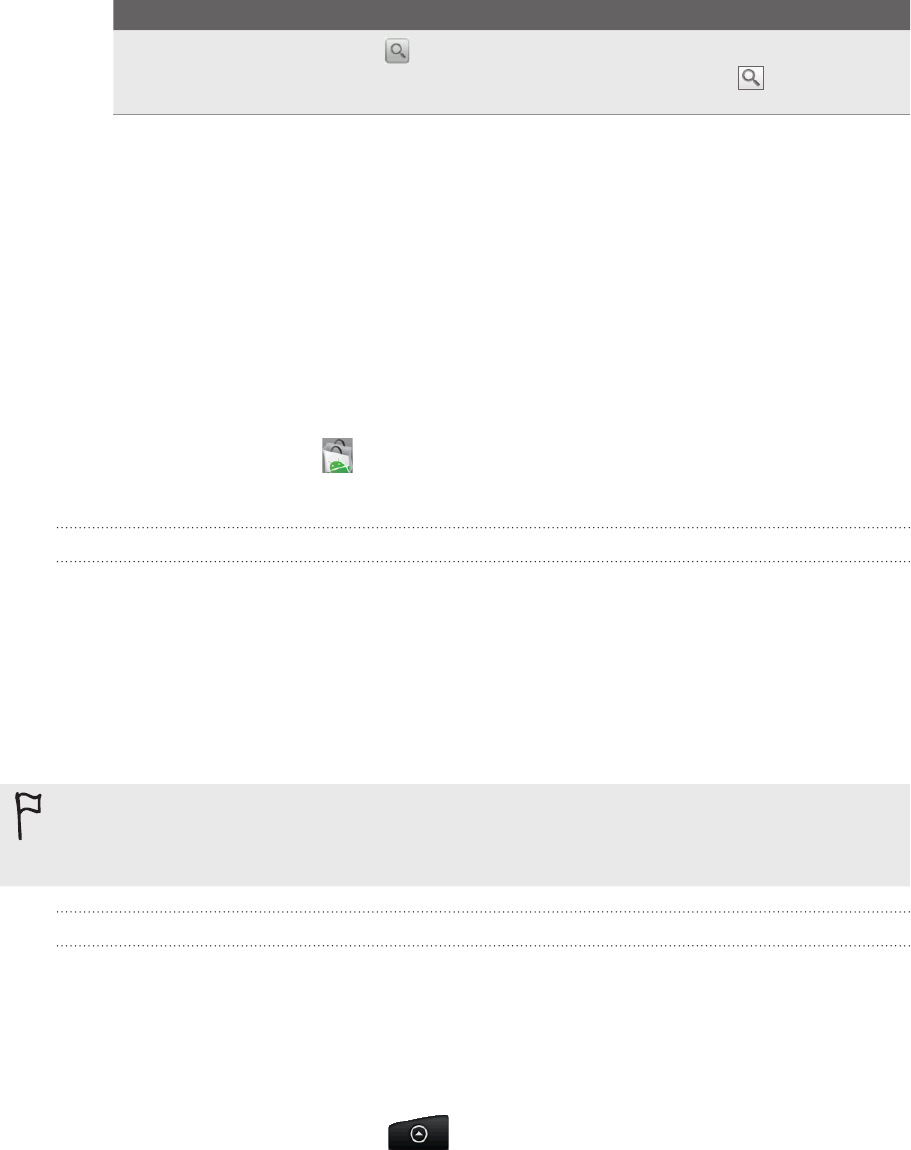
185 More apps
To Do this
Search for an app Tap on the Android Market home screen, enter the name or
type of app you’re looking for, and then tap to the right of
the search box.
3. Tap an app to read a description about the app and user reviews.
4. Tap Install (for free applications) or Buy (for paid applications).
The subsequent screen notifies you whether the app will require access to your
personal information or access to certain functions or settings of your phone.
5. If you agree to the conditions, tap OK to begin downloading and installing the
app.
If you selected a paid application, after tapping OK, you will be redirected to the
Google Checkout screen to pay for the application before it’s downloaded to
your phone.
After installing an app, tap to return to Android Market home. You can also press
MENU, and then tap Home.
Creating a Google Checkout account
You must have a Google Checkout account associated with your Google Account to
purchase items from Android Market.
To create a Google Checkout account, do one of the following:
On your computer, go to http://checkout.google.com.
The first time you use your phone to buy an app from Android Market, follow
the prompts onscreen to enter your billing information.
When you’ve used Google Checkout once to purchase an application from Android Market,
the phone remembers your password, so you don’t need to enter it the next time. For this
reason, you should secure your phone to prevent others from using it without your permission.
See the Security chapter to learn how to secure your phone.
Requesting a refund for an application
If you are not satisfied with an application, you can ask for a refund within 24 hours of
the purchase. Your credit card will not be charged and the application will be removed
from your phone.
If you change your mind, you can install the application again, but you can’t request a
refund a second time.
From the Home screen, tap > Market > Downloads.
Tap the application you want to uninstall for a refund. The details screen for the
application opens.
Tap Uninstall & refund. Your application is uninstalled and the charge is
cancelled.
Choose the reason for removing the application, and then tap OK.
1.
2.
3.
4.
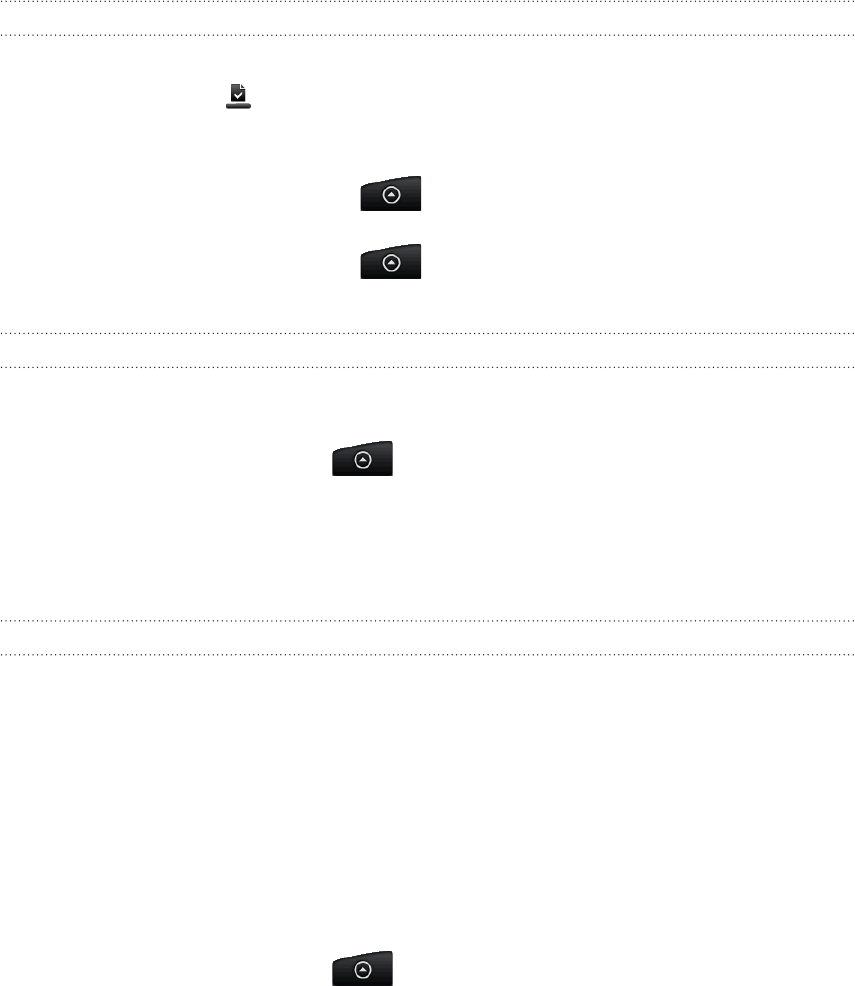
186 More apps
Opening an installed application
Do one of the following:
If you see the icon on the status bar, open the Notifications panel, and
then tap the app to open it. See “Opening the Notifications panel” in the
Getting started chapter.
From the Home screen, tap > Market > Downloads. On the Downloads
screen, tap the app to open it.
From the Home screen, tap . On the All apps screen, locate the app,
and then tap it.
Uninstalling an application
You can uninstall any application that you have downloaded and installed from
Android Market.
From the Home screen, tap > Market > Downloads.
Tap the application you want to uninstall, and then tap Uninstall.
When prompted, tap OK to remove the application on your phone.
Choose the reason for removing the application, and then tap OK.
Getting help
If you ever need help or have questions about Android Market, press MENU, and then
tap Help. The web browser will take you to the Android Market Help web page.
Sharing games and applications
Having fun with a game or application that you downloaded from Android Market?
Share it instantly with your circle of friends.
For your friends to link to the game or application and download it from Android
Market, they must be using an Android phone.
1. From the Home screen, tap .
2. Tap App Sharing. Or, press MENU and then tap Share.
You’ll then see the list of games and applications that you downloaded and
installed from Android Market.
1.
2.
3.
4.
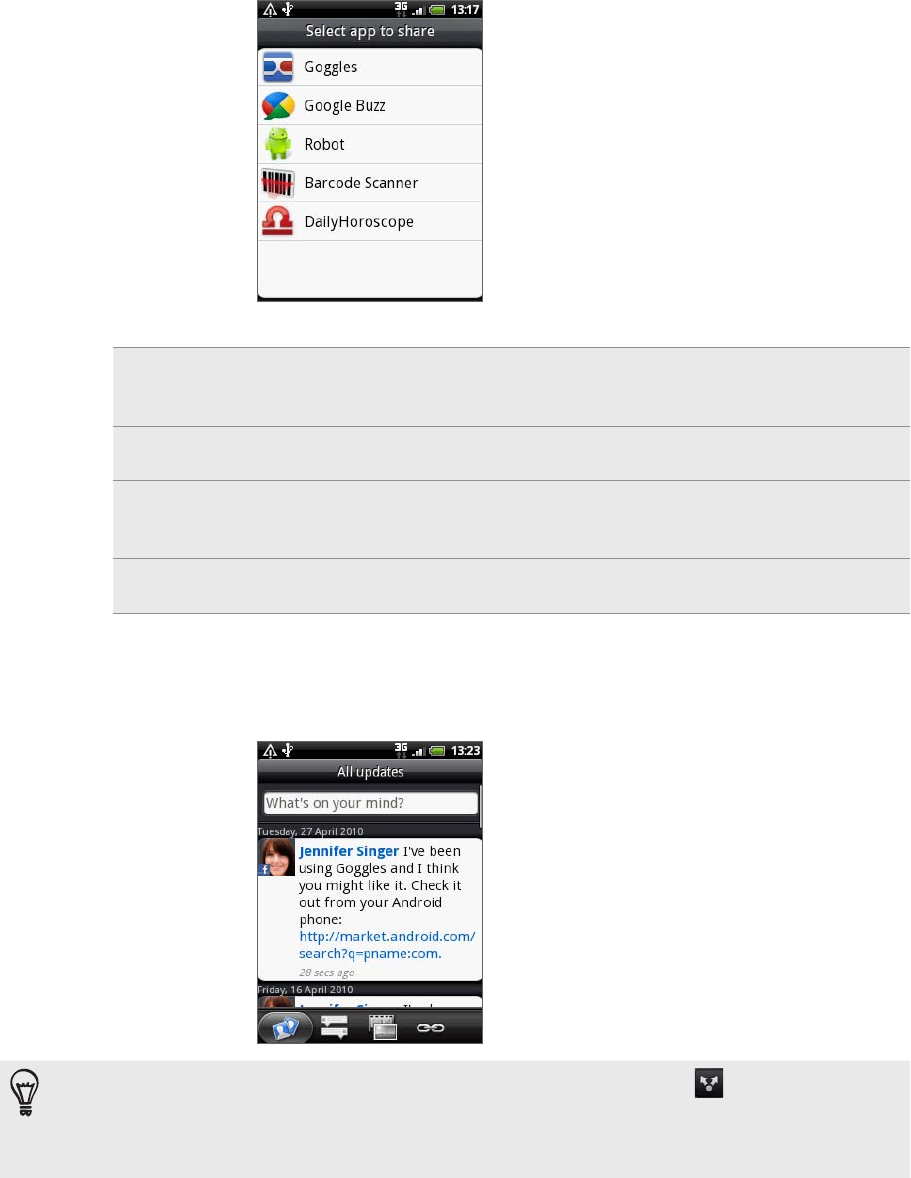
187 More apps
3. Tap an application, and then choose how to share it:
Peep Share the link in Twitter.
To find out how to use Peep, see “Tweeting on your phone“ in
the Social chapter.
Friend Stream Post the link to Facebook and Twitter.
See “Using Friend Stream“ in the Social chapter.
Mail Send the link using your POP3/IMAP or Exchange ActiveSync
email account.
See “Using Mail” in the Email chapter.
Message Send the link in a text message.
See the Messages chapter.
When your friends see the link in your sent text, email, or status update, they can
simply tap the link to go directly to the game or application in Android Market to
download it.
While entering your status update in Friend Stream, you can also tap to choose from
games or applications that you want to share in your social networks.
If you’ve already created a new text or email message, press MENU and then tap Attach >
App recommendation to choose from your list of installed games and applications.
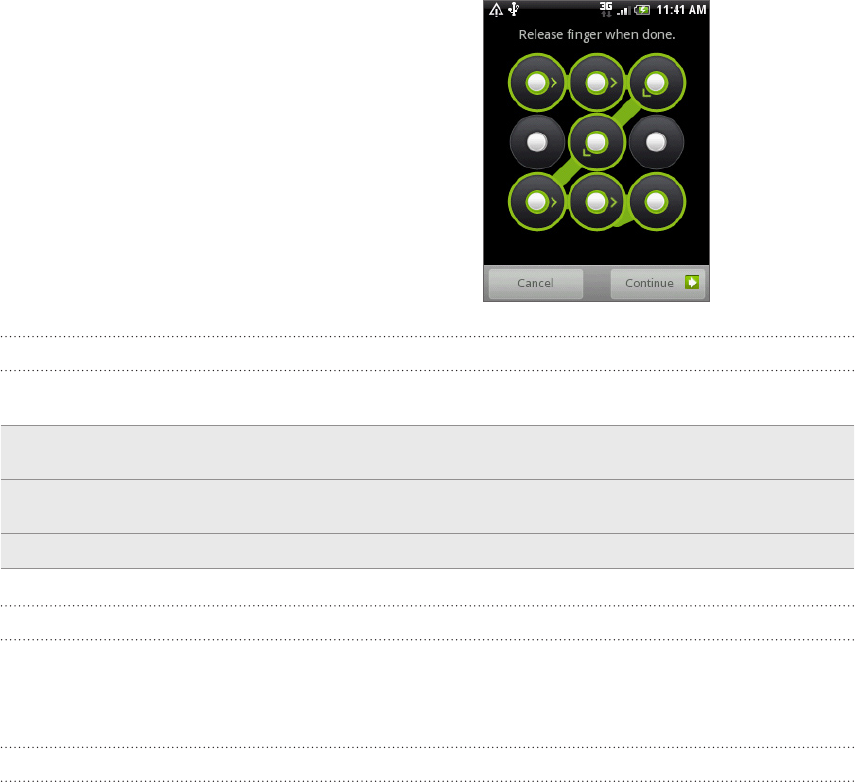
188 Security
Security
Protecting your phone with a screen unlock
pattern
You can secure your phone by requiring a screen unlock pattern every time your
phone is turned on or every time it wakes up from sleep mode (screen is off).
From the Home screen,
press MENU, and then tap
Settings.
Scroll down the screen,
and then tap Security > Set
unlock pattern.
Follow the onscreen
instructions. When
prompted, record your
screen unlock pattern.
1.
2.
3.
Changing unlock pattern settings
Under Screen unlock pattern on the Security screen, you’ll find this group of settings:
Require pattern Clear this check box if you want to disable the screen unlock pattern.
You’ll be asked to enter your unlock pattern to confirm disabling it.
Use visible pattern This is selected by default. Clear this check box if you do not want the
screen unlock pattern to display as you enter it.
Use tactile feedback Select this to enable vibration as you enter the screen unlock pattern.
Changing your screen unlock pattern
From the Home screen, press MENU.
Tap Settings > Security > Change unlock pattern.
Forgot your screen unlock pattern?
If you’ve forgotten your screen unlock pattern, you have up to five attempts to try and
unlock your phone. If this fails, you can unlock your phone by entering your Google
Account user name and password.
On the unlock screen, enter your unlock pattern.
After the fifth attempt and you’re asked to wait for 30 seconds, tap OK.
If the display goes off, press the POWER button to turn the display back on, and
1.
2.
1.
2.
3.
189 Security
then press the bar on the lock screen and slide your finger down to unlock the
screen.
Tap the Forgot pattern button in the lower right corner when it appears.
Enter your Google Account name and password, and then tap Sign in.
You’ll then be asked to create a new screen unlock pattern. If you no longer want to do
so, tap Cancel.
4.
5.

190 Settings
Settings
Settings on your phone
Control and customize phone settings on the Settings screen.
Froom the Home screen, press MENU, and then tap Settings.
Personalize Select a scene, set the Home screen or Lockscreen wallpaper
to use, and set the default ringtone to use for incoming calls.
You can also rename or delete a custom scene by pressing and
holding a custom scene in Scenes.
Wireless & networks Configure your phone’s wireless connections, such as Wi-Fi
and Bluetooth, enable the Airplane mode, or set the options for
mobile networks, roaming, Virtual Private Networks, and more.
Call Set up call services such as voicemail, call forwarding, call
waiting, and caller ID.
Sound & display Choose sounds to use for your phone ringtone and
notifications.
Adjust media playback volume. See “Adjusting the volume”
in the Getting started chapter.
Turn on or off sound and vibrate features such as Audible
touch tones, Haptic feedback, Quiet ring on pickup, and
more.
Configure display settings such as automatic screen
orientation, brightness, screen timeout, and more.
Accounts & sync Log in or out of your social network accounts, Google Account,
and Exchange ActiveSync account. You can also manage
synchronization and other settings for your accounts. See the
Accounts and sync chapter for details.
Location Select the sources to use when determining your location.
Search Select items to include when you do a search on your phone
and set Google search options.
Privacy Choose whether to allow or block Google from using your
location when suggesting results and for other Google
services.
You can also do a factory reset. See the Update and reset
chapter for more details.
Connect to PC Set the default USB connection type to use whenever you
connect your phone to your computer.
Or, select the Ask me check box to set your phone to always
display the screen for selecting the USB connection type. To
find out more, see “Connecting your phone to a computer”
in the Getting started chapter.
Security Set the screen unlock pattern or manage the phone’s credential
storage. See the Security chapter for details.
Applications Manage applications and installation of new programs.

191 Settings
SD & phone storage Check the available storage card and phone memory.
From this screen, be sure to unmount your microSD card
before you remove it from your phone.
Date & time Set the date and time, time zone, and date or time format. To
turn off auto time synchronization and be able to manually
change time zone settings, see “Setting the time zone, date,
and time” in the Clock and Weather chapter.
Language & keyboard Set the operating system language and region. You can also set
onscreen keyboard options.
Accessibility This option appears only after you’ve downloaded and installed
an accessibility tool, such as a screen reader that provides
voice feedback. You can turn accessibility functions or services
on or off.
Text-to-speech If you have installed a text-to-speech (voice data) application,
use this option to configure the text-to-speech settings.
About phone Turn on or off scheduled checks for system software
updates, or manually check for updates.
View different information about your phone, such as the
mobile network type, signal strength, battery level, battery
use of individual applications, software version of your
phone, and more. See “Checking information about your
phone” in this chapter.
Changing display settings
Adjusting the screen brightness manually
From the Home screen, press MENU, and then tap Settings > Sound & display.
Scroll down the screen, and then tap Brightness.
Clear the Automatic brightness check box.
Drag the brightness slider to the left to decrease or to the right to increase the
screen brightness. Tap OK.
Adjusting the time before the screen turns off
After a period of inactivity, the phone screen turns off to conserve battery power. You
can set the idle time before the screen turns off.
From the Home screen, press MENU, then tap Settings > Sound & display.
Scroll down the screen, and then tap Screen timeout.
Tap the time before the screen turns off.
Turning automatic screen rotation off
By default, the screen orientation automatically adjusts depending on how you hold
the phone.
Not all application screens support automatic rotation.
1.
2.
3.
4.
1.
2.
3.

192 Settings
From the Home screen, press MENU, then tap Settings > Sound & display.
Scroll down the screen, and then clear the Orientation check box.
Recalibrating the G-sensor
Recalibrate the screen if you feel that the screen orientation does not respond
properly to the way you hold the phone.
From the Home screen, press MENU, then tap Settings > Sound & display.
Scroll down the screen, and then tap G-Sensor calibration.
Place the phone on a flat and level surface, and then tap Calibrate.
After the recalibration process, tap OK.
Keeping the screen on while charging the phone
You can keep the phone screen from turning off while you are charging the phone.
From the Home screen, press MENU, then tap Settings.
Scroll down the screen, and then tap Applications > Development.
Select the Stay awake check box.
Switching animation effects on or off
You can turn off the animation or enable only some animations when switching
between screens.
From the Home screen, press MENU, and then tap Settings > Sound & display.
Scroll down the screen, and then tap Animation.
On the options menu, select the animation setting you want.
Changing sound settings
Switching between silent, vibration, and normal modes
To quickly switch between silent and vibration modes, simply press and hold
the POWER button, and then choose the mode that you want.
To change back from silent to normal mode , simply press the VOLUME UP
button.
To change back from vibration to normal mode , press the VOLUME UP
button twice.
From the Home screen, press MENU, and then tap Settings > Sound & display
> Sound profile.
You can also add the Profile widget to your Home screen. To find out how
to add a widget, see “Personalizing your Home screen with widgets” in the
Personalizing chapter.
1.
2.
1.
2.
3.
4.
1.
2.
3.
1.
2.
3.

193 Settings
Enabling or disabling audible selection
You can choose to play a sound when you are selecting items onscreen.
From the Home screen, press MENU, and then tap Settings > Sound & display.
Scroll down the screen, and then select the Audible selection check box.
Choosing the notification sound
You can choose a default sound for your phone to play whenever there are new
notifications.
From the Home screen, press MENU, and then tap Settings > Sound & display >
Notification sound.
Select your preferred notification sound in the list, and then tap OK.
To use different sounds for different types of notifications, set the notification sounds
in the respective applications. For example, to set different sounds for received
and sent text messages, open the Messages application, then press MENU and tap
Settings.
Turning on or off automatic ring volume adjustment
Quiet ring on pickup
Your phone has a quiet ring feature that automatically lowers the ring volume
whenever you move or lift up your phone.
You can turn this feature on or off in your sound settings.
From the Home screen, press MENU, and then tap Settings > Sound & display.
Scroll down the screen, and then select or clear the Quiet ring on pickup check
box.
Changing the phone language
When you turn your phone on for the first time, you’re asked to choose the language
you would like to use for your phone. You can also change the language on the fly
whenever you like. Changing the language adjusts the keyboard layout, date and time
formatting, and more.
The languages available to choose from may depend on the version of phone you
have.
From the Home screen, press MENU, and then tap Settings > Language &
keyboard > Select locale.
Tap the language and corresponding region you want to use.
Press HOME to return to the Home screen. You may need to wait briefly as the
new language is applied to your phone.
1.
2.
1.
2.
1.
2.
1.
2.
3.

194 Settings
Optimizing your phone’s battery life
When you’re on the go, it’s not always easy to charge your phone’s battery as often as
you’d like. Follow these tips to extend the time between charges:
Turn off wireless functions such as Bluetooth, Wi-Fi, and data connection
when you’re not using them. See the Internet connections and Bluetooth
chapters for details.
Use GSM networks. See “Using the GSM network of your mobile operator” in
this chapter for details.
Do not use GPS satellites to determine your GPS location. See the Maps and
location chapter for details.
Lower the screen brightness. See “Adjusting the screen brightness manually”
in this chapter for details.
Switch off screen animations. See “Switching animation effects on or off” in
this chapter for details
Cut down on activities such as Internet browsing. Wireless data consumes a
lot of power.
Avoid making very long phone calls or using the camera for extended periods
of time.
Consider carrying a spare battery for times when you can’t charge your
battery for an extended period.
Batteries gradually lose storage capacity over time. Consider replacing your
battery after eight months to a year, or if you notice that the battery life is
decreasing.
Using the GSM network of your mobile operator
Switch to using the GSM network of your mobile operator if you are not using a data
connection to connect to the Internet. Connecting to your mobile operator’s GSM
network consumes less battery power.
From the Home screen, press MENU, and then tap Settings > Wireless &
networks.
Scroll down the screen, and then tap Mobile networks > Network mode.
Tap GSM only.
Checking the power usage of applications
From the Home screen, press MENU, and then tap Settings.
Scroll down the screen, and then tap About phone > Battery > Battery use.
1.
2.
3.
1.
2.
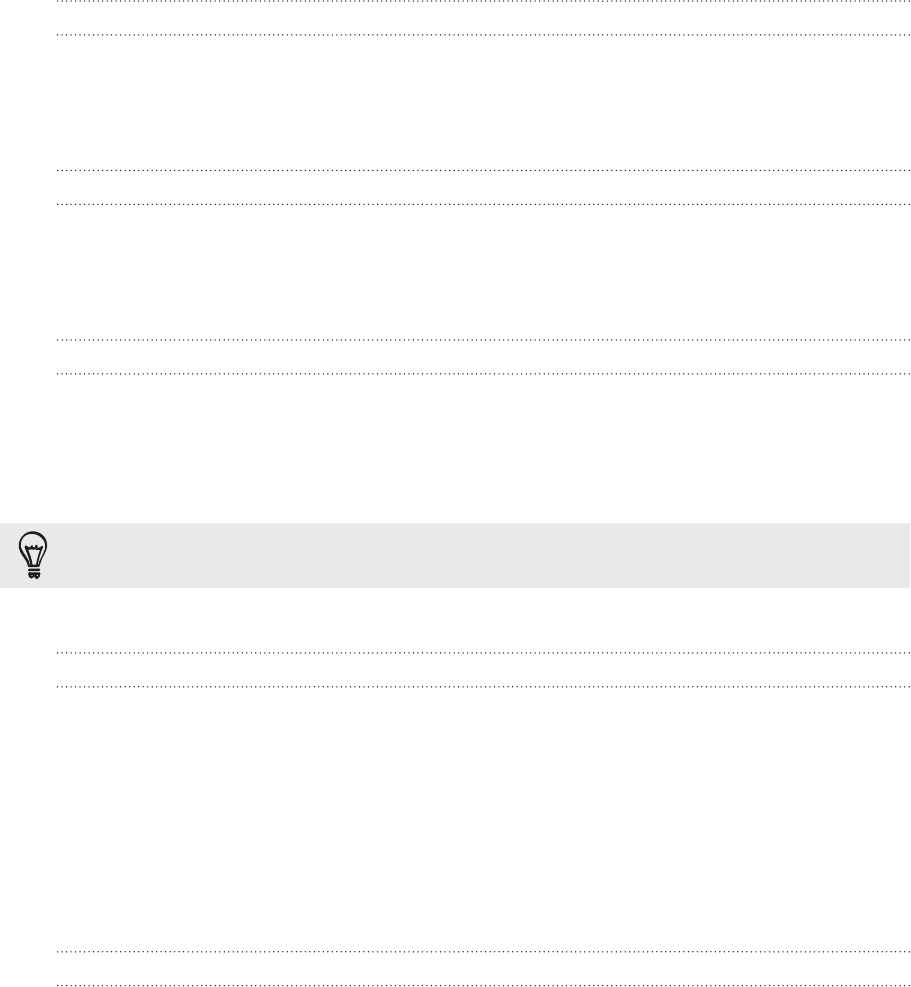
195 Settings
Managing memory
Checking how much phone memory is available for use
From the Home screen, press MENU, and then tap Settings.
Scroll down the screen, and then tap SD & phone storage. The available phone
memory is displayed in the Internal phone storage section.
Checking the available storage card space
From the Home screen, press MENU, and then tap Settings.
Scroll down the screen, and then tap SD & phone storage. The total and available
storage card space is displayed in the SD card section.
Clearing application cache and data
From the Home screen, press MENU, and then tap Settings.
Scroll down the screen, and then tap Applications > Manage applications.
On the Manage applications screen, tap the application whose cache and/or
data you want to delete.
Press MENU to bring up sort and filter options.
4. In the Application info screen, tap Clear data and/or Clear cache.
Uninstalling third-party applications
You cannot uninstall applications that are preinstalled on the phone.
From the Home screen, press MENU, and then tap Settings.
Scroll down the screen, and then tap Applications > Manage applications.
Press MENU, and then tap Filter > Downloaded.
On the Manage applications screen, tap the application you want to uninstall.
On the Application info screen, tap Uninstall.
Freeing up more phone memory or storage card space
If your phone is running low on memory, try the following:
In your web browser, clear all temporary Internet files and history information.
See the Web browser chapter for more information.
Uninstall downloaded programs from Android Market you no longer use. See
“Finding and installing apps from Android Market “ in the More apps chapter
for details.
1.
2.
1.
2.
1.
2.
3.
1.
2.
3.
4.
5.

196 Settings
Checking information about your phone
From the Home screen, press MENU, and then tap Settings.
Scroll down the screen, and then tap About phone.
Select one of the following:
System software updates Enable or disable the automatic check feature for software
updates for your phone. You can also tap Check now to
manually check for software updates.
Network Check information about your mobile operator and its
service status.
Phone identity Check information about your phone model and mobile
number.
Battery Check information about the battery such as its current
battery level, status, and what programs are using the
battery.
Hardware information Check the Wi-Fi MAC and Bluetooth addresses.
Software information Check the version and other information about the
Android platform being used by the phone. You can also
check the version of the web browser.
Legal information Read legal information from HTC and Google, and licenses
used by the phone.
Learn more Provides the link to the HTC website so you can learn
more about your phone.
1.
2.
3.

197 Update and reset
Update and reset
Updating the phone software
From time to time, software updates for your phone may be available. Your phone can
check and then notify you if there’s a new update. You can then download and install
the software update using your phone’s Wi-Fi or data connection.
Checking and downloading phone software updates may incur additional data transfer fees
from your mobile operator.
Make sure you have your microSD card on your phone. The update will be downloaded to
the microSD card.
Depending on the type of update, the update may erase all your personal data and
customized settings, and also remove any applications you have installed. Make sure
that you have backed up the information and files you want to keep.
When there is an update available, the Install system software update dialog
box will appear onscreen. Select Install now and then tap OK.
If you’re in the middle of a call and there’s an update available, you’ll receive
an update notification. After you end the call, slide open the Notifications
panel (see “Opening the Notifications panel” in the Getting started chapter).
Then tap the update notification to download and install the software update.
Wait for the update process to finish. When the update is finished, the phone will
automatically reset.
Checking for phone system software updates manually
From the Home screen, press MENU, and then tap Settings.
Scroll down the screen, and then tap About phone > System software updates.
On the System software update screen, tap Check now.
1.
2.
3.

198 Update and reset
Restarting or factory resetting your phone
If your phone becomes unresponsive or sluggish, try restarting your phone and see if
that helps. In case your phone has a persistent problem that cannot be solved, the last
resort is to do a factory reset.
Restarting your phone (soft reset)
If your phone is running slower than normal, an application is not performing properly,
or your phone becomes unresponsive, try restarting your phone and see if that helps
solve the problem.
To restart your phone, simply turn it off and back on. If pressing and holding the
POWER button doesn’t work, then remove the battery, wait for a few seconds, reinsert
the battery, and then turn the phone on.
Performing a factory reset (hard reset)
If you’re passing your phone on to someone else or your phone has a persistent
problem that cannot be solved, you can do a factory reset (also called a hard reset).
This returns your phone to the state it was in before the first time you turned it on.
Factory reset will not remove the data and files that are in your phone’s microSD card.
Factory reset is not a step to be taken lightly. It will permanently delete all your data
and customized settings, and will also remove any applications you’ve downloaded
and installed. Be sure to back up any data and files you want to keep before you do a
factory reset.
Performing a factory reset via settings
The most convenient way to do a factory reset is via the phone settings.
From the Home screen, press MENU, then tap Settings.
Scroll down the screen, and then tap Privacy > Factory data reset.
On the Factory data reset screen, tap Reset phone, and then tap Erase
everything.
Performing a factory reset using phone buttons
If you cannot turn on your phone or access the phone settings, you can still perform a
factory reset by using the buttons on the phone.
With the phone turned off, press and hold the VOLUME DOWN button, and then
briefly press the POWER button.
Wait for the screen with the three Android images to appear, and then release
the VOLUME DOWN button.
Press VOLUME DOWN to select CLEAR STORAGE, and then press POWER.
Press VOLUME UP to start the factory reset.
1.
2.
3.
1.
2.
3.
4.

199 Specifications HTC Desire User Guide
Specifications
CPU speed 528 MHz
Platform Android™ with HTC Sense™
Memory ROM: 512 MB
RAM: 384 MB
Dimensions (LxWxT) 116.85 x 61 x 11.99 mm (4.6 x 2.4 x 0.47 inches)
Weight ??? grams (??? ounces) with battery
Display 3.2-inch touch-sensitive screen with 240 x 320 QVGA resolution
Network Dual-band (800 and 1900 MHz)
CDMA2000 1xRTT/1xEVDO/1xEVDO rev. A and IS-95A/B voice or
data with up to 1.8 Mbps upload and 3.1 Mbps download speeds
(Band frequency and data speed are operator dependent.)
Onscreen navigation Optical trackball
GPS Internal GPS antenna
Sensors G-Sensor
Digital compass
Proximity sensor
Ambient light sensor
Connectivity Bluetooth® 2.1 with FTP/OPP for file transfer, A2DP for wireless
stereo headsets, and PBAP for phonebook access from the car kit
Wi-Fi®: IEEE 802.11 b/g/n
3.5 mm stereo audio jack
Standard micro-USB (5-pin micro-USB 2.0)
Camera 5 megapixel color camera with auto focus and flash
Audio supported
formats
Playback: .aac, .amr, .ogg, .m4a, .mid, .mp3, .wav, .
wma (Windows Media Audio 9)
Recording: .amr
Video supported
formats
Playback: .3gp, .3g2, .mp4, .wmv (Windows Media Video 9)
Recording: .3gp
Battery Rechargeable Lithium-ion battery
Capacity: 1300 mAh
Talk time: Up to 402 minutes
Standby time: Up to 300 hours
(The above are subject to network and phone usage.)
Expansion slot microSD™ memory card (SD 2.0 compatible)
AC adapter Voltage range/frequency: 100 ~ 240V AC, 50/60 Hz
DC output: 5V and 1A
Special features Friend Stream, App Sharing
A Standby time specification (“specification”) is an industry standard that is only intended to allow
comparison of different mobile phones under the same circumstances. Power consumption in a
standby state is strongly dependent on factors including but not limited to network, settings, location,
movement, signal strength and cell traffic. Comparisons of different mobile phones using such a
specification can therefore only be done in a controlled laboratory environment. When using any mobile
phone in real life circumstances for which the mobile phone is intended, the standby time could be
considerably lower and will be strongly dependent on the factors as mentioned above.
Specifications are subject to change without prior notice.

200 Index
Index
Symbols
3G 111
A
Access point 111
Adding a city to the Weather screen 109
Adding a city to the World Clock screen
107
Adding a new contact 51
Adding application icons and other
shortcuts on your Home screen 34
Adding a widget to your Home screen 33
Adding folders on your Home screen 35
Adjusting the volume 27
Airplane mode 46
Alarm clock 107
Album (Galleries application) 135
Android Market 169
Answering or rejecting an incoming call
40
App Sharing 171
Audio supported formats 184
Auto focusing 131
B
Back cover 12
Backing up your contacts to the storage
card 53
Battery 14
- optimizing 179
Battery times 184
Bluetooth
- changing the phone name 124
- connecting headset or car kit 124
- receiving information 127
- sending information 126
- sending photos or videos 139
- turning on or o 124
Bookmarks 122
Browser 116
C
Calendar 96
Calendar widget 103
Caller ID 40, 41
Call history 44
Call services 46
Camera 130
Capturing video 133
Changing your wallpaper 32
Charging the battery 15
Chatting in Google Talk 80
Checking information about your phone
181
Checking weather 109
Clock 104
Clock widget (HTC) 104
Commenting photos in your social
networks 142
Conference call 42
Connecting your phone to a computer 28
Contact groups 55
Contacts 47, 50, 56
Copying files to or from the storage card
29
Copying text 120
Creating a calendar event 96
Creating a playlist 144
Cropping a photo 138
Customizing and saving a scene 32
D
Data connection 111
Date and time 106
Deleting a scene 32
Deleting contacts 53
Desk Clock 105
Downloading HTC widgets 33
E
Editing a contact’s information 53
Email 83
- sending photos or videos 139

201 Index
Ending a call 43
Event reminders 100
Exchange ActiveSync 89, 94
Extended Home screen 19
F
Facebook
- commenting photos 142
- sharing photos 140
- view photos 142
Facebook for HTC Sense 75
Factory reset 183
Finger gestures 24
Flash (camera) 132
Flashlight 168
Flickr
- commenting photos 142
- sharing 140
- viewing photos 142
FM Radio 163
Folders 35
Footprints 156
Friend Stream 76
Friend Stream widget 77
G
G-sensor 177
Gallery 135
Gmail/Google Mail 83
Google Accounts 73
Google Dictionary 121
Google Latitude 154
Google Maps 148
Google News 166
Google Talk 80
Google Translate 121
Groups 55
H
Home city 106
Home page 116
Home screen 19
Home wallpaper 32
HTC Caller ID 41
HTC Clock widget 104
HTC Footprints 156
HTC Sync 74
I
Importing a contact from an Exchange
ActiveSync account 51
Importing contacts from the storage card
53
Inserting the storage card 16
Internet connections 111
Inviting guests to your event (Google
Account only) 97
K
Keyboard 60
L
Latitude 154
Leap view 19
Library (Music) 144
Linking contact information 52
Listening to FM radio 163
Location services 148
Lock screen wallpaper 32
M
Mail application
- about 89
- deleting 84, 92
- Exchange ActiveSync 89, 94
- POP3/IMAP account 89
- sending 85, 92
- settings 88, 95
Making an emergency call 39
Making calls 37
Managing memory 180
Maps 148
Meeting request 94, 97
Memory 180, 184
Merging contact information 52
Messages 64
microSD card 16
Microsoft Exchange ActiveSync 89
Missed call 44
MMS 64, 65, 68, 70
Mobile network connection 111
Mobile network sharing 28
Modem 115
MP3 146
Multimedia message 64, 65, 68, 70

202 Index
Music application 143
Music widget 147
Muting the microphone 43
N
News feeds 166
Notification icons 22
Notification LED 23
Notification sound 178
Notifications panel 23
O
Onscreen keyboard 60
Optical trackball 25
Optimizing your phone’s battery life 179
P
PDF Viewer 160
Peep 78
People
- about 47
- contact groups 55
- contact information and conversations
56
- People screen 49
- People widget 58
Personalizing 31
Phone
- front, top, left, and back panels 10
- phone dialer 37
Photo capture 132
Photos 136
Picasa 141
Playing music 143
Playlist 144
POP3/IMAP 89
Powering on or off 17
Predictive text 62
Protecting your phone with a screen
unlock pattern 174
PUK 173
Push messages 68
Putting a call on hold 42
Q
Quickoffice 161
Quick Search Box 29
Quiet ring on pickup 178
R
Reading news feeds 166
Rearranging or removing widgets and
icons on your Home screen 36
Recalibrating the G-sensor 177
Recording your voice 165
Rejecting an incoming call 40
Removing the back cover 12
Removing the battery 15
Removing the storage card 16
Removing the thin film from the battery 14
Renaming a scene 32
Replacing the back cover 12
Restarting 183
Review screen (Camera) 130
Ringtone 145, 146
Rotating and saving a photo 138
S
Scenes 31
Screen unlock pattern 174
Searching for a contact 53
Searching within an application 30
Searching your phone and the Web 29
Selecting text 120
Sending a meeting request using Calendar
(Exchange ActiveSync only) 97
Sending a multimedia message (MMS) 65
Sending a photo or video by MMS 139
Sending a text message (SMS) 64
Sending a vCalendar 103
Sending contact information 54
Sending music using Bluetooth 147
Sending photos or videos by email 139
Sending photos or videos using Bluetooth
139
Setting a song as ringtone 145
Settings 175
- alarm sound 108
- calendar 102
- camera 133
- date and time 106
- weather 110
Setting up My contact card 49
Setting up your phone for the first time 18

203 Index
Sharing
- games and applications 171
- YouTube 160
Sharing photos on Facebook 140
Sharing photos on Flickr 140
Sharing photos on Picasa 141
Sharing videos on YouTube 141
Shortcuts 34
Sleep mode 20
Slideshow 66
SMS 64, 70
Social network accounts 72
Sound volume 27
Speakerphone 43
Specifications 184
Speed dial 38
Status icons 21
Stocks 162
Stopwatch 104
Storage 180
Storage card 16, 29
Street view 150
Switching between calls 42
Switching your phone on or off 17
Sync with online accounts 72
T
Taking a photo 132
Talk 80
Tethering 115
Text message 64, 70
Timer 104
Time zone 106
Touch input settings 63
Trimming an MP3 ringtone 146
Turning your phone on or off 17
Tweeting on your phone 78
Twitter 78
Twitter widget 79
U
Uninstalling third-party applications 180
Updates and events 57
Updating the phone software 182
Using your phone as a modem 115
V
vCalendar 103
Video capture 133
Videos 136, 159
Video supported formats 184
Viewfinder screen (Camera) 130
Viewing a PDF 160
Viewing photos and videos 136
Viewing photos on Facebook 142
Viewing photos on Flickr 142
Voice Recorder 165
Volume 27
VPN 114
W
Wallpaper 32
Weather 109
Weather widget 110
Web browser 116
Wi-Fi 112
Widgets 33, 36, 163, 164, 167
World Clock 106
Y
YouTube 141, 159
Z
Zooming (camera) 131
Zooming in or out on a photo 137